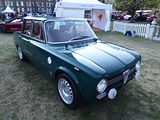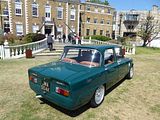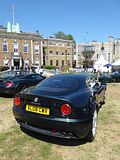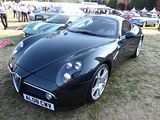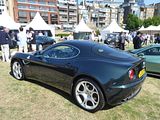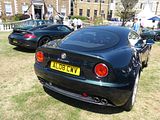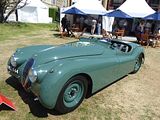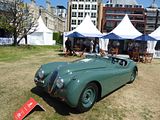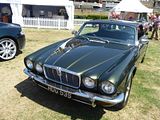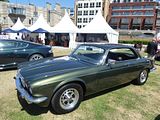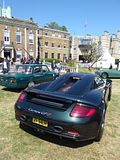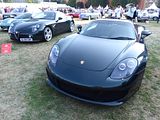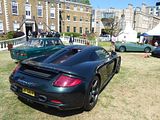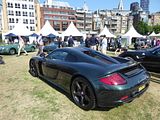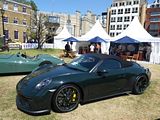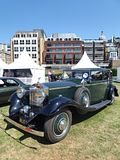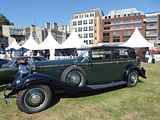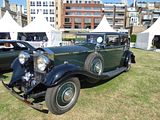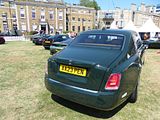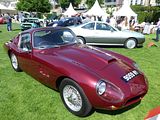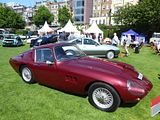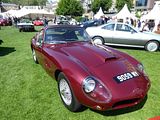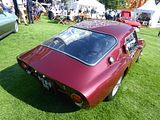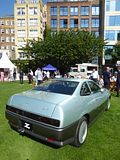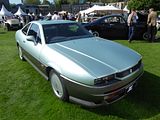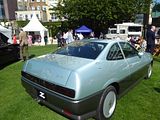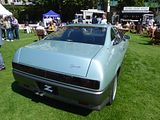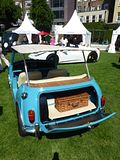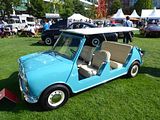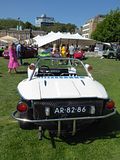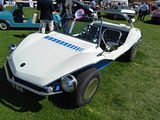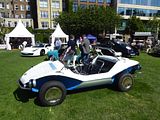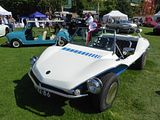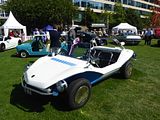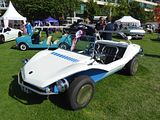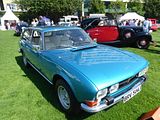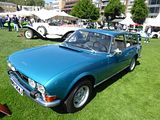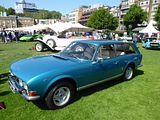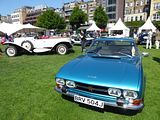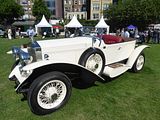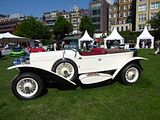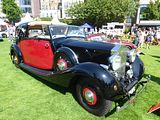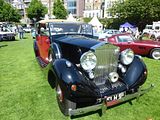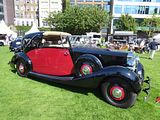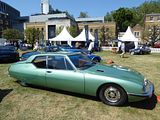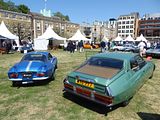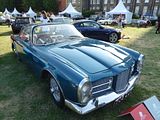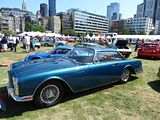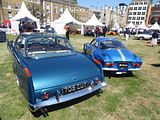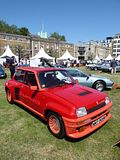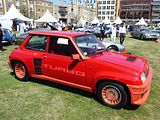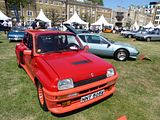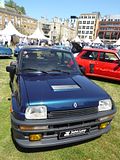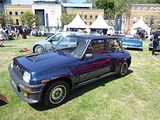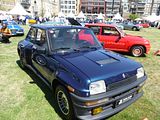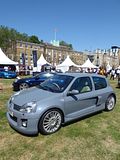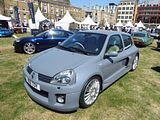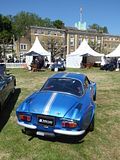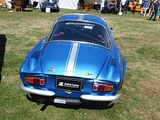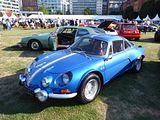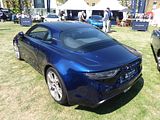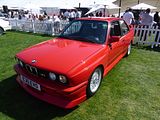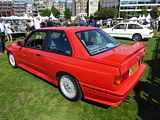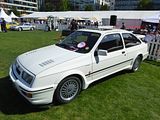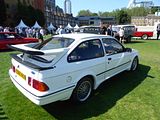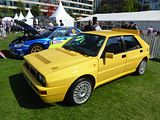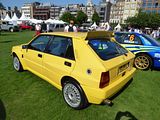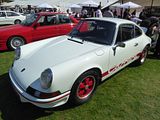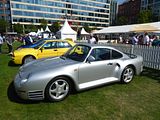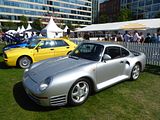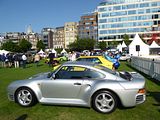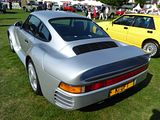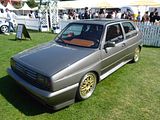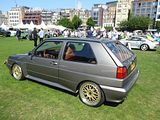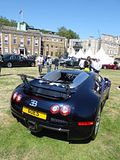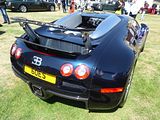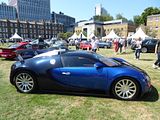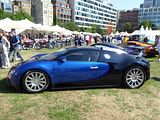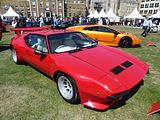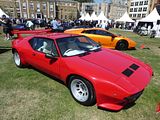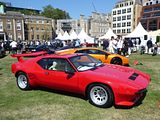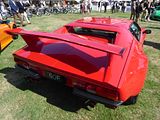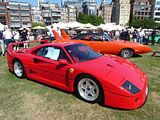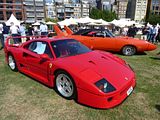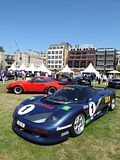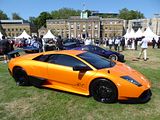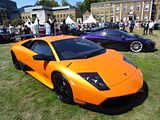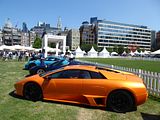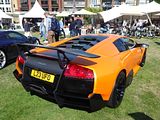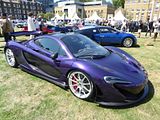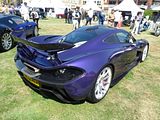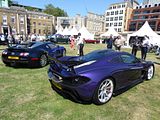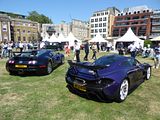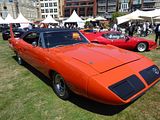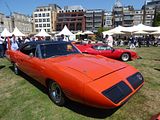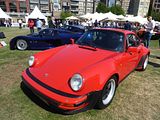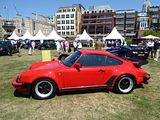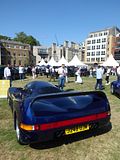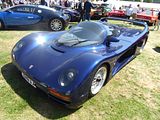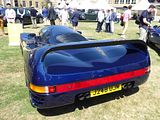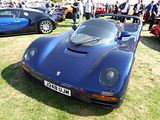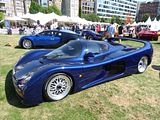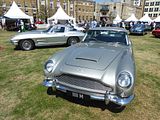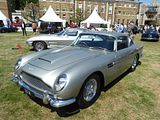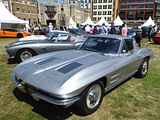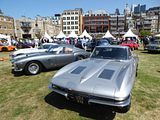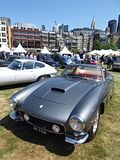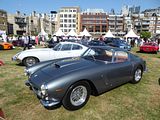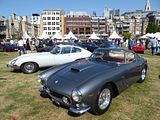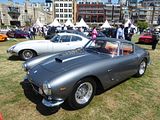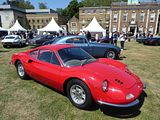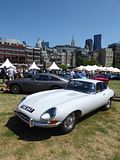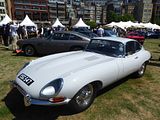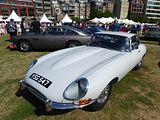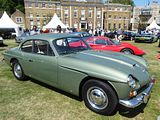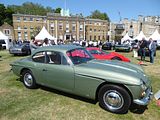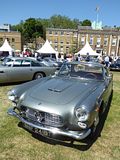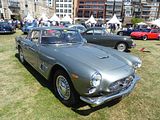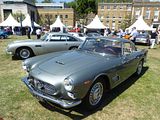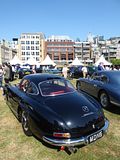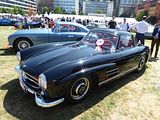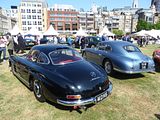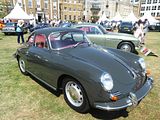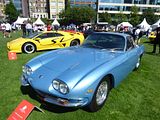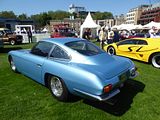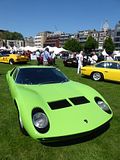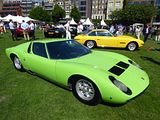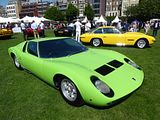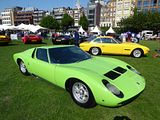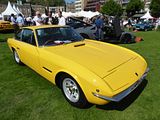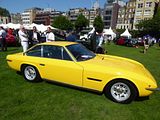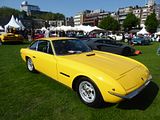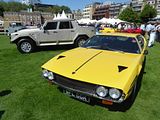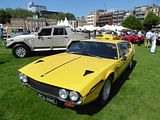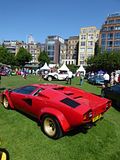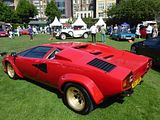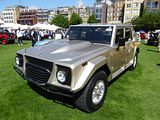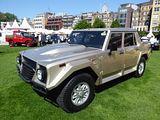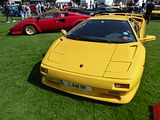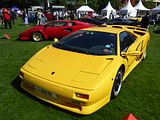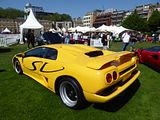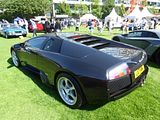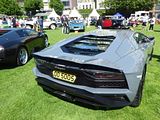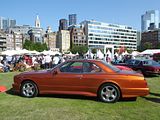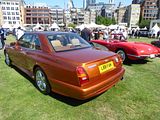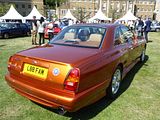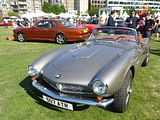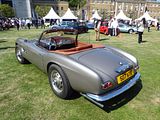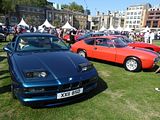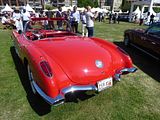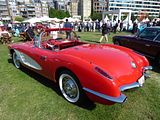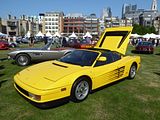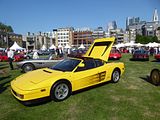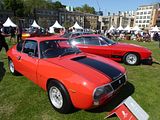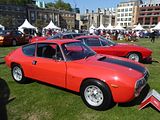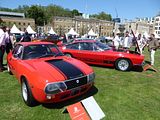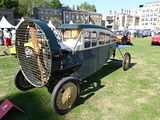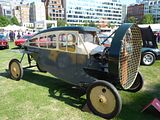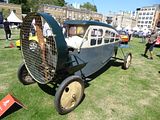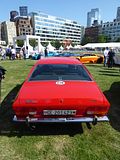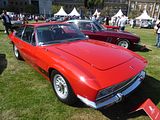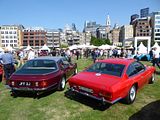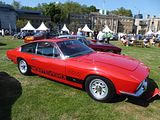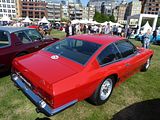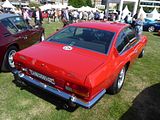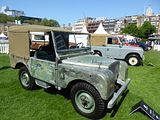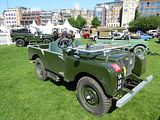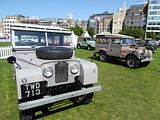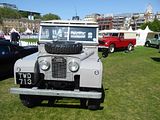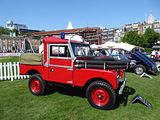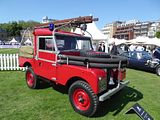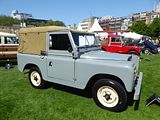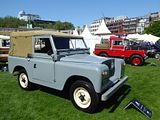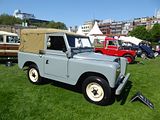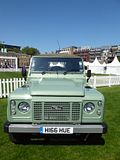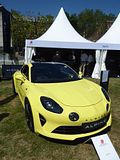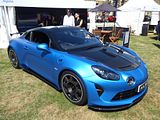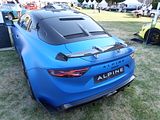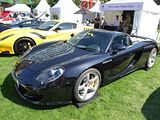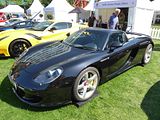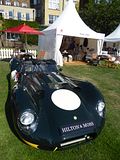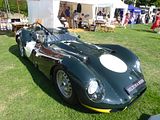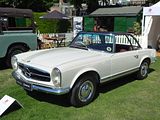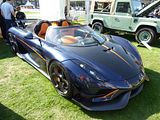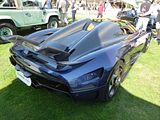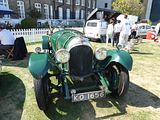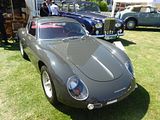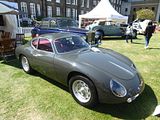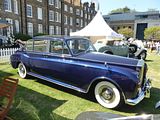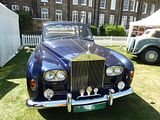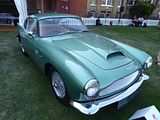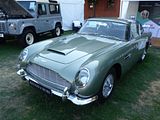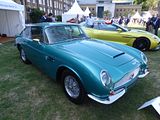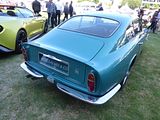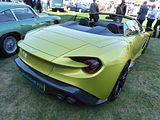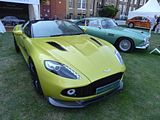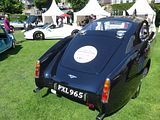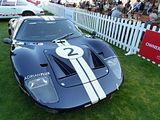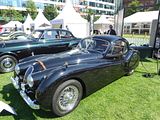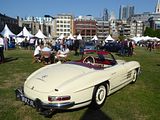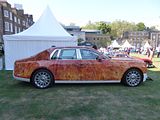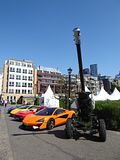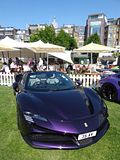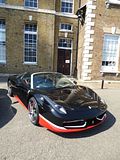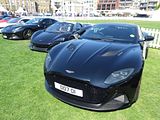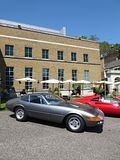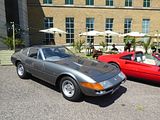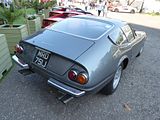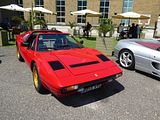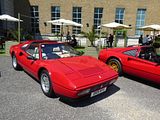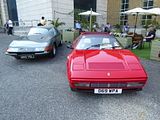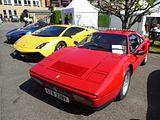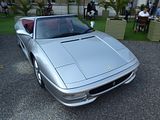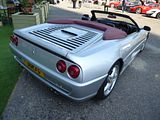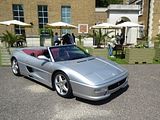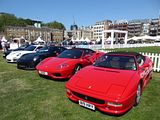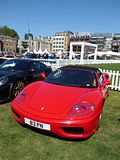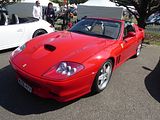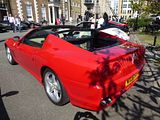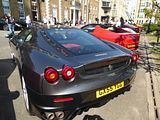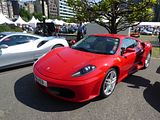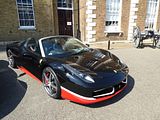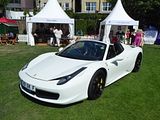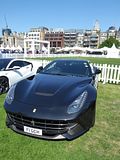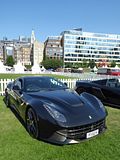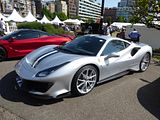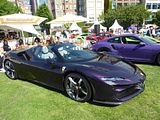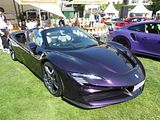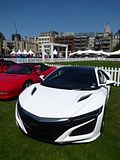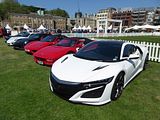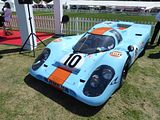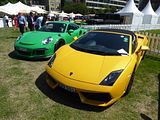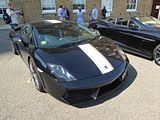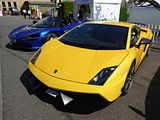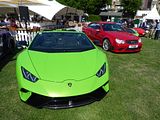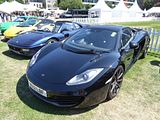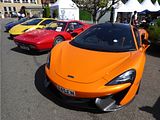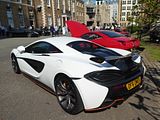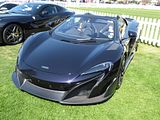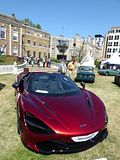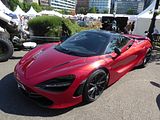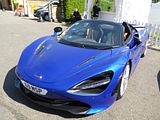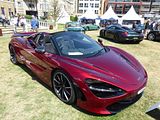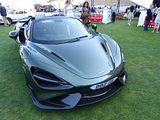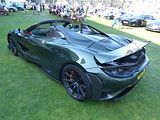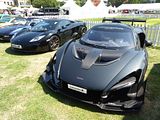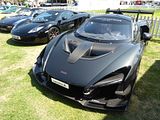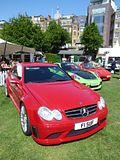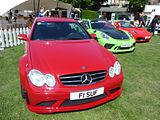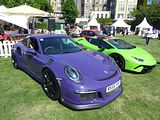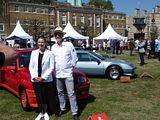Now firmly established not just in the UK events listing, but also having gained recognition on the global stage for the quality of its content, the London Concours has become one of those “unmissable” events for those who love to see a carefully curated display of high-end supercars, exotica and some rare treasures from the automotive back catalogue. It’s been held for seven years now, and I’ve been lucky enough to attend all bar the first couple. The venue is the Royal Artillery Company, which is easy to get to (by public transport, at least), being a short walk from either Moorgate or Old Street tube stations. There’s no evidence from the main road of what you will find, but when you pass down a narrow approach path that this will open to a sizeable area with the buildings to the north of the site and large grassy area which contains a cricket square at its centre. It’s the perfect central London location for a display of priceless cars. Unlike most events, this one is held during the week, so attending it requires booking a day off work, something which my good friend Andy Convery and I were very happy to do once more in 2023 having enjoyed the 2021 and 2022 events so much. That we were able to take advantage of a “2 for 1” ticket offer from Classic and Sportscar magazine was an added bonus, making this a good value event.
As in previous years, the core of the event is a series of well-thought through categories with each containing between six to ten cars, which were displayed grouped together, mostly in a large circle per category. Some themes persist from year to year, but the details are always different and that means that so are the cars.
MAKE GREEN GREAT AGAIN
Inspired by the popular social media trend, ‘Make Green Great Again’, and curated by the creator of the original @makegreengreatagain page on Instagram, this class, presented by Bespoke Handling, was a celebration of the very best examples of special cars that dare to be different, specified in a wide range of unusual verdant hues. There were cars here that you much more usually seen painted in red, or silver, black or grey but this class revelled in he fact that you can specify other colours, including various shades of green, hence the name of the class, Making Green Great Again.
1972 Alfa Romeo Giulia 1300 Ti: This Giulia 1300Ti spend much of its life in Bergamo before moving to the Netherlands. It was then fitted with a 2.0 litre Twin Spark engine from an Alfa 75 and used as a rally car. It came to the UK three years ago and was fitted with lightweight suspension parts, a fast road limited slip diff and four pot brakes by The Light Car Company. It had its gearbox rebuilt. Auto Audio London did a retrim in Italian leather and alcantara and fitted a Morel stereo. Warren Heath Engineering’s motor rebuild with an Arrow crank, lightweight flywheel and new cams means that 220 bhp is now produced.
2009 Alfa Romeo 8C Competizione: Alfa’s 8C arrived like a bolt of lightning – the 2003 concept so beautiful that it enraptured the world and its maker was pretty much forced to build it. Designed under the direction of Wolfgang Egger and constructed by Maserati, the 8C uses a 4.7-litre crossplane V8 similar to that of the GranTurismo, pumping out a heady 444bhp. Although it shares similarities with the Maseratis of the era, the 8C is shorter and lighter, making extensive use of carbonfibre. It has a transaxle, and places the engine far back under the bonnet to keep the mass centralised – the result is perfect 50/50 weight distribution. This example is particularly beguiling in its special green paintwork.
2009 Aston Martin DBS: This is believed to be a unique specification of a Pentland Green exterior over a Parliament Green interior – so very much at home in this line-up. The DBS superseded the much-loved Vanquish as the Aston Martin flagship in 2008, taking the famed, naturally aspirated 5.9-litre V12 to 510bhp and 420lb ft, with inspiration from the thunderous DBR9 and DBRS9 GT racing cars of the time. The competition machines also informed the DBS’s dramatic styling, and the use of carbonfibre on the bonnet, boot, front wings and door-opening surrounds. The result is a car that can hit 62mph in 4.3 seconds and 192mph.
2019 Ferrari 488 Pista: This example of the ultimate road-going expression of the Ferrari 488, the Pista is finished in Verde Francesca, an entirely new Ferrari colour named by the owner of this very car. The Pista took aesthetic inspiration from the 488GTE and 488 Challenge racing cars. The biggest change came at the front end, which channels air through ducts in the bumper before directing it through a large vent in the bonnet. This helps to create more downforce over the nose at very high speeds. Such measures, as well as the use of underbody and rear diffusers, means the Pista creates 20 percent more downforce than the 488GTB. Meanwhile, the 3.9-litre twin-turbo V8 powerplant pushes out 710bhp at a screaming 8000rpm, in a car 91kg lighter than the GTB.
1953 Jaguar XK120: This is one of the last roadsters built in RHD. It was delivered, as a company car, to F Parham Ltd, in Gillingham, Kent in July 1953. The car was the personal transport of boss Leonard Francis Parham who, as a keen rally driver, also drove it competitively. After this, the XK passed through three subsequent owners, before being acquired in January 1968 by a young engineer, Douglas Potter. He achieved some success in the emerging XK Register racing series, but laid the car up for around 40 years. It has now undergone a full chassis-off restoration to FwIA specification.
1978 Jaguar XJC V12: this is a very special Jaguar XJC, owned by the founder of EVO magazine and star of the YouTube sensation Harry’s Garage, Harry Metcalfe. Harry bought the Jaguar in 2014, and set about improving the performance and handling by fitting lower, stiffer springs, new dampers and bushes, and a shorter diff to enhance acceleration through the gears. The car was thoroughly enjoyed before a two- year restoration was started in 2020. Its paint is bespoke to the car; it started out as Aston Martin Minotaur Green, but Harry chose not to have the bronze ‘flip’ element included, so he asked a technician at Novol (which provided the paint) to do a mix without the flip. It’s now resplendent, a wonderful example of this elegant, sporting British coupe.
2005 Porsche Carrera GTZ: The first example was commissioned in 2013, with revered Italian styling house Zagato tasked with creating a shapely, all-carbon Coupe body for the Carrera GT, which had been in production from 2003 to 2007. Zagato, known for their work with Aston Martin and Alfa Romeos, styled a carbon body that was more aerodynamic than the original Carrera GT’s, with a gradually raked coupe roofline featuring the signature Zagato double-bubble design motif. Zagato understandably saw no need to alter the Carrera GT’s mechanical recipe, keeping the howling, razor-sharp 5.7-litre V10, delightful manual gear shift and carbon chassis. The Zagato models are supremely rare; it is believed that just 6 of the 1,270 Carrera GTs have been converted to date. Originally supplied to the German market, in 2019 this example was sent by the current owner to famed coach builders Zagato in Italy – where it was converted into a GTZ with the fitment of new panels and bespoke trim. Zagato projects are typically produced with OEM blessing; the conversion is respectful to homologation requirements, and as such the car remains mechanically standard. However, the conversion does result in a slight weight saving. Finally, the unique paint colour was mixed to complement the green interior leather.
2019 Porsche 911 Speedster: At the 2018 Paris Motor Show held in October on the occasion of the 70th-anniversary celebration of the marque, Porsche unveiled the Speedster variant of the 991 generation for the 911, as a concept. Utilising the chassis of the GT3 and the body shell of the Carrera 4 Cabriolet, the Speedster includes the GT3’s 4.0-litre naturally aspirated Flat-6 engine generating a maximum power output of 500 PS (493 bhp) and having a red-line of 9,000 rpm coupled with a 6-speed manual transmission and titanium exhaust system which are claimed to be 4 kg (9 lb) lighter than the 7-speed manual transmission found on the standard 991 models. The car also features the signature “hump” shaped double-bubble roof cover along with a shorter windshield frame, side window glass and the analogue roof folding mechanism retaining the “Talbot” wing mirrors and the central fuel cap from the 911 Speedster concept unveiled earlier at the Goodwood Festival of Speed harking back to its use on the 356 Speedster. Other highlights include a leather interior with perforated seats, red tinted daytime running lights, carbon fibre fenders, engine cover and hood and stone guards. Production began in the first half of 2019 and be limited to 1,948 units in honour of the year in which the 356 “Number 1” gained its operating license. The final production version of the Speedster was unveiled at the 2019 New York Auto Show in April and dropped the “Talbot” wing mirrors in favour of standard 991 wing mirrors. The speedster was available for sale in May 2019. This particular Speedster is one of 5 or 6 UK-supplied Paint to Sample examples. Its hue, Brewster Green, was originally a Bentley colour.
1935 Rolls Royce Phantom II Sedanca de Ville: Presented by The Peninsula Hotels, this Phantom II was subject to a 7 year restoration by Thornley Kelham. It now has power steering, upgraded electrics and alternator, two batteries, extra fans and electronic ignition. Front and rear air con has been installed as well as a modern entertainment system and a refrigerator and cocktail cabinet. While the car has been modernised to deal with traffic, its original aesthetic has been retained wherever possible. It is set to be part of the classic car experience when The Peninsula London opens its doors.
2022 Rolls Royce Phantom VIII: Launched in 2017, the Phantom VIII carries on the tradition of leading the range thanks to opulent luxury and exquisite engineering. Powered by a 6.75 litre twin-turbo charged V12, the Phantom is available in two wheelbase lengths, based on an aluminium spaceframe chassis. The Phantom VIII is the first Rolls Royce to be fitted with four-wheel steering, which turns the rear tyres counter to the fronts through a maximum of three degrees at speeds lower than 37 mph, to improve manoeuvrability. At speeds more than 50 mph, the rear wheels turn in the same direction as the fronts through a maximum of one degree to provide better high speed stability. The Phantom seen here is one of two that has been customised inside and out for the new Peninsula London hotel.
BESPOKE AUTOMOTIVE
1961 Austin-Healey WSM: This is a very special Austin-Healey 3000 MK2 from 1961 turned into a sleek, aerodynamic coupe by British outfit WSM. It regularly competed in hill climbs and on track but came a cropper at Silverstone in 1964, hitting the new pit wall at Woodcote. The new closed body was then commissioned to replace the damaged open-top body. The metalwork was designed by Douglas Wilson-Spratt at Delta Garages and produced by Robert Peel Sheet Metal Works in Kingston, West London. While the results were stunning, adding the lightweight, slippery GT body to the Healey came at a significant cost, £1,476 to be precise, an eye watering sum at a time when a new Jaguar E-Type Coupe was priced at just over £2,000. This was the only WSM Healey built. The car was stolen from a London garage but eventually found undamaged in Hull. It was sold and then used as a rally car before being laid up in the early 1970s. The current owner has spent the past 12 years restoring the car and this is the first time it has been seen in pubic since the 1970s.
1995 Autech Gavia Zagato: An ultra-rare Japanese-Italian creation, this is the Zagato-built Autech Gavia. The Gavia was a joint venture between Nissan’s in-house tuning company Autech, and Italian design house Zagato – known for its eye-catchingly avant-garde designs. The car that will be on show this June was built in 1995, and features a 3.0-litre twin-turbo V6 motor, sourced from the Nissan 300ZX, sending 276bhp – or perhaps a touch more – to the wheels via a 4-speed automatic ‘box. Nissan’s trusted mechanicals were cloaked in a purposeful looking aluminium Zagato body, with striking, single piece, spokeless wheel covers contributing further to the futuristic look. This particular example has spent most of its life in Japan, where it was original two-tone cream over bronze. It first came to the UK around 10 years ago.
1962/2023 Crayford Mini Mojito Beach Car: Crayford was the British coachbuilder of its time, daring to reimagine and convert various cars and to create new models, many of which had open top bodies. The brand has been revived by a bunch of British aficionados. Reminiscent of the rare original Mini Beach Car, the Mojito’s look is authentically 1962 and stylishly simple but with a luxurious marine-inspired twist and re-engineered to be easy and simple to drive in today’s traffic. The Mojito’s made-to-measure floor has been crafted from the finest marine teak and many other materials synonymous with the yacht and boat industry feature in the car.
1971 Matra Beach Buggy: Introduced at the 1970 Paris Motor Show, as beach buggy interest was sweeping across the Europe, the Matra was styled by legendary designer Marcello Gandini working at Bertone. Gandini, the man responsible for the Lamborghini Miura and Countach, delivered a predictably futuristic take on the buggy format with the Matra. It was based on the mechanicals of the Simca 1200S Coupe – also Bertone styled – and powered by a 1200cc four-cylinder motor. The vehicle that was displayed here is the very show car from Paris. Bertone made a second prototype with Chrysler underpinnings while Matra itself built two more, altering the design with the aim of greater practicality.
1973 Peugeot 504 Break Riviera: This sleek machine, designed by Pininfarina was based on the 504 Coupe, made its debut at the 1971 Geneva Auto Show. The original show car was based on a 1.8-litre Coupé, but the donor for this beautifully finished recreation was a 2-litre Cabriolet. The styling house is emphatic that it only built one example, at its own cost, in an attempt to interest Peugeot management in a Scimitar GTE-style ‘sports estate’ variation on the 504 Coupé theme. Some suggest that three were built; others that there was one working example and a mock-up. Nobody seems to know for sure where any of them are, though – one account even says that Peugeot has the one-and-only example stashed away in its museum, but I can find no evidence of this. A recurring theme throughout this mystery is the idea that the one-off – if it is a one-off – is hiding in a private collection in Spain, still in good condition. This is a reasonably credible notion because the Riviera’s last-known public sighting was at the Barcelona motor show in May 1972. In those days, General Franco had decreed that manufacturers had to bring at least five cars to display, and for some that meant bringing prototypes with export licences. When the show finished, rather than ship them back home it made sense to do a deal locally – which is why the history of quite a few unique exotics gets a little sketchy if their story includes ‘displayed at the Barcelona motor show’. You have to wonder if the Italian coachbuilders saw the Spanish event as a good route for flogging off prototypes that were no longer needed. The fact that the body colour of the Break Riviera appeared to change from light blue to dark grey between its Paris and Barcelona outings further muddies the waters. Peugeot’s thoughts on the Riviera are unknown, although some say it got to the point of having a brochure printed before thinking better of the idea. There are generally sound reasons behind the rejection of speculative proposals for new variations on established designs: lack of funds, lack of production capacity or simply a fear that there may be a lack of customers. Despite the fashionable success of the Reliant Scimitar GTE, you can hardly blame the conservative grey suits at Peugeot for having doubts about the wisdom of putting the firm’s name to a relatively new genre of vehicle that might turn out to be nothing more than a passing fad. Pininfarina, meanwhile, tried to interest Fiat and Lancia with similar sporty shooting-brake concepts on the basis of the Fiat 130 and Lancia Gamma coupés. The pretty 1974 130 Maremma was almost certainly a victim of the fuel crisis (Fiat boss Gianni Agnelli bought it for his own use), while the 1982 Olgiata came too late in the life cycle of Gamma to be of much interest. More than 50 years on, with the benefit of hindsight, the 504 Break Riviera does look like a genuine missed opportunity. What few pictures there are of the 1971 show car depict a vehicle that lends itself beautifully to the sporty station-wagon treatment. With bespoke four-spoke alloys, a silver finish on the sills (to contrast with the Bleu Vert metallic paint) and long, slender, sliding side windows, it manages to avoid the mini-hearse look of the rather unhappy Volvo 1800ES that appeared the same year. The success of the 1975 Lancia Beta HPE – nowhere near as good-looking as the Riviera, to my eyes – showed that there was an appetite for a chic, multi-purpose car such as this. Like so many rare or unique estate versions of exotic and semi-exotic cars, the Break Riviera continues to exert a strange hold over those who love these handsome Pininfarina-bodied 504s. Most people would content themselves with buying a miniature (there’s a really good 1:18-scale one by BoS-Models), but for others only the real thing will do – or as near as funds (and skilled labour) will allow you to get. Richard Carp – the ‘C’ of HC Classics in Wiltshire – was commissioned by a deep-pocketed private individual (who wishes to remain anonymous) to build an exact replica of the 504 Break Riviera on the basis of a 1972 504 Cabriolet donor. “We actually started with a Coupé, which turned out to be too rotten,” says Carp, “but the Cabriolet was pretty sound, so we went with that instead.” HC Classics began trading in 2017, mainly doing trimming work. But now, with an outpost in Poland for the heavyweight metal-bashing – and a hard-working Polish team based in Wiltshire – the still-young outfit can tackle anything, with a good track record of restoring Bristols, ACs and Rovers: there is a replica of the Graber two-door P6 currently under way. The 504 Break Riviera project represents three years of work for HC, during which Carp’s background as design manager at Ogle in the 1990s came in useful. “In creating the back end we used the CAD process,” he explains, “inputting every detail into CNC machines to make metal and honeycomb formers to press out the panels. “We only had a few photographs of the original car to work from, but we think this is as close as you can get.” This is not the first Break Riviera ‘tribute’ car, incidentally – there is a brown car based on a V6 Coupé floating around – but to my eyes the HC creation is much truer to the original concept. The only components, in terms of body panels, that are the same as the original Pininfarina production cars are the front wings and bonnet. “Even the window line changes,” says Carp, “because the roofline goes up on the Riviera and on the Coupé it goes down.” The folding back seats meant the strength-giving rear bulkhead was lost, so the floor had to be reinforced. The long rear wings have bigger wheelarches than the production cars, and the position of the fuel-filler flap had to be changed because, if it were too high, the tube going into the tank would be more exposed, which would have looked ugly inside. In short, says Carp, the body was a lot more work than simply tacking on an estate-car back end: “Even just working out the design and function of the rear door, and how the struts and hinges operate, was very time-consuming.” Mechanically the build was straightforward – although HC’s engineers did have to make a bespoke tool to extract the centre bearing in the torque tube. Having produced the tooling, the firm could, in theory, build a second 504 Riviera, but Carp doesn’t look keen on the idea. With cream leather trim throughout, and a leather-covered dashboard and door cards, the Riviera is probably subtly more plush than the original show car. HC Classics has done a beautiful job of recreating the Riva speedboat-style, walnut-covered rear load deck, but has yet to come up with a solution for securing the rear bench in its upright position: the original car used a magnet. Those beautiful four-bolt alloy wheels – apparently unique to the Break Riviera – were machined from scratch. The Riviera is a new car to all intents and purposes: I’ve never before seen a 504 restored to this level, with a gleaming engine bay that even manages to make a pretty sight of Peugeot’s canted-over, cast-iron, overhead-valve ‘four’. The owner has other 504 models as well. Clearly a real model devotee!
1929 Rolls Royce Phantom 20/25 Boattail: Termed the Boat Tail, because of its sweeping, carefully sculpted rear bodywork – reminiscent of the stern of an elegant wooden power boat – this machine was based on the imperious Rolls-Royce Phantom 20/25 chassis. Powered by a silken 3.7 litre straight-six engine, the Boat Tail body was commissioned by a wealthy American customer, and created by a coachbuilder in Girona, Spain. The car that will be on display has recently been treated to a body-off restoration taking some four years, and now presents in sensational condition – even featuring an electric picnic basket compartment located within the teak boot area!
1935 Rolls Royce Wraith Sedanca Coupe Gurney Nutting: Chassis WRB2 was originally assigned by a Mrs Millicent Ellas Hesketh-Wright via HR Owen and then to Major GI Lucas of Aylesbury. He did not go through with the purchase so the car was finally assigned to Mr George Fornby in Lancashire who took delivery in November 1938. George would become Britain’s highest paid entertainer in the 1940s. He kept the Wraith for only one year because War had broken out. A further four owners are listed in the factory’s records until 1955. The Wraith was fully restored 10 years ago by a specialist.
GRAND TOURISME
1974 Citroen SM: One of the most stylish vehicles of all, this is the Citroen SM seen here in particularly desirable 5-speed manual, 2.7 injection form. This variant featured a soulful V6 under the stunning bodywork – sourced from Maserati, who the French marque had bought in 1968. The SM, with an impossibly sleek body and supremely smooth ride was designed to cruise across Europe at high-speeds, in total comfort, thanks to its innovative hydro-pneumatic suspension. The compellingly stylish package proved irresistible to many famous faces; a Citroen SM owners’ club might have counted football star Johan Cruyff, Soviet leader Leonid Brezhnev, musician Carlos Santana, and the Shah of Iran as members. Ugandan dictator Idi Amin was perhaps the most committed SM enthusiast of all though, at one point reportedly owning seven of the sleek French machines.
1962 Facel Vega Facel II: This is surely one of the most elegant French GT cars of all: the Facel Vega Facel II. Introduced at the Paris Motor Show in 1961, the grand, Chrysler V8 powered machine was billed as the fastest four-seater coupé in the word; the top speed was billed as 150mph for the 390bhp, four-speed manual equipped cars. In its time, the Facel II was not only one of the fastest cars in terms of top speed, but also one of the fastest accelerating; it was quicker from 0-60mph than the Aston Martin DB4 and Mercedes-Benz 300SL Gullwing. Such performance came with an imposing price tag: this car cost fifty percent more than its direct rivals, and three times more than a Jaguar E-Type. Owners in period included Pablo Picasso, Christian Dior and Sir Stirling Moss. It remains one of the greatest – and one of the last – substantial French coupés. Facel Vega declared bankruptcy shortly after the 180-car production run ended, making this the last of an era. This is one of two right hand drive High Output Facels built, with the larger 6765cc Chrysler V8 and Pont-a-Mousson manual box. The other car was bought new by Ringo Starr while this example’s first owner was Sir Arthur Frederick-Wheeler, whose father sold war loans to finance WW1. First shown at Earls Court in 1962 the car’s colour changed to grey early in its life and it went through a couple of owners before being laid up in 1967 to change the headlights. There it stayed until 1997 when the new owner embarked on a huge restoration at a London-based specialist. It has had a couple more owners since and undergone further restoration work. It has only covered 800 miles since 1967.
1981 Renault R5 Turbo: Introduced in 1980 the wild, mid-engined rear wheel drive machines bore little resemblance to the cooking Renault 5s. A true homologation special, the Turbo was extensively reworked with one goal in mind: success on the fearsome special stages of Group B rallying. Aluminium was used for the Turbo’s roof and doors, while the shell was strengthened and widened to give a cartoonish stance. The 1.4-litre boosted motor put out 160bhp on road trim, and with just 900kg to shift, gave the pugnacious looking hatch a real turn of pace: it could hit 0-60mph in just 6.6 seconds, at a time when a conventionally quick car, the Golf GTI, took 9 seconds. This Turbo 1 was owned by the Renault dealer in Brescia where it was on display for many years until Hyundai took over the showroom. The current owner bought it and brought it back to the UK. It is regularly borrowed by Renault UK for press duties.
1985 Renault R5 Turbo 2: Once Renault had built the 400 Turbo 1 examples needed to homologate the racing cars for Group 4 Competition, it created a second version that dialled back some of the more expensive parts of the build process. The Bertone seats and dashboard were replaced by those from the R5 Alpine and light alloy parts were superceded with steel. The car was thus much cheaper but it was still just as fast, being able to reach 120 mph and 62 mph could come up in 6.9 seconds. To keep it planted on the road, it used suspension from the Alpine A310 V6 while the five speed transmission was sourced from the R30 TX but rotated through 180 degrees. Power went to the rear wheels only.
2004 Renault Clio V6 255: The 5 Turbo cars were joined by their mad spiritual successor, the Clio V6, which arrived on the scene in 2001. To give the car its full and rather cumbersome name, it is a Renault Clio V6 Renault Sport. This was a rear mid-engine, rear-wheel-drive layout hot hatch based on the Renault Clio launched in 2001, very much in the same style as the earlier mid-engined R5 Turbo models of the 1980s. Designed by Renault, the Phase 1 models were built by Tom Walkinshaw Racing and Phase 2 were designed and helped by Porsche and built by Renault Sport in Dieppe. The Clio V6 was based on the Clio Mk II, though it shared very few parts with that car. The 3.0 litre 60° V6 engine, sourced from the PSA group. It was the ES9J unit as used in the Peugeot 406, 407 and 607, and the Citroen C 5 and not the one that Renault used in the 3 litre Laguna engine, which had an PRV (Peugeot, Renault & Volvo) an earlier development 90° V based on a V8 that never was. For this car it was upgraded to around 227 bhp and placed in the middle of the vehicle where the more ordinary Clios have rear seats – making this car a two-seater hot hatch. In order to accommodate the radical change from front-engine, front-wheel drive hatchback to mid-engine, rear-wheel drive two-seater quasi-coupé, the car had to be extensively reworked structurally, leading to the Phase 1 version being some 300 kg (660 lb) heavier than the sportiest “regular” Clio, the 172 Cup. Due to this, even though the V6 model had significantly more power, it was not remarkably faster in a straight line accelerating to legal road speeds than the 172 Cup – accelerating to 60 mph in 6.2 seconds compared to the Cup’s 6.7 seconds – though its maximum speed was significantly higher at 146 mph compared to 138 mph. Opinions varied on the handling, but many found it very twitchy and the car soon a gained a reputation for breaking away with little warning. That was largely addressed by the Phase 2 cars which were launched in 2003. The front end took on the same sort of new design as had been applied to the regular models. The engine was upgraded, to make the Phase 2 Clio V6 the most powerful serial produced hot hatch in the world with 255 bhp exceeding the 247 bhp of the Alfa Romeo 147 GTA and the 222 bhp SEAT León Cupra R. Based on the Phase 1 engine, its extra performance was helped with assistance from Porsche and although the Phase 2 gained even more weight, the result was a reduced 0–60 mph run at 5.9 seconds and a top speed of 153 mph. Though based on a utilitarian hatchback, the Clio V6 was not a practical family car. With an average fuel consumption of 24 mpg, this resulted in an empty fuel tank in just over 300 miles. The loss of the back seats and most of the boot space, due to the engine placement, resulted in a severe restriction in luggage space – there was only a small space in the front where the engine used to be, suitable for a holdall or week-end groceries, a small netted area behind the seats plus a small stash area under the tailgate. The enhanced steering made tight manoeuvring a little challenging, the turning circle being a rather awkward 13 m (42.7 ft) – around three car lengths – turning what might normally be a three-point turn into a five-point turn. Standard equipment in the car was good, this was not a stripped-out special, and it included rain sensing windscreen wipers, automatic headlights, air conditioning, and six speakers and CD changer. The Phase 2 Clio V6 retailed for £27,125 in the United Kingdom, until it was withdrawn from sale in 2005 coinciding with a facelift for the Clio range. The Phase 2 was received far more enthusiastically by the ever-critical UK press. These days there is no doubting the fact that this is a modern classic. This particular car is one of four UK models in Lunar Grey and it is the only one to have Sahara Beige Visual and Touch Pack trim. It has recently been treated to fresh paintwork and a major service.
1971 Renault-Alpine A110 1600SL: The long serving A110 was in production from 1963 until 1977, using diminutive dimensions and featherlight weight to deliver superb performance, whether on road or on a rally special stage. The sub-700kg 1600S variant launched in 1969, and featured a feisty twin-Weber carb equipped 4-cylinder motor, sending 138bhpp to the rear wheels via a 5-speed manual ‘box – enough for 0-60mph in under 7 seconds and over 130mph flat out. Another special example of French engineering ingenuity.
1978 Renault Alpine A310 V6: Launched in 1971, the four-cylinder car was larger, heavier, and no more powerful than its predecessor, which meant it was generally considered underpowered. The car was first shown at the 1971 Geneva Motor Show. The prototype A310 had louvres across the rear windscreen; these were not carried over to the production model. Early models had a NACA duct mounted near the window atop the left front fender, later four-cylinder cars received two, mounted closer to the front of the car. In 1976, to help flagging sales, the lower-cost A310 SX was presented. This model has a 95 PS version of the Renault 16/17’s 1647 cc inline-four and simplified equipment. The basis of the A310 was a hefty tubular steel backbone chassis, clothed in a fibreglass shell. As for the previous A110 the entire body was moulded in a single piece. Like the ill-fated De Lorean DMC-12, which used the same PRV powertrain, the engine was mounted longitudinally in the rear, driving forward to the wheels through a manual five-speed gearbox. The driving position was low and sporty, although the front wheelwells encroached on the occupants’ feet, pointing them towards the centre of the car. The A310 was labour-intensive, having been developed for small-scale artisanal production – a car took 130 hours to build from start to finish. The front axle also came in for some criticism, although in 1974 the balljoint mountings were replaced by rubber/steel bushings (silent-blocs) which somewhat improved the longevity. While many bits of the A310 came from the Renault parts shelf as expected, others are more surprising – the steering rack is from the Peugeot 504, while the turn signals are Simca 1301 units. In 1976 the A310 was restyled by Robert Opron and fitted with the more powerful and newly developed 90-degree 2664 cc V6 PRV engine, as used in some Renaults, Volvos and Peugeots. The later V6 received a black plastic rear spoiler as well, useful for keeping the tail planted but somewhat marring to purity of the original’s lines. With 150 PS on tap, the A310 PRV V6 was Renault’s performance flagship capable of 220 km/h (137 mph) and acceptable acceleration. The tail-heavy weight distribution gave handling characteristics similar to the contemporary Porsche 911. Beginning with model year 1981 (in late 1980), the rear suspension was shared with the mid-engined Renault 5 Turbo. Rather than the previous three-lug wheels, the A310 also received the alloys used for the 5 Turbo, albeit without the painted elements In the later models (1983-1984) of the A310 a “Pack GT” which was inspired from the Group 4 A310 racing cars would be developed, it gained wheel arches and larger spoilers front and rear. A few Alpine A310 V6 Pack GT Kit Boulogne were built (27 examples), here the PRV V6 was bored out to 2.9 litres and was then further modified by Alpine, fitted with triple Weber 42DCNF carburettors that pushed power to 193 PS. 2340 examples of the 4 cylinder car and 9276 of the V6 were made. It is a rare car these days. This car has covered 30,000km from new and is one of four DeLorean engined test cars with fuel injection. It is the only one running in the UK. The four cars were originally supplied by Renault to DeLorean in Northern Ireland to test the new engine in advance of the rest of the DeLorean being ready.
2021 Renault Alpine A110 GT: also here was the modern incarnation of the A110, the very latest variant, in ultimate ‘Légende GT’ form. The A110 has won over enthusiasts alike since its introduction in 2017, with a driving experience defined by refreshing lightness and fluid handling. Many consider the GT Légende to be the sweet-spot of the range, combining the softer suspension of the standard A110 with the punchier, ‘S’ spec, 296bhp version of the 1.8-litre turbocharged four. Mounted amidships, it drives through a snappy dual-clutch ‘box. With only 1,134kg to motivate performance is serious: 0-60mph in 4.2 seconds and a top speed of 155mph.
BUILT TO RACE FOR THE ROAD
This exciting category pays tribute to some of the most sensational machines ever created – homologation specials released in small numbers as road cars to allow their participation in elite motorsport series across the globe.
1992 Audi Quattro: The Quattro’s exploits in Group B rallying are well documented, with Audi confounding sceptics by employing four-wheel drive to achieve instant success and set a blueprint for others to follow. The roadgoing version was no less impressive, with around 11,400 cars produced over an 11-year lifespan, all offering compelling real-world performance and tremendous agility. The fact its sharp, edgy design barely changed during this production run has only cemented its status as one of the quintessential cars of its era.
1988 BMW M3: Produced initially purely as a homologation special, the E30 generation M3 achieved far greater levels of interest than ever imagined, and the rest, as they say, is history. Based on the 1986 model year E30 3 Series, the car was initially available with the 2 door body and was later offered as a convertible bodies. The E30 M3 used the BMW S14 engine. The first iteration of the road car engine produced 195 PS with a catalytic converter and 200 PS without a catalytic converter in September 1989 power was increased to 215 PS with a catalytic converter. The “Evolution” model (also called “EVO2”) produced 220 PS. Other Evolution model changes included larger wheels (16 X 7.5 inches), thinner rear and side window glass, a lighter bootlid, a deeper front splitter and additional rear spoiler. Later the “Sport Evolution” model production run of 600 (sometimes referred as “EVO3”) increased engine displacement to 2.5 litres and produced 238 PS. Sport Evolution models have enlarged front bumper openings and an adjustable multi-position front splitter and rear wing. Brake cooling ducts were installed in place of front foglights. An additional 786 convertibles were also produced. The E30 M3 differed from the rest of the E30 line-up in many other ways. Although using the same basic unit-body shell as the standard E30, the M3 was equipped with 12 different and unique body panels for the purposes of improving aerodynamics, as well as “box flared” wheel-arches in the front and rear to accommodate a wider track with wider and taller wheels and tyres. The only exterior body panels the standard model 3 Series and the M3 shared were the bonnet, roof panel, sunroof, and door panels. The E30 M3 differed from the standard E30 by having a 5×120 wheel bolt pattern. The E30 M3 had increased caster angle through major front suspension changes. The M3 had specific solid rubber offset control arm bushings. It used aluminium control arms and the front strut tubes were changed to a design similar (bolt on kingpins and swaybar mounted to strut tube) to the E28 5 Series. This included carrying over the 5 series front wheel bearings and brake caliper bolt spacing. The rear suspension was a carry over from the E30. The E30 M3 had special front and rear brake calipers and rotors. It also has a special brake master cylinder. The E30 M3 had one of two Getrag 265 5-speed gearboxes. US models received an overdrive transmission while European models were outfitted with a dogleg version, with first gear being down and to the left, and fifth gear being a direct 1:1 ratio. Rear differentials installed included a 4.10:1 final-drive ratio for US models. European versions were equipped with a 3.15:1 final drive ratio. All versions were clutch-type limited-slip differentials with 25% lockup. To keep the car competitive in racing following year-to-year homologation rules changes, homologation specials were produced. These include the Evo 1, Evo 2, and Sport Evolution, some of which featured less weight, improved aerodynamics, taller front wheel arches (Sport Evolution; to further facilitate 18-inch wheels in DTM), brake ducting, and more power. Other limited-production models (based on evolution models but featuring special paintwork and/or unique interior schemes commemorating championship wins) include the Europa, Ravaglia, Cecotto, and Europameister. Production of the original E30 M3 ended in early 1992. This particular car is number 174 of the 500 and was originally sold by Hezagon of Highgate.
1978 Ferrari 308 GTS Sprint Pack: GT racing was a potent force in the 1970s and Ferrari made the Sprint Pack for the 308 GTS, derived from the Group 4 Specification Kit. Additions included high compressions forged pistons, special camshafts, ANSI sports exhaust and alternative carburettor settings which all added an extra 40 bhp. This is one just four believed Sprint Pack cars in the UK and believed to be the only GTS, as detailed in invoices from Maranello Concessionaires. It is the only known 308 to leave the factory with full leather interior as ordered by the car’s first owner, the 7th Marquis of Bristol, John Hervey.
1987 Ford Sierra RS Cosworth: Even today the Ford Sierra Cosworth is lusted after by performance car aficionados, such is its magnificent reputation. Produced to satisfy Group A regulations in the mid-Eighties, it transformed Ford’s humble family car into a truly desirable tearaway beloved by boy racers with a 2.0-litre turbocharged Cosworth engine that enabled a 0-62mph time of 6.2 seconds and an official top speed of 150mph. Adding to the mystique is, of course, the Cossie’s epic whale tail – an outrageously proportioned rear wing required to ensure stability that has become a cherished symbol of unforgettable Eighties excess.
1995 Lancia Delta Integrale Evo: Lancia launched the Delta in 1979, as what we would now think of as a “premium hatch”. Offered in 1300 and 1500cc engines, this car, which collected the prestigious “Car of the year” award a few months later, brought Italian style and an expensive feeling interior to a new and lower price point in the market than Lancia had occupied since the early days of the Fulvia some 15 years earlier. The range grew first when a model was offered using the 4 speed AP automatic transmission and then in late 1982, more powerful models started to appear, with first a 1600cc engine, and then one with fuel injection, before the introduction of the HF Turbo. All these cars kept the same appearance and were quite hard to tell apart. These were the volume models of the range, but now they are very definitely the rare ones, as it is the performance versions which have survived and are now much loved classics, even though relatively were sold when they were new, thanks to a combination of the fact that they were quite costly and that they only ever came with left hand drive. The Integrale evolved over several years, starting off as the HF Turbo 4WD that was launched in April 1986, to homologate a new rally car for Lancia who needed something to fill the void left by the cancellation of Group B from the end of 1986. The Delta HF 4X4 had a four-wheel drive system with an in-built torque-splitting action. Three differentials were used. Drive to the front wheels was linked through a free-floating differential; drive to the rear wheels was transmitted via a 56/44 front/rear torque-splitting Ferguson viscous-coupling-controlled epicyclic central differential. At the rear wheels was a Torsen (torque sensing) rear differential. It divided the torque between the wheels according to the available grip, with a maximum lockup of 70%. The basic suspension layout of the Delta 4WD remained the same as in the rest of the two-wheel drive Delta range: MacPherson strut–type independent suspension with dual-rate dampers and helicoidal springs, with the struts and springs set slightly off-centre. The suspension mounting provided more isolation by incorporating flexible rubber links. Progressive rebound bumpers were adopted, while the damper rates, front and rear toe-in and the relative angle between springs and dampers were all altered. The steering was power-assisted rack and pinion. The car looked little different from the front wheel drive models. In September 1987, Lancia showed a more sophisticated version of the car, the Lancia Delta HF Integrale 8V. This version incorporated some of the features of the Delta HF 4WD into a road car. The engine was an 8-valve 2 litre fuel injected 4-cylinder, with balancing shafts. The HF version featured new valves, valve seats and water pump, larger water and oil radiators, more powerful cooling fan and bigger air cleaner. A larger capacity Garrett T3 turbocharger with improved air flow and bigger inter-cooler, revised settings for the electronic injection/ignition control unit and a knock sensor, boosting power output to 185 bhp at 5300 rpm and maximum torque of 224 lb/ft at 3500 rpm. The HF Integrale had permanent 4-wheel drive, a front transversely mounted engine and five-speed gearbox. An epicyclic centre differential normally split the torque 56 per cent to the front axle, 44 per cent to the rear. A Ferguson viscous coupling balanced the torque split between front and rear axles depending on road conditions and tyre grip. The Torsen rear differential further divided the torque delivered to each rear wheel according to grip available. A shorter final drive ratio (3.111 instead of 2.944 on the HF 4WD) matched the larger 6.5×15 wheels to give 24 mph/1000 rpm in fifth gear. Braking and suspension were uprated to 284 mm ventilated front discs, a larger brake master cylinder and servo, as well as revised front springs, dampers, and front struts. Next update was to change the engine from 8 valves to 16. The 16v Integrale was introduced at the 1989 Geneva Motorshow, and made a winning debut on the 1989 San Remo Rally. It featured a raised centre of the bonnet to accommodate the new 16 valve engine, as well as wider wheels and tyres and new identity badges front and rear. The torque split was changed to 47% front and 53% rear. The turbocharged 2-litre Lancia 16v engine now produced 200 bhp at 5500 rpm, for a maximum speed of 137 mph and 0–100 km/h in 5.5 seconds. Changes included larger injectors, a more responsive Garrett T3 turbocharger, a more efficient intercooler, and the ability to run on unleaded fuel without modification. The first Evoluzione cars were built at the end of 1991 and through 1992. These were to be the final homologation cars for the Lancia Rally Team; the Catalytic Evoluzione II was never rallied by the factory. The Evoluzione I had a wider track front and rear than earlier Deltas. The bodyside arches were extended and became more rounded. The wings were now made in a single pressing. The front strut top mounts were also raised, which necessitated a front strut brace. The new Integrale retained the four wheel drive layout. The engine was modified to produce 210 bhp at 5750 rpm. External changes included: new grilles in the front bumper to improve the air intake for engine compartment cooling; a redesigned bonnet with new lateral air slats to further assist under-bonnet ventilation; an adjustable roof spoiler above the tailgate; new five-bolt wheels with the same design of the rally cars; and a new single exhaust pipe. Interior trim was now grey Alcantara on the Recaro seats, as fitted to the earlier 16V cars; leather and air conditioning were offered as options, as well as a leather-covered Momo steering wheel. Presented in June 1993, the second Evolution version of the Delta HF Integrale featured an updated version of the 2-litre 16-valve turbo engine to produce more power, as well as a three-way catalyst and Lambda probe. A Marelli integrated engine control system with an 8 MHz clock frequency which incorporates: timed sequential multipoint injection; self-adapting injection times; automatic idling control; engine protection strategies depending on the temperature of intaken air; Mapped ignition with two double outlet coils; Three-way catalyst and pre-catalyst with lambda probe (oxygen sensor) on the turbine outlet link; anti-evaporation system with air line for canister flushing optimised for the turbo engine; new Garrett turbocharger: water-cooled with boost-drive management i.e. boost controlled by feedback from the central control unit on the basis of revs/throttle angle; Knock control by engine block sensor and new signal handling software for spark park advance, fuel quantity injected, and turbocharging. The engine now developed 215 PS as against 210 PS on the earlier uncatalysed version and marginally more torque. The 1993 Integrale received a cosmetic and functional facelift that included. new 16″ light alloy rims with 205/45 ZR 16 tyres; body colour roof moulding to underline the connection between the roof and the Solar control windows; aluminium fuel cap and air-intake grilles on the front mudguards; red-painted cylinder head; new leather-covered three-spoke MOMO steering wheel; standard Recaro seats upholstered in beige Alcantara with diagonal stitching. In its latter years the Delta HF gave birth to a number of limited and numbered editions, differing mainly in colour, trim and equipment; some were put on general sale, while others were reserved to specific markets, clubs or selected customers. This is one of 220 Giallo Ginestra cars and was imported to the UK in 2003. It’s been in the same family ownership ever since.
1987 Mercedes-Benz 190E 2.3-16 Cosworth: In the late 1970s, Mercedes competed in rallying with the big V8-powered Coupés of the R107 Series, mainly the light-weight Mercedes 450 SLC 5.0. Mercedes wished to take the 190 E rallying, and asked British engineering company Cosworth to develop an engine with 320 hp for the rally car. This project was known as project WAA by Cosworth. During this time, the Audi Quattro with its all-wheel drive system and a turbocharged engine was launched, making the 2.3-16 appear outclassed. With a continued desire to compete in motorsports with the 190, and also now an engine to do it with, Mercedes turned to the Deutsche Tourenwagen Meisterschaft (DTM) (German Touring Car Championship) motor sport series instead. Cars racing in this championship, however, had to be based on a roadgoing model. Mercedes therefore had to put into series production a 190 fitted with a detuned version of the Cosworth engine. The performance model was known as the 190 E 2.3-16, and debuted in September at the 1983 Frankfurt Motor Show, after its reputation had already been established. Three cars, only slightly cosmetically altered, had set three world records in August at the Nardo testing facility in Italy, recording a combined average speed of 154.06 mph (247.94 km/h) over the 50,000 km endurance test, and establishing twelve international endurance records. The Cosworth engine was based on the M102 four cylinder 2.3-litre 8-valve unit producing 136 hp, already fitted to the 190 and E-Class. Cosworth developed the cylinder head. It was made from light alloy using Cosworth’s unique casting process and brought with it dual overhead camshafts and four valves per cylinder, meaning 16 valves total which were developed to be the “largest that could practically be fitted into the combustion chamber”. In roadgoing trim, the 2.3 L 16-valve engine generated a maximum power output of 183 hp at 6,200 rpm and 174 lb/ft (236 Nm) at 4,500 rpm. The oversquare 95.50 x 80.25 mm bore and stroke dimensions ensured that the car could easily rev up to the 7,000 rpm redline. Acceleration from 0–100 km/h (62 mph) was in less than eight seconds, and the top speed was 230 km/h (143 mph). US-Specification cars had a slightly reduced compression ratio (9.7:1 instead of 10.5:1), and were rated at 167 hp at 5,800 rpm and 162 lb/ft (220 Nm) at 4,750 rpm. The road-going version of the engine was reconfigured with reduced inlet and exhaust port sizes, different camshaft profiles, no dry sump configuration and Bosch K-Jetronic replacing the specialised Kugelfischer fuel injection. These changes helped bring power down to the required 183 bhp specification, but still resulted in a “remarkably flexible engine, with a very flat torque curve and a wide power band”. The heads for the engines were cast at Cosworth’s Coscast foundry in Worcester and sent to Germany to be fitted to the rest of the engine, parts of which were different from the standard 2.3-litre engine including light pressed alloy pistons, and rings designed to withstand higher engine speeds, whilst con-rods, bearings and bearing caps were found to be strong enough as standard and left unaltered. Available only to 2.5-16 and Evolution I models, the optional AMG Power Pack increased power to 224 hp at 7,200 rpm and torque to 181 lb/ft (245 Nm) at 5,000 rpm, while pushing the top speed up to 250 km/h (155 mph). In their final incarnations, these engines produced up to 350 bhp in racing tune. An enlarged 2.5 L engine replaced the 2.3 L in 1988. It offered double-row timing chains to fix the easily snapping single chains on early 2.3 engines, and increased peak output by 19 hp with a slight increase in torque. For the European market, the car delivered up to 204 PS without a catalytic converter (but prepared for retrofitting one, called “RÜF”). Catalytic converter cars equipped with the 2.5-litre 16V engine generated a slightly reduced power output of 195 PS. Cosworth also list the project code “WAB” for the development of the 2.5-16-valve head just as they do for the 2.3-16-valve head. This example has had a number of owners but has been exactingly restored.
1973 Porsche 911 2.7 RS Touring: considered by many to be the finest Porsche 911 ever produced, visitors could relish the opportunity to get up close to the 1973 911 Carrera RS 2.7 Touring, a machine that truly encapsulates the engineering excellence of the storied German sportscar maker. Developed from the 911S – which had been the fastest standard 911 of the era – the RS was created to allow the 911 to compete in Group 4 racing, and made an immediate impression courtesy of its 210bhp engine, 152mph top speed and distinctive ducktail rear wing. Fifty years on, it is rightly recognised as one of Porsche’s greatest cars of all-time.
1992 Porsche 959 Komfort: It was joined by another much lauded model wearing the famous Porsche badge, a 959 Komfort from 1992. Originally conceived to satisfy Group B rallying regulations, the 959 was a game-changer upon its launch in 1986, becoming the world’s fastest road-legal car courtesy of a top speed of 186mph. It blends unrestrained Eighties looks with all-wheel drive and a marvellous 444bhp twin-turbocharged flat-six engine to deliver monstrous performance that still startles today. The 959’s rarity – only around 340 models were ever produced – and unmistakable design ensured it attracted plenty of attention. This is one of the last eight 959s, four years after main production had ceased. Through 2018 and 2019 the car underwent a mechanical overhaul at Porsche Classic Stuttgart.
2008 Subaru Impreza WRC S12C: This is one of two S12C models built by Prodrive. Its counterpart was returned to S12B spec making this S12C unique. Notable differences included the S14 motor and uprated suspension geometry plus numerous additional development components. Chris Atkinson made his debut with it at the 2008 Monte Carlo rally finishing third overall. He also used it in the Swedish, Italian and Jordan WRC events. From 2009 onwards it has claimed multiple victories in Irish rallies. In 2014 it was returned to its original Monte Carlo rally spec by TTEC Rally Plus in conjunction with Prodrive.
1989 VW Golf Rallye: The Golf Rallye was VW’s take on Group A rallying and as such it featured box-flared wheelarches to accommodate racing wheels and tyres as well as rectangular projector headlights. Under the skin you will find a Syncro four-wheel drive system, cable-shift transmission and in the standard machine a supercharged 1.8 litre engine producing 158 bhp. This is no standard Rallye, however, as the owner has upgraded it with a fully-forged 1.8 litre turbo engine from an Audi TT. This produces 350 bhp courtesy of an Emeral K6 ECU, American Racing rods, hybrid Turbo Technics K04 turbo and custom radiator intercooler and induction pipework. It sits on H&R Ultra-low coilover suspension with Weltec strut bracing.
EVOLUTION OF AERO
2007 Bugatti Veyron: When launched, this was the world’s fastest car and yet it was considered luxurious enough to be used as a grand tourer. Originally destined for Belgium, Veyron number 78 was PDI’ed on 14 March 200t at Bugatti Automobiles SAS. The car became part of a well-known collection and was used sparingly before being purchased by its first UK owner in 2009 with just 550km on the clock. By 2012 the car had still only covered 871 km and it was repurchased by the original UK-selling dealer and put into storage before being sold to its second UK owner. The third UK owner acquired it in 2017 with the car having now done 2050 km.
1990 de Tomaso Pantera GT5-S: Designed by American Tom Tjaarda, and unlike the Mangusta, which employed a steel backbone chassis, the Pantera was a steel monocoque design, the first instance of De Tomaso using this construction technique. The Pantera logo included a version of Argentina’s flag turned on its side with a T-shaped symbol that was the brand used by De Tomaso’s Argentinian cattle ranching ancestors. The car made its public debut in Modena in March 1970 and was presented at the 1970 New York Motor Show a few weeks later. Approximately a year later the first production Panteras were sold, and production was increased to three per day. The curious slat-backed seats which had attracted comment at the New York Show were replaced by more conventional body-hugging sports-car seats in the production cars: leg-room was generous but the pedals were off-set and headroom was insufficient for drivers above approximately 6 ft. Reflecting its makers’ transatlantic ambitions, the Pantera came with an abundance of standard features which appeared exotic in Europe, such as electric windows, air conditioning and even “doors that buzz when … open”. By the time the Pantera reached production, the interior was in most respects well sorted, although resting an arm on the central console could lead to inadvertently activating the poorly located cigarette lighter. The first 1971 Panteras were powered by a Ford 351 cu in (5.8 litre) V8 engine that produced a severely underrated 330 hp. Stock dynos over the years proved that power was more along the lines of about 380 hp. The high torque provided by the Ford engine reduced the need for excessive gear changing at low speeds: this made the car much less demanding to drive in urban conditions than many of the locally built competitor products. The ZF transaxle used in the Mangusta was also used for the Pantera: a passenger in an early Pantera recorded that the mechanical noises emanating from the transaxle were more intrusive than the well restrained engine noise. Power-assisted four-wheel disc brakes and rack and pinion steering were all standard equipment on the Pantera. The 1971 Pantera could accelerate to 60 mph in 5.5 seconds. In the summer of 1971, a visitor to the De Tomaso plant at Modena identified two different types of Pantera awaiting shipment, being respectively the European and American versions. From outside, the principal differences were the larger tail lamps on the cars destined for America, along with addition of corner marker lamps. The visitor was impressed by the large number of cars awaiting shipment; but in reality, spending the best part of a year under dust covers in a series of large hangars probably did nothing for the cash-flow of the business or the condition of some of the cars by the time they crossed the Atlantic. Late in 1971, Ford began importing Panteras for the American market to be sold through its Lincoln Mercury dealers. The first 75 cars were simply European imports and are known for their “push-button” door handles and hand-built Carrozzeria Vignale bodies. A total of 1,007 Panteras reached the United States that first year. These cars were poorly built, and several Panteras broke down during testing on Ford’s test track. Early crash testing at UCLA showed that safety cage engineering was not very well understood in the 1970s. Rust-proofing was minimal on these early cars, and the quality of fit and finish was poor, with large amounts of body solder being used to cover body panel flaws. Notably, Elvis Presley once fired a gun at his Pantera after it would not start. An L model (“Lusso”) was added in 1972 and a GTS version in 1974, but it was not enough and Ford ended their importation to the US in 1975, having sold around 5,500 cars. De Tomaso continued to build the car in ever-escalating forms of performance and luxury for almost two decades for sale in the rest of the world. A small number of Panteras were imported to the US by grey market importers in the 1980s, notably Panteramerica and AmeriSport. After 1974, Ford US discontinued the Cleveland 351 engine, but production continued in Australia until 1982. De Tomaso started sourcing their V8s from Australia once the American supplies dried up. These engines were tuned in Switzerland and were available with a range of outputs up to 360 PS. The chassis was completely revised in 1980, beginning with chassis number 9000. From May 1980 the lineup included the GT5, which had bonded and riveted-on fibreglass wheelarch extensions and from November 1984 the GT5S model which had blended arches and a distinctive wide-body look. The GT5 also incorporated better brakes, a more luxurious interior, much larger wheels and tires and the fibreglass body kit also included an air dam and side skirts. Production of the wide body GT5 (and similarly equipped narrow body GTS models) continued until 1985, when the GT5-S replaced the GT5. Although the factory has not made its records available, an analysis based on Vehicle Identification Numbers by the Pantera Owners Club of America (POCA) late model (9000 series) registrar has shown that fewer than 252 GT5 Panteras were likely to have been built. The GT5-S featured single piece flared steel fenders instead of the GT5’s riveted-on fibreglass flares, and a smaller steel front air dam. The ‘S’ in the GT5-S name stood for “steel”. Otherwise the GT5-S was largely identical to the GT5. The POCA 9000 series registrar’s VIN analysis indicates that fewer than 183 GT5-S Panteras were built. Concurrent GTS production continued, on a custom order and very limited basis, until the late 1980s. The car continued to use a Ford V8 engine, although in 1988, when the supply of Ford 351 Cleveland engines from Australia ran out, De Tomaso began installing Ford 351 Windsor engines in the Pantera instead. For 1990 the 351 was changed to the Ford 302 cu in (4942 cc, commonly called a “5.0”). Incorporating a Marcello Gandini facelift, suspension redesign, partial chassis redesign and the new, smaller engine, the Pantera 90 Si model was introduced in 1990. Only 38 90 Si models were sold before the Pantera was finally phased out in 1993 to make way for the radical, carbon-fibre-bodied Guarà. Some say 41 were built (with the last one not finished until 1996), of which four were targa models. The targas were converted by Pavesi directly off the production lines. In all, about 7,200 Panteras were built. Just 183 GT5-S cars were built and this one has sat in a collection for 27 years with just two prior owners. It is said to be the last GT5-S registered new in the UK.
1991 Ferrari F40: Launched in 1987, the F40 was the successor to the 288 GTO. It was designed to celebrate Ferrari’s 40th anniversary and was the last Ferrari automobile personally approved by Enzo Ferrari. At the time it was Ferrari’s fastest, most powerful, and most expensive car for sale. As soon as the 288 GTO was launched, Ferrari started the development of an evolution model, intended to compete against the Porsche 959 in FIA Group B. However, when the FIA brought an end to the Group B category for the 1986 season, Enzo Ferrari was left with five 288 GTO Evoluzione development cars, and no series in which to campaign them. Enzo’s desire to leave a legacy in his final supercar allowed the Evoluzione program to be further developed to produce a car exclusively for road use. In response to the quite simple, but very expensive car with relatively little out of the ordinary being called a “cynical money-making exercise” aimed at speculators, a figure from the Ferrari marketing department was quoted as saying “We wanted it to be very fast, sporting in the extreme and Spartan,” “Customers had been saying our cars were becoming too plush and comfortable.” “The F40 is for the most enthusiastic of our owners who want nothing but sheer performance. It isn’t a laboratory for the future, as the 959 is. It is not Star Wars. And it wasn’t created because Porsche built the 959. It would have happened anyway.” Power came from an enlarged, 2936 cc version of the GTO’s twin IHI turbocharged V8 developing 478 bhp. The F40 did without a catalytic converter until 1990 when US regulations made them a requirement for emissions control reasons. The flanking exhaust pipes guide exhaust gases from each bank of cylinders while the central pipe guides gases released from the wastegate of the turbochargers. Engines with catalytic converters bear F120D code. The suspension was similar to the GTO’s double wishbone setup, though many parts were upgraded and settings were changed; the unusually low ground clearance prompted Ferrari to include the ability to raise the vehicle’s ground clearance when necessary. The body was an entirely new design by Pininfarina featuring panels made of Kevlar, carbon fibre, and aluminium for strength and low weight, and intense aerodynamic testing was employed. Weight was further minimised through the use of a plastic windscreen and windows. The cars did have air conditioning, but had no sound system, door handles, glove box, leather trim, carpets, or door panels. The first 50 cars produced had sliding Lexan windows, while later cars were fitted with wind down windows. The F40 was designed with aerodynamics in mind. For speed the car relied more on its shape than its power. Frontal area was reduced, and airflow greatly smoothed, but stability rather than terminal velocity was a primary concern. So too was cooling as the forced induction engine generated a great deal of heat. In consequence, the car was somewhat like an open-wheel racing car with a body. It had a partial undertray to smooth airflow beneath the radiator, front section, and the cabin, and a second one with diffusers behind the motor, but the engine bay was not sealed. Nonetheless, the F40 had an impressively low Cd of 0.34 with lift controlled by its spoilers and wing. The factory never intended to race the F40, but the car saw competition as early as 1989 when it debuted in the Laguna Seca Raceway round of the IMSA, appearing in the GTO category, with a LM evolution model driven by Jean Alesi, finishing third to the two faster space-framed four wheel drive Audi 90 and beating a host of other factory backed spaceframe specials that dominated the races. Despite lack of factory backing, the car would soon have another successful season there under a host of guest drivers such as Jean-Pierre Jabouille, Jacques Laffite and Hurley Haywood taking a total of three second places and one third. It would later be a popular choice by privateers to compete in numerous domestic GT series. Although the original plan was to build just 400 cars, such was the demand that in the end, 1311 were built over a 4 year period.
1991 Jaguar XJR-15: Tom Walkinshaw conceived the concept in 1988 after seeing the XJ220 concept at the British Motor Show. Following Jaguar’s success at Le Mans, he enlisted Peter Stevens to develop a road-going version of the XJR-9, originally designated the R-9R. A number of wealthy racing enthusiasts were keen to own such a car and pressed Walkinshaw into manufacturing a ‘road going racer’. This car was originally intended to be a better alternative to the XJ220. Original owners included Derek Warwick, Bob Wollek, Vern Schuppan, Matt Aitken, Andy Evans and the Sultan of Brunei. In order to adapt the XJR-9 for road use, Stevens made a number of modifications to increase space and improve access. “Taking the race car as a base, we widened the cockpit by 75 mm (3.0 in) and raised the roof by 40 mm (1.6 in) to allow more headroom”, he said when interviewed in 1991. “The scale model was ready by Easter 1989, from there we went to clay… which was finished by October (1989). The first prototype was held up by Le Mans preparations but it was ready for Tom (Walkinshaw) to drive when he came back from France in July 1990”. TWR explicitly developed the XJR-15 as a road-going racing car, in the mould of the Jaguar C and D types, the Ford GT40 and the Ferrari 250 GTO. As such, the car complied with British construction and use regulations and could be registered by the owner for road-use in the UK, although with such a limited production run, the car was never type-approved. XJR-15 was derived from the Le Mans winning XJR-9 racing car, sharing many component parts The mid-engine, rear-wheel drive sports car is powered by a 450 bhp, naturally aspirated 24-valve V12 engine of 5993 cc, with a Group C bottom-end and Group A top-end. The engine features an advanced electronically managed fuel injection system with a very advanced (for its time) ‘fly by wire’ throttle. Transmission is via a TWR six-speed manual, unsynchronised transmission (a five-speed, synchromesh transmission was also available as an optional extra). The XJR-15’s chassis and bodywork are composed of carbon fibre and Kevlar (XJR-15 was the first road-going car built entirely of carbon and Kevlar composites, before the McLaren F1 used similar techniques in 1992). It was designed to comply with 1990 Group C regulations, being 480 cm long, 190 cm wide and 110 cm high. At 1,050 kg (2,315 lb), the XJR-15 weighed about the same as a contemporary VW Golf. Suspension is fully independent, with non-adjustable Bilstein shock absorbers all round. Front suspension is by wide-based wishbones, working push-rods to spring damper units mounted horizontally across the centre of the car. TWR racing practice is also followed at the rear, with vertical coil-springs mounted in units with uprights within the rear wheels, allowing for the maximum possible venturi tunnels. The engine forms a stressed member for the rear-frame. The bottom of the car is completely flat, in line with Group C practice. Steel disc brakes are fitted, with powerful AP four-pot callipers. The XJR-15 has a 0–60 mph time of 3.9 seconds and a (gearing limited) top speed of 191 mph (307 km/h). Although marketed as a racer, the car had been developed as a “road-going-racer” and as such, the ride height was somewhat higher than required to take full advantage of under-body aerodynamics. Additionally, the suspension was softer than would be found on the XJR-9 racer and – in a last-minute deal – Tom Walkinshaw switched tyre suppliers from Goodyear to Bridgestone just before the race series started. When interviewed by Autosport in 2011, Ian Flux recalled: “The worst thing was that Tom had done a deal with Bridgestone. At first, it was going to be on road tyres, but then they changed to slicks and wets. The fronts weren’t a problem, but they didn’t have moulds for the rears, so used F40 moulds instead. They went off very quickly and it was hard to judge how hard to push.” As Tiff Needell, who road-tested a development car at Silverstone early in 1991, put it: “the result is oversteer”. However, once accustomed to the characteristics, he went on: “Through the very tight chicane, the XJR-15 showed excellent change of direction and I was able to pick up power early for the long right hander leading up to Beckett’s. This gradually became a long right-hand power slide as my confidence increased.” Users of the car as a racer in later years would lower the suspension, fit a larger wing and proper tyres to restore race-car dynamics. As a road-car, the suspension was more softly set-up and with the right tyres, testers were unanimous in their praise. Ian Kuah, writing in World Sports Cars in 1992: “Considering its racing pedigree, ride quality is pretty good – at low speeds, better than a Ferrari 348…Levels of grip are far beyond those transgressed by any sane man, except perhaps when exiting a tight corner in a low gear when the sheer grunt pushing you through can persuade the huge Bridgestones to relinquish some grip. Seat of the pants feel and communication is terrific and the steering nicely weighted so that smooth inputs are easy. When it comes to stopping, the huge AP Racing brakes – with softer pads for road use – wash off speed with steely determination.” Ron Grable, the racing driver, writing in Motor Trend in May 1992: “As the engine sprang into a muted rumbling idle, it was impossible to keep from grinning. Easing the unsynchronised six-speed into gear, I accelerated onto the straight. Many race cars are diabolical to get moving…not so the Jag, the smooth V-12 pulled cleanly away, nearly as docile as a street-car. On the track, the XJR-15 is a truly wonderful ride, the perfect compromise between racing and street. You can say the savage edge of a pure race car has been softened slightly, or conversely, that it’s the best handling street car you can imagine. Being 100% composite, it’s so light that every aspect of performance is enhanced. Relatively low spring and roll rates are enough to keep it stable in pitch and roll, as well as deliver a high level of ride compliance. The brakes are phenomenal and the acceleration fierce. And always, there’s that V-12, a medley of mechanical noises superimposed over the raucous rise and fall of the exhaust.” The XJR-15 offers little in the way of practicality. Entry to the car, over a wide sill, requires the driver to step onto the driving seat. The gear-lever is mounted on the right-hand side of the driver (all cars are right-hand-drive), while the driver and passenger seat are extremely close together – almost central in the car. There is little in the way of sound insulation, so an in-car head-set system is fitted. There is virtually no storage space. However, considering the purpose for which it was intended, the interior was highly praised in contemporary road reports. Ron Grable again: “Aesthetically, the XJR-15’s interior is breathtaking. Expanses of shiny black carbon fibre woven with yellow Kevlar are everywhere, all fitting together with meticulous precision. Instrumentation is detailed and legibly analogue. The shift lever is less than 3 inches (76 mm) from the small steering wheel, and the motion between gears is almost imperceptible. The reclined seating position provides excellent forward visibility – over the top of the instrument panel you see only racetrack.” The car’s production was announced in a press release on 15 November 1990 with an official launch at Silverstone early in 1991. The XJR-15 was built by Jaguar Sport in Bloxham, Oxfordshire, (a subsidiary of TWR; it was a joint venture between Jaguar Cars and TWR to produce high performance sports cars) England from 1990 to 1992 and had no official involvement from Jaguar itself. Only 50 were made, each selling for £500,000.
2010 Lamborghini Murcielago SV: At the 2009 Geneva Motor Show, Lamborghini unveiled the ultimate version of the Murciélago, the LP 670–4 SuperVeloce. The SV moniker had previously appeared on the Diablo SV, and Miura. SV variants are more extreme and track-oriented, and are released at the end of each model’s production run. The SuperVeloce’s V12 produced 670 PS (661 hp) at 8000 rpm and 660 Nm (490 lb/ft) of torque at 6500 rpm, thanks to revised valve timing and upgraded intake system. The car’s weight was also reduced by 100 kg (220 lb) through extensive use of carbon fibre inside and out. A new lighter exhaust system was also used. As a result of the extensive weight loss, the SV had a power-to-weight ratio of 429 bhp/ton. Also standard were the LP 640’s optional 15-inch carbon-ceramic disc brakes with 6 piston calipers. The original production plan for the SV was limited to 350 cars, but in fact only 186 LP 670-4s were produced before the factory had to make room for the new Aventador production line. Numbered cars 1–350 do not represent the order in which cars were manufactured. Only 5-6 were made with manual transmission. Production of the Murciélago ended on November 5, 2010, with a total run of 4,099 cars. Its successor, the Aventador, was released at the 2011 Geneva Motor Show. Of those built, just 6 were produced for the UK. This is one of 3 surviving British cars with just 4300 miles showing and wearing its Arancio Atlas paint with Nero Alcantara trim.
2013 McLaren P1: When launched back in 2013 the P1 was unlike anything the world had seen before, with violent performance thanks to a 3.8-litre twin turbo V8, and potent electric motor. Aerodynamics were also central to its otherworldly, high-tech appeal; the P1 could hunker down dramatically in its most aggressive track mode. With active rear wing extended fully and working in tandem with the slashed and vented bodywork, the P1 could generate 600kg of downforce at 160 mph, helping it lap the Nürburgring in under 7 minutes. That rear wing also had a DRS (Drag Reduction System) function, just like on an F1 car, activated via a button on the steering wheel. By the time it left production in 2015, this 903bhp, 217 mph machine was already assured of its place in the pantheon of hypercar greats. This unique model wears a bespoke purple MSO expose carbon finish, complemented with silver rims and yellow calipers.
1970 Plymouth Superbird: Based on the Plymouth Road Runner, the Superbird was heavily modified with the eye-wateringly high-speeds of NASCAR racing in mind. The changes for the V8 machines – which packed up to 425 bhp with the hottest motor – focused chiefly on the aerodynamics. Changes to the body were designed using computer analysis – revolutionary for the time – resulting in an elongated, smoothed off nose cone, and – of course – that famous rear wing. Towering above the ‘trunk’, it was jacked up so it could operate in ‘clean air’, up above the roofline. The enhancements delivered far greater downforce and created one of the most recognisable automotive silhouettes of all. This car was first registered to a Charles Lewis of Albany, New York and then spent a long time in California before moving to Ohio. More recently it was restored by RK Motors o Charlotte, NC and was then purchased by a UK collector in 2013 before acquisition by the current owner in 2019.
1981 Porsche 930 Turbo: Although the concept of turbocharging had been around for many years, it was the pioneering developments of BMW and Porsche in the 1970s that thrust the word “Turbo” to the forefront of performance motoring and beyond. The 930 Turbo’s 3.0 litre, and later 3.3 litre, flat six was needed to homologate racing cars and in road-going form developed 256 – 296 bhp. The current owner bought this example in May 2021 from three-time BTCC Champion Gordon Shedden. Its engine has undergone a full rebuild and the car has the rare orthopaedic seats, an £1800 option at the time, which few buyers selected.
1991 Schuppan 962CR P1: With Group C endurance racing capturing the hearts and minds of motor sport enthusiasts around the world in the 1980s, numerous road-going projects sprung up. One of the most famous is the Schuppan 962CR. Using a Porsche 956/962 as a base, the plan was to use a Reynard carbonfibre chassis with bodywork styled by Mike Simcoe. Sadly, the plan didn’t work out, and just six cars (two LM models and two CRs) were built. This example was the project’s prototype and development car, and based on a racing machine that had competed at Le Mans in 1990. It would later enter private ownership, spending some time in France before being brought back to the UK, where it has since been fully refurbished and retrimmed. The London Concours’ expert committee of judges picked this ultra-rare Schuppan 962CR P1 as the ‘Best in Show’.
GOLDEN AGE COUPES
1952 Aston Martin DB2: This was the first new post-war Aston, and the first car to adopt the now legendary DB naming convention, reflecting the fact that in 1947 David Brown had bought the Aston Martin and Lagonda companies and incorporated them as Aston Martin Lagonda Ltd. Lagonda’s 2.6 litre dual overhead cam, straight-six engine, more powerful than the pushrod 1.9 litre unit in the Aston Martin 2-Litre Sports, was the main objective in Brown’s acquisition of the company. W. O. Bentley had supervised the engine’s design, which was largely by William (Willie) Watson, an engineer with the pre-war Invicta company who had collaborated on Lagonda’s pre-war V12 and also designed the short-lived post-war version. Work then started on producing a new car, which was called the DB2. This new model would utilise a version of the Lagonda engine in a shortened version of the tube-frame chassis designed by Claude Hill for the Aston Martin 2-Litre Sports, with a fastback coupé body designed by Frank Feeley. Three pre-production cars were entered for the 1949 24 Hours of Le Mans. One, which would become the development car for the production DB2, had the Lagonda straight-6, while the four-cylinder Aston Martin 2-litre unit powered the other two. After six laps the Lagonda-powered car, driven by Leslie Johnson, retired with overheating caused by failure of the water pump. One of the 2-litre cars was in 4th place and running without brakes when it crashed two hours short of the finish, fatally injuring driver Pierre Maréchal. The other finished 7th, crewed by Arthur Jones and Nick Haines. A month later, the larger-engined car, driven by Leslie Johnson and Charles Brackenbury, finished 3rd in the Spa 24-hour race, where one of the 2-litre cars was driven to 5th by Nick Haines and Lance Macklin. For 1950 all three factory team cars were equipped with the Lagonda engine. At the 1950 Le Mans race the one driven by George Abecassis and Lance Macklin finished 5th, with Brackenbury and Reg Parnell bringing another home 6th, which won Aston Martin 1st and 2nd in the 3-litre class. Across the Atlantic, Briggs Cunningham drove his DB2 to 2nd in its class at the inaugural Sebring race meeting in December 1950. The factory team cars continued racing in Europe throughout 1951, including at Le Mans, where Macklin and Eric Thompson took 3rd overall, with Abecassis and Brian Shawe-Taylor 5th. David Brown soon embarked on a series of Aston Martins designed specifically for competition use, starting with the DB3. Meanwhile, the production DB2 debuted at the New York Auto Show in April 1950 and continued in production until April 1953, by which time 411 had been made. The first 49 had a chrome-framed front grille in three separate parts, and large rectangular cooling vents in the front wings. Subsequent cars had a one-piece grille with horizontal chrome slats, and no side vents. The single-piece bonnet was hinged at the front. At the rear of the fixed-head coupé (FHC) a small top-hinged lid gave access to the spare wheel, and luggage space was behind the front seats, accessible only from inside the car. Later in 1950, a Drophead Coupé (DHC) variant was introduced. At least 102 were built. In April 1950, an engine with larger carburettors, inlet camshaft the same as the exhaust (for increased duration), and higher compression ratio pistons (8.16:1) was made available. Aston Martin’s first Vantage upgrade option offered 125 hp. Initially the higher compression ratio made the engine unsuitable for the British market, as the postwar austerity measures of the early 1950s restricted UK vehicles to 72 octane “Pool petrol”. The first DB2 Vantage, LML 50/21, was delivered to, and raced by, Briggs Cunningham in the United States. A revised version of the DB2 was launched in 1953, called the DB2/4. It was available as a 2+2 hatchback, marketed as a Saloon, as a Drophead Coupé (DHC) and as a 2-seat Fixed Head Coupe. A small number of Bertone bodied spiders were commissioned by private buyers. A further update in 1957 created the Mark III, and this was produced until the launch of the DB4 in 1958. This car started out in Leeds but was involved in an accident in 1954 with fire damage that was so bad that the car was declared a write-off. It was then patched up for use on the road and took part in various race meetings but was then unused in the 1970s and 80s before being acquired in 1999 in a dismantled state by an enthusiast. He commissioned repairs and accumulated a stock of trim parts but ended up selling the unassembled package to the current owner who has treated it over the last 9 years to a full restoration.
1960 Aston Martin DB4: Follow on model to the DB2 was the DB4. Technically it was a development of the DB Mark III it replaced but with a completely new body. The DB4’s design formed the basis for later Aston Martin classics, such as the DB4 GT Zagato, the Lagonda Rapide 4-door saloon. It was eventually replaced by the Aston Martin DB5. The lightweight superleggera (tube-frame) body was designed by Carrozzeria Touring in Milan, and its Continental looks caused a sensation on its unveiling at the 1958 London Motor Show. Although the design and construction techniques were Italian, the DB4 was the first Aston to be built at the company’s Newport Pagnell works. The 3670 cc engine, designed by Tadek Marek, was a double overhead cam straight-6, with cylinder head and block of cast R.R.50 aluminium alloy, a further development of the earlier engine. The engine was prone to overheating initially, but the 240 hp produced by the twin-SU carburettor version made buyers forgive this unfortunate trait. Servo-assisted disc brakes were fitted all round: early 11.5 in Dunlops were replaced by Girlings. The independent front suspension used ball-jointed wishbones, coil springs and rack-and-pinion steering. The live rear axle also used coil springs and was located by a Watt’s linkage. The normal final-drive ratio for British and European use was 3.54:1: in the United States the ratio was usually 3.77. Customers wanting a car with an especially high top speed could choose a 3.31:1 ratio. A car with the British standard 3.54 final drive ratio tested by The Motor magazine in 1960 had a top speed of 139.3 mph and could accelerate from 0-60 mph in 9.3 seconds. A fuel consumption of 17.7 mpg. The test car cost £3967 including taxes. There were five “series” of DB4. The most visible changes were the addition of window frames in Series II and the adoption of a barred (rather than eggcrate) grille in Series IV. The Series III cars differed from the earlier ones in having taillights consisting of three small lamps mounted on a chrome backing plate. Earlier cars have single-piece units and the last Series V cars of September 1962 have similar taillights but recessed. The Series V also has a taller and longer body to provide more interior space, though the diameter of the wheels was reduced to keep the overall height the same. The front of the Series V usually was of the more aerodynamic style as already used on the Vantage and GT models, a style that was later carried over to the DB5 cars. A convertible was introduced in October 1961. It featured in-house styling similar to the Touring saloon, and an extremely rare factory hardtop was also available. In total, 70 DB4 convertibles were made from a total DB4 production run of 1,110 cars. 30 of these were Series IV, with the remaining 40 belonging to the Series V. 32 of the total convertibles built (11 and 21 of the different series respectively) were equipped with the more powerful Vantage engine. Top speed for the regular version is about 136 mph. This is one of only 150 Series 1 cars with the original front opening bonnet and frameless side window set up. It is finished in its original combination of Cardinal Grey with deep burgundy hides. The car was supplied new on 21 January 1960 by HW Motors, Brooklands, to J Tate Esq of Oxted bearing the registration plate TA8. It first changed hands in 1966 and was replated 181HYR. There were four owners over the next two decades and five more by the turn of the century, all living around London and the Home Counties.
1964 Aston Martin DB5 Vantage: The DB5 achieved worldwide fame and acclaim thanks to its prominence in the James Bond series of films, in particular its memorable, gadget-laden appearance in Goldfinger. But there was much more to the car than inspired product placement. Gorgeous looks – courtesy of Italian coachbuilder Carrozzeria Touring Superleggera – and a 282bhp 4.0-litre straight-six engine produced the perfect blend of style and performance (0-60mph in 7.1 seconds, plus a 142mph top speed), and today it remains one of the most recognisable cars ever created. This example started off with a pale primose exterior and black Connolly leather inside. It stayed in Dorset for a number of years before moving to France in 1987. There it was painted blue but on its return to the UK in 2017 it was given a no-expense spared restoration including a repaint into Silver Birch. It has also had a 4.2 litre engine upgrade and the addition of air con and power steering.
1963 Chevrolet Corvette C2 Stingray: This model introduced us to the name Sting Ray. It continued with fibreglass body panels, and overall, was smaller than the first generation. The car was designed by Larry Shinoda with major inspiration from a previous concept design called the “Q Corvette,” which was created by Peter Brock and Chuck Pohlmann under the styling direction of Bill Mitchell. Earlier, Mitchell had sponsored a car known as the “Mitchell Sting Ray” in 1959 because Chevrolet no longer participated in factory racing. This vehicle had the largest impact on the styling of this generation, although it had no top and did not give away what the final version of the C2 would look like. The third inspiration was a Mako Shark Mitchell had caught while deep-sea fishing. Production started for the 1963 model year and ended in 1967. The 1963 model was the first year for a Corvette coupé and it featured a distinctive tapering rear deck (a feature that later reappeared on the 1971 “Boattail” Buick Riviera) with, for 1963 only, a split rear window. The Sting Ray featured hidden headlamps, non-functional bonnet vents, and an independent rear suspension. Corvette chief engineer Zora Arkus-Duntov never liked the split rear window because it blocked rear vision, but Mitchell thought it to be a key part of the entire design. Maximum power for 1963 was 360 bhp, raised to 375 bhp in 1964. Options included electronic ignition, the breakerless magnetic pulse-triggered Delcotronic first offered on some 1963 Pontiac models. On 1964 models the decorative bonnet vents were eliminated and Duntov, the Corvette’s chief engineer, got his way with the split rear window changed to a full width window. Four-wheel disc brakes were introduced in 1965, as was a “big block” engine option: the 396 cu in (6.49 litre) V8. Side exhaust pipes were also optionally available in 1965, and continued to be offered through 1967. The introduction of the 425 bhp 396 cu in big block in 1965 spelled the beginning of the end for the Rochester fuel injection system. The 396 cu in option cost $292.70 while the fuel injected 327 cu in (5.36 litre) engine cost $538.00. Few people could justify spending $245.00 more for 50 bhp less, even though FI could deliver over 20 mpg on the highway and would keep delivering fuel despite high G-loading in corners taken at racing speeds. Another rare ’63 and ’64 option was the Z06 competition package, which offered stiffer suspension, bigger, multi-segment lined brakes with finned drums and more, only a couple hundred coupes and ONE convertible were factory-equipped this way in 1963. With only 771 fuel-injected cars built in 1965, Chevrolet discontinued the option at the end of the ’65 production, having introduced a less-expensive big block 396 engine rated at 425 hp in the middle of the production year and selling over 2,000 in just a few months. For 1966, Chevrolet introduced an even larger 427 cu in 7 litre Big Block version. Other options available on the C2 included the Wonderbar auto-tuning AM radio, AM-FM radio (mid-1963), air conditioning (late-1963), a telescopic steering wheel (1965), and headrests (1966). The Sting Ray’s independent rear suspension was successfully adapted for the new-for-1965 Chevrolet Corvair, which solved the quirky handling problems of that unique rear-engine compact. 1967 was the final year for the C2 generation. The 1967 model featured restyled bumper vents, less ornamentation, and back-up lamps which were on the inboard in 1966 were now rectangular and centrally located. The first use of all four taillights in red started in 1961 and was continued thru the C-2 line-up except for the 1966. The 1967 and subsequent models continuing on all Corvettes since. 1967 had the first L88 engine option which was rated at 430 bhp, but unofficial estimates place the actual output at 560 bhp or more. Only twenty such engines were installed at the factory. From 1967 (to 1969), the Holley triple two-barrel carburettor, or Tri-Power, was available on the 427 L89 (a $368 option, on top of the cost for the high-performance 427). Despite these changes, sales slipped over 15%, to 22,940 – 8,504 coupes and 14,436 convertibles. This particular car came to the UK in 2018, courtesy of an enthusiast determined to find the best 1963 C2 he could. He enlisted the help of marque guru Andy Canizzo, who found this car in Minnesota.
1962 Ferrari 250 GT SWB: Built from 1959 onwards by Carrozzeria Scaglietti, based in nearby Modena, the SWB – or Short-Wheelbase – could trace its lineage to the 250 GT ‘Tour de France’ Berlinetta that dominated endurance racing in the Fifties. Complementing its impeccable motorsport credentials were perfect proportions and relative rarity, with only just over 160 ever made. Little wonder the car now sells for millions of pounds or dollars on the rare occasion one becomes available; the 250 GT SWB is genuine automotive royalty. This is the last RHD steel-bodied car but despite that it was first delivered to the US, finally coming to the UK in the 1990s. In 2019, DK Engineering fitted a GTO Engineering-supplied race spec rear axle.
1968 Ferrari 206 GT Dino: The Ferrari Dino was created to honour Alfredo ‘Dino’ Ferrari, Enzo Ferrari’s only legitimate son, who sadly died of muscular dystrophy in 1956. Unlike any previous road-going Ferrari, the Dino utilised a V6 engine, the Tipo 156, which Alfredo himself had helped develop and strongly advocated during his working life. Following continued motor racing success and in order to homologate Ferrari’s 1966 Formula Two campaign, a new line of mid-engined production V6 coupés with Fiat running gear went on sale in 1967 in two litre 206 GT form. However, in 1969 a larger 2.4 litre Dino was introduced, named the 246 GT or GTS in the case of the Spider. Only 3,913 definitive Dinos were built before the introduction of the completely restyled V8 engined 308 in 1973. The voluptuous bodywork of the 246, which many regard as the prettiest ever to grace a road-going Ferrari, was designed by Pininfarina and built by Scaglietti. It clothed a tubular chassis which carried wishbone independent suspension at each corner. The compact four-cam, 190bhp. engine was mounted transversely above the five-speed gearbox and just ahead of the rear axle, allowing for both a comfortable cockpit and some usable boot space. This particular example, chassis number 00236, was purchased new in Genova in 1968 and subsequently imported into Australia in the 1970s. It was later acquired by the current owner in Hong Kong. Just 15s examples of the 206 GT were made over a two year period.
1961 Jaguar E Type: More than 60 years after its launch, the classic British sports car still cuts an imperious figure with its long, sweeping bonnet and unmistakable silhouette, remaining much coveted by collectors. The bewitching looks were backed up by thoroughbred ability on the road, with its 265bhp 3.8-litre six-cylinder engine ensuring it was among the fastest machines of its era. Few would dispute it merits serious consideration as one of the greatest British cars of all-time. Chassis 860015 was the 15th right hand drive fixed head coupe to be built and it was used as a press car for November 1961’s Scottish motor Show. It was the only Pearl Grey E Type that year, a colour designed to match heather. By 2014 the now red car had ended up with a bird’s nest in the back, in a garden in France where it was found by marque specialist, CMC. In 2015 the new owner gave the green light to perform a 300 hour restoration using as many original parts as possible, and the car was returned to its original colour.
1966 Jensen CV8 Mark III: The CV8 combined British style with American muscle – under the Eric Neale- shaped body lies a Chrysler V8. It was one of the fastest cars of the 1960s, with a 6.7-second o-60mph time. This MkIll was registered in the UK in April 1966. Eight owners later it went to the Netherlands, in July 1997. After its last Dutch MoT in 2002 it was stored in a barn, before its current owner bought it in 2015. During a comprehensive nut-and-bolt restoration over a period of nearly four years, this matching numbers car was finally brought back to its former glory, thanks to the collaboration of the network of Jensen owners.
1964 Maserati 3500 GTi: Mechanically significant by being the first GT car to use an injected engine – hence introducing the world to the now revered GTi badge – this breathtakingly elegant model was penned by Milanese coachbuilder Carrozzeria Touring, and was advanced in its construction, with aluminium panels wrapped over a thin steel frame. Alongside the 3500 GT, it was the first Maserati road car to be produced in decent volume after the marque withdrew from motorsport in 1957, and to a large extent paved the way for the brand to establish itself as one of the world’s most prestigious manufacturers of luxury, high-performance models. This particular car was a key part of Victor Muller’s classic car collection between 1983 and 2005 and since then it has been in the hands of a UK collector.
1955 Mercedes-Benz 300SL Gullwing: First revealed in 1954 at the International Motor Sports Show in New York, the 300SL was derived from Mercedes’ prodigiously successful W194 race car and instantly hailed as a masterpiece. It went on to prove hugely influential on account of its lightweight tubular-frame construction, groundbreaking petrol engine with direct fuel injection and, of course, the extraordinary gullwing doors. There was, literally, nothing else quite like it, and its pedigree was enhanced further by an output of 212bhp, which provided a top speed of 155mph, making it the fastest production car of the mid-Fifties. This one was first imported into the UK for William Headlam, a Yorkshire shipping magnate, in late 1955. It remained with him until his passing. The current owner acquired it around 30 years ago and is only the second owner of the car. He sought advice from the late Ron Waghorn, who had been trained to work on GullWings in Germany in 1950 and who then oversaw the recommissioning of this car as well as its repainting by Nigel Cooper. The car is used often.
1964 Porsche 356C 1600: This is the final version of a car initially introduced as the marque’s first-ever production vehicle in 1948. Although descended from the Volkswagen Beetle, the 356 C features distinctive Porsche styling, and is now considered the last, and best, of the old-school models from the Stuttgart brand before the arrival of the 911 signalled the dawn of a new era. As we have become accustomed to from Porsche, the focus was very much on honing the 356 C’s ability on the road, and even now it is an extremely enjoyable and surprisingly comfortable car to drive. In many ways it is the definitive Porsche history lesson – a machine that showed exactly how the company wanted to evolve. This was originally a US market model and thus is left hand drive. It arrived here from California in 2020 but was swiftly dispatched to marque specialist Doctor Classic in Poland for a full restoration to be carried out. It rides on a set of period-correct 14” Fuchs wheels and has its original Blaupunkt radio. It does, however, have modern LED lights to reduce load on the alternator. The car has a period-correct Abarth-style exhaust.
60 YEARS OF LAMBORGHINI
The 2023 event is one of many that chose to celebrate the 60th anniversary of arguably the most exotic and evocative brand of all: Lamborghini. This Concours picked out the rarest and most significant V12-engined examples from the Sant’Agata-based marque’s illustrious back catalogue, to provide a jaw-dropping celebration of consistently avantgarde supercar design and fearsome performance.
1968 Lamborghini 400 GT 2 + 2: The first 400 GTs were essentially just the older 350GT – Lamborghini’s first ever road car – featuring an enlarged, 3929 cc V12 engine, with a power output of 320 bhp and recognised by the change to twin circular headlights from rectangular units. Twenty-three of these cars were built, with three featuring aluminium bodywork, and then at the 1966 Geneva Show, Lamborghini presented a revised version, called the 400 GT 2+2, which had a different roofline, and minor sheetmetal changes compared to the earlier cars, still with the Carrozzeria Touring bodywork. The larger body shape enabled the +2 seating to be installed in the rear, where the 350GT only had room for luggage or +1 seating, without changing the wheelbase. The 400 GT 2+2 also had a Lamborghini designed gearbox, with Porsche style synchromesh on all gears, which greatly improved the drivetrain. 224 examples of the 400 GT 2+2 were built from 1966 to 1968, when it was replaced with the Islero, This is one of a mere 9 right hand drive examples that were converted by specialist Hooper under licence from Lamborghini.
1968 Lamborghini Miura: For many the first supercar, and certainly one of the most impactful, the revolutionary Miura was introduced in 1966, shocking the world with its futuristic, impossibly low-slung, mid-engined shape. Designed by Marcello Gandini at Bertone, the sub-1300kg Miura featured a transverse, mid-mounted 3.9-litre V12, with 345bhp in its standard ‘P400’ guise, giving the slippery machine an impressive top speed of 174mph. A more sporting car than the longer-legged 350 GT, the Miura was designed by Lamborghini’s engineers to be as at home on the road as it was on the circuit. Development continued over the 764-car production run, culminating in the wild, high-performance Jota models, which produced 440bhp at a giddy 8,800rpm – quite something for the early ‘70s. With jaw-dropping style and enthralling performance the Miura seduced the great and the good, bought in period by the likes of Frank Sinatra, Miles Davis, and the Shah of Iran – owners’ club meets would have been colourful affairs. A wild, evocative supercar that continues to astound nearly 60 years on from its launch. This is the “Twiggy” Miura. Its first owner was Justin de Villeneuve, the 1960s commercial manager of Twiggy and the car was often seen going up and down the Kings Road in the day. It was later owned by Bernie Ecclestone before being severely damaged in a fire in 1990. Fully restored by Lamborghini it then feature in a 2003 episode of Top Gear. The car is used regularly.
1969 Lamborghini Islero S: The Islero was introduced at the 1968 Geneva Auto Show alongside the Lamborghini Espada. While both automobiles featured a 2+2 coupé body style, the Islero was intended to be a more visually conservative alternative to the then-radical Espada, in keeping with the traditional style of the earlier 400 GT. The car’s namesake, Islero, was a Miura bull that killed matador Manuel Rodriguez “Manolete” on August 28, 1947. Lamborghini also produced a car named the Miura, from 1966 to 1973, while the Murcielago was named after another famous individual Miura bull. Carrozzeria Marazzi was chosen to construct the Islero’s body. This firm was chosen as it was founded by Carlo Marazzi, a former employee of the now-bankrupt Carrozzeria Touring. Touring had previously produced bodies for the 350 GT and 400 GT. The firm was staffed by former Touring employees, along with Marazzi’s sons Mario and Serafino. Ferruccio Lamborghini was rumored to be the true designer of the body, dictating his requirements to Marazzi. The design was essentially a rebody of the 400 GT, with its good outward visibility, roomier interior, and additional soundproofing improving driver and passenger comfort compared to previous models. The Islero’s body and interior suffered from numerous deficiencies in fit and finish, some of which was corrected in the later Islero S. Lamborghini test driver Bob Wallace stated in an interview that the Islero’s quality issues were due to Carrozzeria Marazzi’s lack of resources and that Marazzi-built cars were never built to the same quality as those built at Touring. 125 Isleros were built. The Islero had a 325 bhp 3929 cc Lamborghini V12 engine, as was also used in the 400 GT, Miura, Espada and Jarama. Six Weber 40 DCOE carburettors provided air and fuel. The Lamborghini-designed five-speed manual transmission was equipped with synchromesh and a hydraulically operated dry clutch. The fully independent double wishbone suspension and disc brakes were based on the 400 GT design, with thicker anti-roll bars, a wider front track and revised front suspension. These suspension changes were primarily made to accommodate newly available tires that were wider and grippier than those originally used on the 400 GT. The wheels were cast magnesium made by Campagnolo, as on the Espada and Miura. From the factory, the Islero was fitted with Pirelli Cinturato 205VR15 tyres (CN72). The Islero’s top speed was rated at 154 mph (248 km/h) and acceleration from 0 to 60 mph took 6.4 seconds. An updated Islero, dubbed the Islero S or Islero GTS, was released in 1969. For the Islero S, the engine was tuned to 350 bhp, but the torque remained the same. This was achieved by using Miura P400S-type camshafts and raising the compression ratio from 9.5:1 in the original Islero to 10.8:1 in the Islero S. Rear suspension was also revised to be closer to the Espada’s design, in an attempt to improve stability under acceleration and braking. The top speed of the S improved to 161 mph (259 km/h) and acceleration from 0 to 60 mph in 6.2 seconds. There were quite a few styling changes, including engine cooling vents on the front fenders, an enlarged hood scoop (which supplied air to the interior of the car, not the engine), slightly flared fenders, tinted windows, round side-marker lights (instead of teardrops on the original), and a fixed section in the door windows. Various other changes included slightly increased power output, larger brake discs, revised rear suspension and revamped dashboard and interior. 100 examples of the Islero S were built, bringing the production total of the Islero nameplate to 225 cars. Ferruccio Lamborghini himself drove an Islero during that era – as did his brother Edmondo. The car is also famous for its appearance in the Roger Moore thriller The Man Who Haunted Himself and in the Italian short film anthology Vedo nudo (as the car of Sylva Koscina).
1972 Lamborghini Espada: The Espada, a 4-seat grand touring coupé, arrived in 1968. The car was designed by Marcello Gandini at Bertone. Gandini drew inspiration and cues from two of his Bertone show cars from 1967, the Lamborghini Marzal and the Jaguar Piraña. The name “Espada” means “sword” in Spanish, referring to the sword that the Torero uses to kill the bull in the Corrida. During its ten years in production the car underwent some changes, and three different series were produced. These were the S1 (1968–1970), the S2 (1970–1972) and the S3 (1972–1978). Each model featured interior redesigns, while only minor details were changed on the exterior. The Espada was launched at the 1968 Geneva Motor Show. The original design of the dashboard was inspired by the Marzal concept car, and featured octagonal housings for the main instruments, topped by an additional binnacle for the secondary gauges. Wheels were Campagnolo alloys on knock-off hubs, of the same design seen on the Miura. The tail lights were the same units mounted on the first series Fiat 124 Sport Coupé. 186 were made up until January 1970. At the 1970 Brussels Motor Show Lamborghini unveiled the Espada S2. Outside the only change was the deletion of the grille covering the vertical glass tail panel. Inside changes were more radical: all-new dashboard, centre console and steering wheel were installed. The instrument binnacle was of a more conventional rectangular shape, with round gauges. A wood-trimmed fascia extended along the entire width of the dashboard. Power output increased to 350 PS (345 bhp) due to a higher 10.7:1 compression ratio; the brakes were upgraded to vented Girling discs. Power steering was offered as an option. 575 Series II Espada were made, making it the most popular and desirable variant. The Espada S3 was launched in 1972. Its 3.9 litre V12 engine produced 325 PS (321 bhp) With the second redesign the dashboard changed to a aluminium-trimmed cockpit that kept all instruments and most controls (including the radio) within easy reach of the driver. Newly designed wheels on five-stud hubs replaces the earlier knock-off wider wheels fitted with Pirelli Cinturato 215/70WR15 CN12 tyres, making the Espada S3 instantly recognisable; other exterior changes included the square instead of hexagonal mesh grille and tail lights from the Alfa Romeo 2000 replacing the previous Fiat-sourced ones. In 1974 a Borg Warner automatic transmission became available. From 1975 large impact bumpers had to be installed to meet United States safety requirements; some people consider cars produced with them as a separate fourth series, but Lamborghini did not officially change the model designation. In total, 1217 Espadas were made, making it the most successful Lamborghini model until the expansion of Countach production in the mid-1980s.
1987 Lamborghini Countach Qv: This is arguably the ultimate poster car: the Lamborghini Countach, which took pride of place of bedroom walls around the world with its outlandish wedge design and scissor doors. Introduced in 1974 as the futuristic, almost dainty LP400, the Countach was again the work of the visionary designers at Bertone. It remained in production for 16 years, gaining wings and other aerodynamic adornments along the way, culminating in the ‘25th Anniversary’ model, a 25th Birthday present from Lamborghini to itself. The run out-special was designed by a certain Horacio Pagani, and with a 5.2-litre V12, was capable of 183mph flat out. Already a legend when the last of the 1,983 examples rolled off the production line in 1990, the Countach’s standing has only grown in recent years. This car’s current owner is Harry Metcalfe and he has covered more than 20,000 km in it since buying it in 2010. He’s taken it to Italy several times and it was declared “Best Countach” at the 2017 International Lamborghini & Design Concorso in Switzerland as well as winning the award for furthest travelled. It has just had a 14 month refurbishment with major work on the engine, suspension and brakes.
1991 Lamborghini LM002: Although it was not introduced until 1986, its origins go back nearly a decade before that. Lamborghini built its first military vehicle, a prototype vehicle code-named the “Cheetah”, in 1977. Lamborghini had designed the vehicle with hopes of selling it to companies in the oil exploration and production industry. The original Cheetah prototype had a rear-mounted Chrysler V8 engine. The only finished prototype was never tested by the US military, only demonstrated to them by its designer, Rodney Pharis. It was later sold to Teledyne Continental Motors by MTI and is apparently still in the US. This led Lamborghini to develop the LM001, which was very similar to the Cheetah, but had an AMC V8 engine. It was finally determined that the engine being mounted in the rear caused too many unfavourable handling characteristics in an offroad vehicle, and the LMA002 was built with an entirely new chassis, moving the engine (now the V12 out of the Lamborghini Countach) to the front. After much testing and altering of the prototype, it was finally given a serial number and became the first LM002. The production model was unveiled at the Brussels Auto Show in 1986. It was dubbed the “Rambo-Lambo”. Civilian models were outfitted with a full luxury package, including full leather trim, tinted power windows, air conditioning, and a premium stereo mounted in a roof console. In order to meet the vehicle’s tire needs, Lamborghini commissioned Pirelli to create the Pirelli Scorpion tires with custom, run-flat tread designs. These were made specifically for the LM and were offered in two different tread designs, one for mixed use and the other for sand use only. These tyres could be run virtually flat without risk and could handle the desert heat, the loading, and the speeds of the LM. The LM002 was fitted with a 290-litre fuel tank. For those requiring even more power, the Lamborghini L804 type 7.2 litre marine V12, more commonly found in Class 1 offshore powerboats, could be specified. In 1988, Lamborghini sent an LM002 to a team of special engineers with the intention of making it capable of participating in the Paris Dakar Rally. They stripped it of anything that added unnecessary weight and gave it an upgraded suspension, engine modifications which brought it to 600 hp, full roll cage, plexiglas windows, and GPS equipment. Funding ran out before it could officially be entered in competition, although it did participate in the Rallye des Pharaons in Egypt and another in Greece, both times driven by Sandro Munari. There are quite a few of these cars in the UK, though it takes an event like this for you to stand any chance of seeing one.
1997 Lamborghini Diablo SV: The Countach was replaced that same year by a car that would see Lamborghini through into a new, modern era: the Diablo – Spanish for ‘Devil’. The legendary Gandini – who penned the Miura – again played a role in the styling of the car, which was introduced with a 5.7-litre, 485 bhp V12, driving through an open-gated 5-speed manual ‘box. The Diablo, as with its predecessors, was honed and evolved over the course of its model life, with revered performance iterations including the SV and stripped out, fearsome 595 bhp SE30 Jota. Following Audi’s acquisition of the company in 1998, the Diablo’s rough edges were smoothed over, to create the more modern 6.0 VT and 6.0 VT SE, with a comprehensive re-design led by Luc Donckerwolke. A last hurrah for 20th Century Lamborghinis, cars dripping with character and laced with menace.
2003 Lamborghini Murcielago: The decidedly old-school Diablo was replaced in 2002 by the Murciélago, the first new model introduced under the ownership of Audi: the car to take the storied brand into the 21st century. Marking the start of a new design chapter, the Murciélago was more curvaceous than the Diablo and Countach that preceded it, but retained the distinct, Lamborghini cab-forward, wedge-like silhouette. A mighty mid-mounted V12 sent power to all four wheels, via either a six-speed manual or six-speed ‘e-gear’ paddle-shift ‘box – the latter a first for the brand. The Murciélago’s development culminated in the wing adorned LP670 SV. 100kg lighter than the ‘conventional’ LP640, and with 30 additional horsepower from its howling V12, it offered pure supercar theatre – a fitting final flourish for a model that’s increasingly sought-after by collectors.
2017 Lamborghini Aventador S: The Aventador has been a huge success for Lamborghini. It was first seen at the 2011 Geneva Show, with the full name of Aventador LP700-4 Coupe, the numbers denoting the output of 700 bhp from the all-new V12 engine and the 4 meaning four wheel drive, something which has featured on every Aventador since. The launch price was £250,000 but even so within a month, Lamborghini had a year’s worth of orders, and within a year, 1000 had been built. In November 2012 a Roadster version arrived, which was very similar to the Coupe, but with a lift-out roof panel. A suite of mechanical changes came at this point, with a cylinder deactiviation technology helping to improve fuel consumption and cut emissions. To mark half a century of car production, in April 2013, the LP720-4 50th Anniversary was launched, with 100 units available. As well as the extra 20 bhp, these had a mildly redesigned nose and tail, special paintwork and unique interior trim. A Roadster version followed in December 2014, the LP 700-4 Pirelli Edition. This did not have the extra power, but did feature two tone paint, unique wheels and a transparent engine cover, with the engine bay finished in carbon fibre. Lamborghini turned up the wick in march 2015 with the LP750-4 SuperVeloce, or SV for short, which featured and extra 50 bhp and a 50 kg weight reduction largely thanks to the use of more carbon fibre. A Roadster version followed a few months later. At the start of 2017, the entry level model was upgraded, becoming the Aventador S, initially as a Coupe, but the Roadster followed later in the year. This had a power boost to 740 bhp, improved aerodynamics, and a revised suspension, as well as the introduction of four-wheel steering and a new TFT dash. In 2018 the 8000th model was produced and just a month after announcing this, the ultimate model appeared, the Aventador SVJ. This boasted 770 bhp and further aerodynamic aids. Production of this version was limited to 900 units. For those who wanted something even more exclusive there were 63 examples of the SVJ 63 edition to mark the formation of the company in 1963.
2022 Lamborghini Countach LPI 800-4: The Lamborghini Countach LPI 800-4 is a limited-production mid-engine hybrid-electric sports car produced by the Italian automotive manufacturer Lamborghini and designed by its head of design Mitja Borkert. Unveiled on 14 August 2021, the car is inspired and named after the original Countach which was first introduced 50 years prior. Based on the hybridized powertrain of the Sián FKP 37, 112 units are planned to be produced, the number referring to the LP 112 model designation used during development of the original Countach. The Countach LPI 800-4 shares its underpinnings and mechanicals with the Sián FKP 37 which was unveiled in 2019. It utilizes the same carbon-fibre monocoque along with the same mild hybrid powertrain with a slightly decreased combined output of 814 PS (803 bhp) powering all four wheels. It is a combination of the longitudinally positioned (LP) naturally-aspirated 6.5-litre V12 engine which in this case produces 780 PS (770 hp), along with a 48-volt electric motor producing an additional 34 PS (34 bhp) which is located inside the 7-speed automated manual transmission. Energy from the regenerative braking system is stored in a supercapacitor which is lighter than a traditional lithium-ion battery. The dry weight is 1,595 kg (3,516 lb), with the percentage split 43-57 front-to-rear. Lamborghini claimed the car is capable of 0–100 km/h (0–62 mph) acceleration in 2.8 seconds, 0–200 km/h (0–124 mph) in 8.6 seconds and a top speed of 355 km/h (221 mph). All 112 units had been sold less than a week after the model was unveiled. Customer deliveries commenced in early 2022.
WILD CARDS
1999 Bentley Continental Sedanca Coupe: The Continental SC ‘Sedanca Coupé’ was a 1999 limited production version of the Continental T with a removable roof panel over the front seats. A total of 79 cars were built with 6 being completed with the Mulliner package and 48 being left hand drive. Only two examples wore this very striking colour, this being the sole RHD model. Bentley used it to market the car as can be seen in contemporary footage.
1957 BMW 507: The BMW 507 is a grand touring convertible that was produced from 1956 until 1959. Initially intended to be exported to the United States at a rate of thousands per year, it ended up being too expensive, resulting in a total production figure of 252 cars and heavy financial losses for BMW. The BMW 507 was conceived by U.S. automobile importer Max Hoffman who, in 1954, persuaded the BMW management to produce a roadster version of the BMW 501 and BMW 502 saloons to fill the gap between the expensive Mercedes-Benz 300SL and the cheap and underpowered Triumph and MG sports cars. BMW engineer Fritz Fiedler was assigned to design the rolling chassis, using existing components wherever possible. Early body designs by Ernst Loof were rejected by Hoffman, who found them to be unappealing. In November 1954, at Hoffman’s insistence, BMW contracted designer Albrecht von Goertz to design the BMW 503 and the 507. Thirty-four Series I 507s were built in 1956 and early 1957. These cars had welded aluminium fuel tanks of 110 litres (29.1 US gal) capacity behind the rear seats. These large tanks limited both boot space and passenger space, and gave off the smell of fuel inside the car when the soft top was up or the hardtop was in place. Series II and later 507s had fuel tanks of 66 litres (17.4 US gal) capacity under the boot, shaped around the space for the spare tyre. The 507’s frame is a shortened 503 frame, the wheelbase having been reduced from 2,835 mm (111.6 in) to 2,480 mm (97.6 in). The chassis was also made of thicker-gauge steel up from 1.75 mm originally to 2.5 mm. This change was necessitated due to large amounts of flexing in early development mules. Overall length amounted to 4,385 mm (172.6 in), and overall height is 1,257 mm (49.5 in). Curb weight was about 1,330 kilograms (2,930 lb). The body was almost entirely hand-formed of aluminium, and no two cars were exactly the same. The front suspension has parallel double wishbones with torsion bar springs and an anti-roll bar. The rear suspension has a live axle, also sprung by torsion bars, and located by a Panhard rod and a central, transverse A-arm to control acceleration and braking forces. The brakes were Alfin drum brakes of 284.5 mm (11.2 in) diameter. Power brakes were optional. Late-model 507s had front Girling disc brakes and Pirelli 185VR16 Cinturato radial tyres. The engine is an aluminium alloy OHV V8, of 3,168 cc displacement, with pushrod-operated overhead valves. It has two Zenith 32NDIX two-barrel carburetors, a chain-driven oil pump, high-lift cams, a different spark advance curve, polished combustion chamber surfaces, and a compression ratio of 7.8:1, yielding 150 PS at 5,000 rpm. The engine is mated to a close ratio four-speed manual transmission. The standard rear-end ratio was 3.70:1, but ratios of 3.42:1 and 3.90:1 were optional. A contemporary road test of a 507 with the standard 3.70:1 final drive was reported in Motor Revue, stating a 0–100 km/h (0–62 mph) acceleration time of 11.1 seconds and a top speed of 122 mph. The 507 made its debut at the Waldorf-Astoria Hotel in New York in the summer of 1955. Production began in November 1956. Hoffman intended the 507 to sell for about $5,000, which he believed would allow a production run of 5,000 units a year. Instead, high production costs pushed the price in Germany to DM 26,500 then DM 29,950. This drove the U.S. price initially to $9,000 then ultimately $10,500. Some of the prominent buyers were John Derek, Elvis Presley who owned two, Hans Stuck, and Georg “Schorsch” Meier. Despite the celebrity owners, the 507 never reached more than 10% of the sales volume achieved by Mercedes-Benz 300SL. BMW had intended for 507 to revive the company’s sporting image, but the higher production cost led the company to the verge of bankruptcy. BMW lost money on each 507 built and resulted in the company’s losses of DM 15 million for 1959. The company’s losses led to the capital infusion from Herbert Quandt in order to prevent the bankruptcy. The launch of the new models, BMW 700 and ‘New Class’ 1500 helped the company recover financially. Only 252 plus two prototypes were built before the production was terminated in 1959. The styling of the 507 later influenced the Z3, the Z4, and, most noticeably, the Z8, with its chromed side vents and horizontal front grilles. The 507 remains a milestone model for its attractive styling. 202 507s are known to survive. This one is chassis number 70239 and was recently restored by Rock n’ Roll Automotive in Belgium from whom the car was purchased. When new the car had been sent to Venezuela where it remained unsold, the France and finally the US where it resided in Malibu throughout the 70s and 80s.After this it was exported back to Europe where it had two owners before the present one. The car as been painstakingly restored to it is original specification with parts being sourced from BMW Classic in Munich.
1993 BMW 850 CSi: the 8 series found less favour than everyone expected when it was new. While it did supplant the original E24 based 6 Series in 1991, a common misconception is that the 8 Series was developed as a successor. It was actually an entirely new class aimed at a different market, however, with a substantially higher price and better performance than the 6 series. Design of the 8 Series began in 1984, with the final design phase and production development starting in 1986. The 8 Series debuted at the Frankfurt Motor Show (IAA) in early September 1989. The 8 Series was designed to move beyond the market of the original 6 Series. The 8 Series had substantially improved performance, however, as well as a far higher purchase price. Over 1.5 billion Deutsche Mark was spent on total development. BMW used CAD tools, still unusual at the time, to design the car’s all-new body. Combined with wind tunnel testing, the resulting car had a drag coefficient of 0.29, a major improvement from the previous BMW M6/635CSi’s 0.39. The 8 Series supercar offered the first V-12 engine mated to a 6-speed manual gearbox on a road car. It was the first car to feature CAN bus—a form of multiplex wiring for cars that is now an industry standard. It was also one of the first vehicles to be fitted with an electronic drive-by-wire throttle. The 8 Series was one of BMW’s first cars, together with the Z1, to use a multi-link rear axle. While CAD modelling allowed the car’s unibody to be 8 lb (3 kg) lighter than that of its predecessor, the car was significantly heavier when completed due to the large engine and added luxury items—a source of criticism from those who wanted BMW to concentrate on the driving experience. Some of the car’s weight may have been due to its pillarless “hardtop” body style, which lacked a “B” post. Sales of the 8 Series were affected by the global recession of the early 1990s, the Persian Gulf War, and energy price spikes. As a result, plans for the M8 supercar were dropped in 1991. A cheaper 8 cylinder 840CI joined the range in 1993 in an effort to boost sales, and to an extent it, did but this was still not enough and BMW pulled the 8 Series from the North American market in 1997, having sold only 7,232 cars over seven years. BMW continued production for Europe until 1999. The ultimate worldwide production total was 31,062. Just 160 of these were right hand drive 850 CSI cars made for distribution across the world making this a rare car. This is number 16 of 160 right hand drive cars built and is the only example to have BMW Individual paint and trim. It was ordered in Special Order Aqua Metallic with exclusive Special Upholstery, Ice Blue with Champagne leather. It has an alcantara roof lining and leather on the dash, centre console, parcel shelf and seats along with a hide colour-matched phone and even a leather-lined ashtray. This interior alone cost £13,000 making the car’s total price £96,000. It has covered just 39,000 miles.
1959 Chevrolet Corvette: The first generation of Corvette was introduced late in the 1953 model year. Originally designed as a show car for the 1953 Motorama display at the New York Auto Show, it generated enough interest to induce GM to make a production version to sell to the public. First production was on June 30, 1953. This generation was often referred to as the “solid-axle” models (the independent rear suspension was not introduced until the second generation).Three hundred hand-built polo white Corvette convertibles were produced for the 1953 model year. The 1954 model year vehicles could be ordered in Pennant Blue, Sportsman Red, Black, or Polo White. 3,640 were built, and sold slowly. The 1955 model offered a 265 cu in (4.34 litre) V8 engine as an option. With a large inventory of unsold 1954 models, GM limited production to 700 for 1955. With the new V8, the 0-60 mph time improved by 1.5 seconds. A new body was introduced for the 1956 model featuring a new “face” and side coves; the taillamp fins were also gone. An optional fuel injection system was made available in the middle of the 1957 model year. It was one of the first mass-produced engines in history to reach 1 bhp per cubic inch (16.4 cc) and Chevrolet’s advertising agency used a “one hp per cubic inch” slogan for advertising the 283 bhp 283 cu in (4.64 litre) Small-Block engine. Other options included power windows (1956), hydraulically operated power convertible top (1956), heavy duty brakes and suspension (1957), and four speed manual transmission (late 1957). Delco Radio transistorised signal-seeking “hybrid” car radio, which used both vacuum tubes and transistors in its radio’s circuitry (1956 option). The 1958 Corvette received a body and interior freshening which included a longer front end with quad headlamps, bumper exiting exhaust tips, a new steering wheel, and a dashboard with all gauges mounted directly in front of the driver. Exclusive to the 1958 model were bonnet louvres and twin trunk spears. The 1959–60 model years had few changes except a decreased amount of body chrome and more powerful engine offerings. In 1961, the rear of the car was completely redesigned with the addition of a “duck tail” with four round lights. The light treatment would continue for all following model year Corvettes until 2014. In 1962, the Chevrolet 283 cu in (4.64 litre) Small-Block was enlarged to 327 cu in (5.36 litre). In standard form it produced 250 bhp. For an extra 12% over list price, the fuel-injected version produced 360 bhp, making it the fastest of the C1 generation. 1962 was also the last year for the wrap around windshield, solid rear axle, and convertible-only body style. The boot lid and exposed headlamps did not reappear for many decades. This C12 was built in St Louis, Missouri. All the major components are original with the exception of the 283ci small block engine which was replaced with a 327ci engine at some point now producing 300 bhp. The two previous owners lived in New Mexico. It has received a respray and leather retrim along with a stainless steel exhaust and radial tyres.
1975 Ferrari 365 GT4 2 + 2: In 1972, just a year after the launch of the GTC/4, a new 2+2 debuted at the Paris Motor Show: the 365 GT4 2+2. The name refers to the single cylinder displacement (365 cc), four overhead camshafts (GT4) and seat configuration (2+2). Most of the mechanicals, including the 4,390 cc engine, were carried over from its predecessor. The V12 used six side-draft Weber 38 DCOE 59/60 carburettors and produced 340 PS at 6200 rpm. The gearbox was a five-speed, all-synchromesh manual with a single-plate clutch. Five-spoke alloy wheels were mounted on Rudge knock-off hubs; Borrani wire wheels were still offered at extra cost. Fittingly for a large grand tourer, standard equipment included leather upholstery, electric windows and air conditioning. 524 units were produced, including 3 prototypes. The GT4 was replaced in 1976 by the nearly identical looking Ferrari 400. This one was delivered new to Germany in right hand drive and would spend most of its life in Europe before arriving the UK in 2017 whereupon it entered storage. The current owner was part of the storage team when the car was put up for sale in 2021 and he bought it and has spent the last two years having the car being mechanically overhauled and retrimmed.
1985 Ferrari Testarossa: A replacement for the BB512i, the final iteration of Ferrari’s first ever mid-engined road car, the Testarossa was launched at the Paris Show in October 1984. The Pininfarina-designed car was produced until 1991, with the same basic design then going through two model revisions, with the 512 TR and later F512 M which were produced from 1992 to 1996 before the model was replaced by the front-engined 550 Maranello. Almost 10,000 Testarossas, 512 TRs, and F512 Ms were produced, making it one of the most-produced Ferrari models, despite its high price and exotic design. The Testarossa followed the same concept as the BB512, but was intended to fix some of the criticisms of the earlier car, such as a cabin that got increasingly hot from the indoor plumbing that ran between the front-mounted radiator and the midships-mounted engine and a lack of luggage space. This resulted in a car that was larger, and at 1,976 millimetres (78 in) wide the Testarossa was half a foot wider than the Boxer and immediately condemned for being too wide, though these days it does not appear anything like as wide as it did when new. This resulted in an increased wheelbase that stretched about 64 mm (2.5 in) to 2,550 mm (100 in) which was used to accommodate luggage in a carpeted storage space under the front forward-opening lid. The increase in length created extra storage space behind the seats in the cabin. Headroom was also increased with a roofline half an inch taller than the Boxer. The design came from Pininfarina with a team of designers led by design chief Leonardo Fioravanti, the designer of many contemporary Ferraris. The design was originated by Nicosia, but the guidance of Fioravanti was equally important. Being a trained aerodynamicist, Fioravanti applied his know-how to set the aerodynamics layout of the car. This meant the large side intakes were not only a statement of style but actually functional – they drew clean air to cool the side radiators and then went upward and left the car through the ventilation holes located at the engine lid and the tail. As a result, the Testarossa did not need a rear spoiler like Lamborghini’s Countach yet produced zero lift at its rear axle. The aerodynamic drag coefficient of 0.36 was also significantly better than the Lamborghini’s 0.42. Pininfarina’s body was a departure from the curvaceous boxer—one which caused some controversy. The side strakes sometimes referred to as “cheese graters” or “egg slicers,” that spanned from the doors to the rear wings were needed for rules in several countries outlawing large openings on cars. The Testarossa had twin radiators in the back with the engine instead of a single radiator up-front. In conjunction the strakes provided cool air to the rear-mounted side radiators, thus keeping the engine from overheating. The strakes also made the Testarossa wider at the rear than in the front, thus increasing stability and handling. One last unique addition to the new design was a single high mounted rear view mirror on the driver’s side. On US based cars, the mirror was lowered to a more normal placement in 1987 and quickly joined by a passenger side rear view mirror for the driver to be able to make safe easy lane changes. Like its predecessor, the Testarossa used double wishbone front and rear suspension systems. Ferrari improved traction by adding 10-inch-wide alloy rear wheels. The Testarossa drivetrain was also an evolution of the BB 512i. Its engine used near identical displacement and compression ratio, but unlike the BB 512i had four-valve cylinder heads that were finished in red. The capacity was 4,943 cc, in a flat-12 engine mid mounted. Each cylinder had four valves, lubricated via a dry sump system, and a compression ratio of 9.20:1. These combined to provide a maximum torque of 490 Nm (361 lb/ft) at 4500 rpm and a maximum power of 390 hp at 6300 rpm. That was enough to allow the Testarossa to accelerate from 0–60 mph in 5.2 seconds and on to 100 mph. The original Testarossa was re-engineered for 1992 and released as the 512 TR, at the Los Angeles Auto Show, effectively as a completely new car, with an improved weight distribution of 41% front: 59% rear. The F512 M was introduced at the 1994 Paris Auto Show, with the M standing for “modificata”. That car is easy to spot as it lost the pop-up headlights and gained awkward glazed in units. This is an early car that has been converted into a Targa.
1991 Honda NS-X: It is more than thirty years since Honda stunned the world with a true Ferrari-beater. Its origins go back all the way to 1984, when Honda commissioned the Italian car designer Pininfarina to design the HP-X (Honda Pininfarina eXperimental), which had a mid-mounted C20A 2.0 L V6 configuration. After Honda committed to the project, management informed the engineers that the new car would have to be as fast as anything coming from Italy and Germany .The HP-X concept car evolved into a prototype called the NS-X, which stood for “New”, “Sportscar” and “eXperimental”. The NS-X prototype and eventual production model were designed by a team led by Chief Designer Ken Okuyama and Executive Chief Engineer Shigeru Uehara, who subsequently were placed in charge of the S2000 project. The original performance target for the NS-X was the Ferrari 328, and later the 348 as the design neared completion. Honda intended the NS-X to meet or exceed the performance of the Ferrari, while offering targeted reliability and a lower price point. For this reason, the 2.0L V6 of the HP-X was abandoned and replaced with a more powerful 3.0L VTEC V6 engine. The bodywork design had been specifically researched by Okuyama and Uehara after studying the 360 degree visibility inside an F-16 fighter jet cockpit. Thematically the F-16 came into play in the exterior design as well as establishing the conceptual goals of the NSX. In the F-16 and other high performance craft such as unlimited hydroplanes, single seat race cars etc. the cockpit is located far forward on the body and in front of the power plant. This “cab-forward” layout was chosen early in the NSX’s design to optimise visibility while the long tail design enhanced high speed directional stability. The NS-X was designed to showcase several Honda automotive technologies, many derived from its F1 motor-sports program. The NS-X was the first production car to feature an all-aluminium monocoque body, incorporating a revolutionary extruded aluminium alloy frame, and suspension. The use of aluminium in the body alone saved nearly 200 kg in weight over the steel equivalent, while the aluminium suspension saved an additional 20 kg; a suspension compliance pivot helped maintain wheel alignment changes at a near zero value. Other notable features included an independent, 4-channel anti-lock brake system; titanium connecting rods in the engine to permit reliable high-rpm operation; an electric power steering system; Honda’s proprietary VTEC variable valve timing system (a first in the US) and, in 1995, the first electronic throttle control fitted to a Honda. With a robust motorsports division, Honda had significant development resources at its disposal and made extensive use of them. Respected Japanese Formula One driver Satoru Nakajima, for example, was involved with Honda in the NS-X’s early on track development at Suzuka race circuit, where he performed many endurance distance duties related to chassis tuning. Brazilian Formula One World Champion Ayrton Senna, for whom Honda had powered all three of his world championship-winning Formula One race cars before his death in 1994, was considered Honda’s main innovator in convincing the company to stiffen the NSX chassis further after initially testing the car at Honda’s Suzuka GP circuit in Japan. Senna further helped refine the original NSX’s suspension tuning and handling spending a whole day test driving prototypes and reporting his findings to Honda engineers after each of the day’s five testing sessions. Senna also tested the NSX at the Nurburgring and other tracks. The suspension development program was far-ranging and took place at the Tochigi Proving Grounds, the Suzuka circuit, the 179-turn Nurburgring Course in Germany, HPCC, and Hondas newest test track in Takasu, Hokkaido. Honda automobile dealer Bobby Rahal (two-time CART PPG Cup and 1986 Indianapolis 500 champion) also participated in the car’s development. The production car made its first public appearances as the NS-X at the Chicago Auto Show in February 1989, and at the Tokyo Motor Show in October 1989 to positive reviews. Honda revised the vehicle’s name from NS-X to NSX before final production and sale. The NSX went on sale in Japan in 1990 at Honda Verno dealership sales channels, supplanting the Honda Prelude as the flagship model. The NSX was marketed under Honda’s flagship Acura luxury brand starting in 1991 in North America and Hong Kong. It sent shockwaves through the industry, as the car was considerably better than the Ferrari 348 in just about every respect. But that was not the end of the story, of course. While the NSX always was intended to be a world-class sports car, engineers had made some compromises in order to strike a suitable balance between raw performance and daily driveability. For those NSX customers seeking a no-compromise racing experience, Honda decided in 1992 to produce a version of the NSX specifically modified for superior on-track performance at the expense of customary creature comforts. Thus, the NSX Type R (or NSX-R) was born. Honda chose to use its moniker of Type R to designate the NSX-R’s race-oriented design. In 1995, a Targa model was released, the NSX-T, which allowed customers to experience fresh air thanks to two removable targa top panels. The original NSX body design received only minor modifications from Honda in the new millennium when in 2002 the original pop-up headlamps were replaced with fixed xenon HID headlamp units.
1971 Jensen FF Mark II: An enduring classic that has far more appeal now than when it was new (not an uncommon story) is the Jensen Interceptor, launched as a replacement for the rather gawky looking CV8 of the early 1960s. After a false start when a car with the same name was shown in 1965, which received a massive “thumbs down”, Jensen went to Italy to find a new stylist for another attempt. They ended up with Carozzeria Touring, who produced a stunning looking grand tourer which, although sharing some styling cues with other models that they had designed, had a style all of its own, and they then approached another, Vignale, to build the bodies before they would be shipped back to West Bromwich for final assembly. As with the CV8, motive power came from a large Chrysler V8 engine, which gave the car effortless performance, and a somewhat prodigious thirst. The original specification included electric windows, reclining front seats, a wood rimmed steering wheel, radio with twin speakers, reversing lights and an electric clock. Power steering was included as standard from September 1968. The Mark II was announced in October 1969, with slightly revised styling around the headlamps, front grille and bumper and revised rear lights. The interior was substantially revised in order to meet US regulations, and air conditioning was an option. The Mark III, introduced in 1971, revised the front grille, headlamp finishers and bumper treatment again. It had GKN alloy wheels and air conditioning as standard, and revised seats. It was divided into G-, H-, and J-series depending on the production year. The 6.3 litre engine was superseded by the 7.2 litre in 1971. A Convertible version was premiered in 1974,. but just 267 were built, and then in 1975 a Coupe model was shown, effectively a fixed roof version of the Convertible, just 60 of which were made as by this time, the company had fallen on hard times due to the then world-wide recession, and massive and costly reliability problems with its Jensen-Healey sports car. It was placed into receivership and the receivers allowed production to be wrapped up using the available cache of parts. Production of the Interceptor ended in 1976. Enthusiasm for the car remained, though, so in the late 1980s, a group of investors stepped in and re-launched production of the Interceptor, as the Series 4, back as a low-volume hand built and bespoke affair, marketed in a similar way to Bristol, with a price (£70,000 and more) to match. Though the body remained essentially the same as the last of the main production run of series 3; the engine was a much smaller Chrysler supplied 5.9 litre unit which used more modern controls to reduce emissions comparatively and still produce about 230 hp. In addition, the interior was slightly re-designed with the addition of modern “sports” front seats as opposed to the armchair style of the earlier models, as well as a revised dashboard and electronics. The then owner sold up in 1990 to an engineering company believed to be in a stronger position to manufacture the car which lasted until 1993 with approximately 36 cars built, and while work commenced on development of a Series 5 Interceptor, once again receivers were called in and the company was liquidated. Even that was not quite the end of the story, as the Jensen specialist based at Cropredy Bridge has made a business out of rebuilding original Interceptors using modern components, with a General Motors supplied 6.2 litre LS3 engine and transmission from a Chevrolet Corvette. In May 2010, Jensen International Automotive was set up, with the financial backing and know-how of Carphone Warehouse founder and chairman Charles Dunstone who joined its board of directors. A small number of Jensen Interceptor Ss, which had started production under a previous company, are being completed by Jensen International Automotive (JIA), in parallel with JIA’s own production of the new Jensen Interceptor R; deliveries of the latter started at the beginning of 2011. This example’s original owner was James Fattories, vice chairman of Bradford’s Empire Stores. Footballer and dentist Lance Robson and his wife also had it, selling it in 2002. The current keeper acquired it in 2006, via eBay. He discovered it had been in a major accident and fixing that along with other restoration work has taken a long time, so the car ha sonly just emerged.
1972 Lancia Fulvia Zagato: This Fulvia Zagato was first registered in December 1972 to the owner of Corner Garage, Greasby, on the Wirral, an Italian car specialist and near to where the current owner, Harry Metcalfe grew up. He blames the Zagato for his interest in cars after spotting one of them outside his parents’ house, belonging to a visitor. Harry did not get to drive one til 2018, when a local classic car dealer had taken in a black 1400cc example. He later discovered that the car had originally been painted red and had been owned by the very person who had visited his parents on that day back in 1973. Harry bought the car and set about a 2 year restoration to bring it back to the condition it was in 50 years ago.
1921 Leyat Helica: Marcel Leyat founded his automotive business back in 1919 on the Quai de Grenelle in Paris. As a pioneer aviator and engineer, he understood the importance of aerodynamics and reducing weight. These principles, along with simplicity would be the mantra for the Leyat Helica. The model had no transmission, rear axle or clutch which meant improved reliability and reduced manufacturing costs. The elegance of the ply fuselage and the attention to detail are testament to Leyat’s flare for design. Of the 30 cars made by Leyat, only two original cars exist, both of them still in France. This Helica was copied from the original car that now resides in Paris; Musee des Arts et Metiers.
1971 Monteverdi 375L High Speed Tourer: Swiss Ferrari importer, Peter Monteverdi, had fallen out with Enzo Ferrari over the need to buy 100 cars up front in 1965, so he set about building the reliable luxury cars that his customers wanted. The result was the 375L High Speed with its Fissore built body clothing a 375 bhp 7.2 litre Chrysler V8. This particular car, number 54 of around 80 that were built, was sold new to a German owner of a TV and Radio company. It spent some years in a Swiss collection before being acquired by a British ex-pat in Switzerland, who has now brought it to the UK.
GREAT MARQUES: LAND ROVER
Every year since inception, the Concours has picked out marque for a special display, sometimes in recognition of a particular anniversary. For 2023, that display was The Cars That Built Land Rover, and it showcased some of the legendary, go-anywhere models from the Forties, Fifties and Sixties that helped establish the brand as one of the most recognisable and respected in the world.
The class vividly illustrated the remarkable journey Land Rover has embarked on over the past seven decades, evolving from a purveyor of rugged workhorses into a true global luxury powerhouse. And nowhere is that more evident than with the Land Rover Pre Production L07, which was not unexpectedly one of the stars of the show. The L07 was one of the first vehicles to introduce company founder Maurice Wilks’ vision of a British utility 4×4 to the world when it was revealed at the 1948 Amsterdam Motor Show, where it was used to provide demonstration drives for visitors. This absolutely stunning Series I has lived an extraordinary life, vanishing for decades before being discovered in a garden in 2016 near the Solihull factory where it was originally built. Now impeccably restored, it stands proud as a piece of genuine motoring history.
Joining it was an early Series I that thoroughly underlined the off-road credentials of the early Land Rover models by participating in a Trans-Africa challenge undertaken by teams from Oxford and Cambridge Universities in 1954. The 86” Station Wagon proved its pedigree by successfully taking on a journey in excess of more than 25,000 miles which twisted its way from North Africa to Cape Town and back again, negotiating an array of countries that presented different, challenging conditions, as well as the hostile terrain of the Sahara Desert. Although Oxford was the first team home in the expedition, arguably the real winner was the Series I, which demonstrated its toughness in the most forbidding of environments.
This one is also an early car, a 1949 Series 1 that saw service with the British Army.
Also on display was another Series I from the early Fifties that enjoyed a more rarefied existence in the hands of the Royal Family. The Series 86” SW, built in 1953 and registered in 1954, became a firm favourite of Queen Elizabeth II, who had it delivered to her estate in Balmoral, Aberdeenshire and enjoyed driving it across the grounds with Prince Philip, the Duke of Edinburgh. Sold on to a private buyer in 1966, it fell into disrepair but has subsequently been immaculately restored, to the extent it played a leading role in the Queen’s Platinum Jubilee Pageant in 2022. Visitors seemed to relish the chance to get close to a car that served Her Majesty with such distinction.
Other Series 1 models included a 1956 Station Wagon and a 1958 Series 1 Fire Engine
Lining up alongside these Series I models was a 1965 Series II that also enjoyed distinguished ownership in the hands of Spencer Wilks, who co-founded Land Rover with brother Maurice and enjoyed an illustrious career at the helm of the Rover Company as managing director, chairman and president. Wilks used the S2A 88” when he stayed on Islay in Argyllshire – often used as a testing ground for Land Rover in the company’s early days – and it must have made quite an impression on the Hebridean isle with its striking grey paint and limestone-coloured wheels and roof. Its appearance at the London Concours offered visitors a fantastic opportunity to see the subtle differences that marked out the Series II from its glorious predecessors.
Dating from 1982, this is a Stage One V8 109 Hard Top which was owned until 2009 by the NHS Trust.
One car on home territory at the event was the Honourable Artillery Company’s very own Defender 90 Wolf, a machine that expertly demonstrates how Land Rover also became a trusted producer of light military vehicles. First released in 1998 and as strong and durable as you would expect, the Wolf became a familiar sight on TV news reports from Afghanistan and Iraq, where it was used widely by British forces for patrol duties. Its imperious ruggedness and robustness are emphasised by the fact there are still many Wolfs excelling in military service across the world.
Land Rover made significant updates to the model in the 1980s, including adding a less utilitarian trim, called the County and they extended the wheelbases of the cars from 88 to 90 and 109 to 110 inches which meant new model names. This is a 1983 110 County.
And the display would not be complete without the very last of a long line of cars, called the Defender in its later years and indeed here it is, the very last car to be produced, at the end of 2016.
DEALER CARS
Some of the country’s greatest classic car specialists were also exhibiting here, including restorations from the Aston Martin-focused Nicholas Mee & Co, Land Rover experts JE Motorworks, Evolution E-Types and JD Classics. Lunaz Design were displaying some of their latest reinvented automotive icons, engineered with all-new electric powertrains. Leading auction house, Gooding & Company, showcased some of the lots destined for sale at the Concours of Elegance in September, while Moss Automotive showcased its luxury car storage with a selection of the models it’s entrusted to look after. Automotive services were represented by Adrian Flux Insurance, EMM London Private Concierge and Bespoke Handling transport. The line-up of luxury partners is led by London Concours’ Presenting Partner, Montres Breguet. As well as a display of its most extraordinary timepieces, an all-new Montres Breguet watch was unveiled at the event for the first time to a UK audience. Jewellers, Calleija, were showcasing some of its latest pieces, with luxury car fragrances from Charabanc and art from RN Car Art and Anna-Louise Felstead. The event was catered by Searcys, with Champagne provided by Veuve Clicquot. We did not avail ourselves of the hospitality package but it seemed plenty of people had done so.
ALPINE
Making another appearance at this event were Alpine who had several cars on show, illustrating the different models on offer from the reborn marque. These included the latest A110R, a £91,000 addition at the top of the range which has been lightened with extensive use of carbon fibre, to give it an even more sparkling performance than the existing models in the range.
EMM
London Concours partners, EMM London Private Office presented three investment grade cars on the manicured lawns of the Honourable Artillery Company. Each machine has been carefully chosen by the investment team using a strict set of criteria, worthy of any collector’s alternative asset portfolio.
Without doubt, the F12 TDF is one of the Ferrari greats and tipped widely as a future classic. It had been rumoured it would wear the GTO badge, but somehow Ferrari decided TDF was more fitting. There are only a very small handful of cars that can match the TDF, with some even saying the latest 812 Competizione is nowhere near as good. A large part of that is due to the featherweight 1415kg making the car nimble, thanks largely to the use of composite and aluminium materials. The look, the sound and the feel of the TDF are like nothing else, and it’s a car that is not for the faint-hearted. The TDF delivers an astonishing 770bhp from Ferrari’s best and never to be repeated 6.3 litre normally aspirated V12. 0 to 62mph takes just 2.9 seconds and it will (if you’re brave enough) propel you all the way to 211 mph at almost 9000rpm. The car presented here is an incredibly rare 2016 right hand drive, UK supplied Atelier launch spec example boasting only 132 delivery miles. 1 of just 799 TDFs made, we understand from Ferrari around 50 were made in RHD and as few as 18 in the stunning optional paint Giallo Triplo Strato. This car also boasts a Classiche Certification, Carbon racing seats, Nero Alcantara with Giallo stitching, carbon pack including the headlight buckets, a sports exhaust, front suspension lifter and front and rear cameras. This TDF also boasts a full service history from Ferrari.
It’s hard to grasp the incredible Carrera GT production car is almost 20 years old. The prototype was first shown in Paris in the year 2000, 23 years ago. You’d almost be forgiven for thinking Porsche had just rolled this monstrous Le Mans inspired machine off their production line yesterday given its looks. The Carrera GT is a car that pushed technological boundaries beyond any supercar of the time (2003), but remained wonderfully and deliberately analogue. Its beautiful aerodynamic profile encompasses a staggeringly powerful 610bhp V10 Porsche engine that was a direct descendant of the 10-cylinder race engine developed for the Le Mans 24-hours from the year 2000. The only modifications the engine needed to then be used in a road car, were for emissions and noise, so a clever exhaust basically. Make no mistake, this is a pure road-racer, it needs respect and it bites hard. The Carrera GT also pioneered the use of pure carbon fibre for its monocoque body and subframe, a technological feature now seen in modern Porsches. The car presented on this stand is 1 of just 1270 units (of 1500 planned) built at the factory in Saxony Germany. Incredibly the car has only covered 2670 miles from new supported by a full and documented service history. First registered on the 1st March 2006, so this is one of the last cars built before production ended just a few weeks later. Of the 1270 Carrera GT’s built, we understand only 41 were painted in the beautiful Basalt Black, which is the lowest of the standard CGT colours before Paint To Sample. 1 of 41 with the super-low mileage makes this a very rare car indeed.
HILTON and MOSS
This is one of the Lister-Knobbly continuation cars. The continuation sports car is big business nowadays, and it isn’t hard to see why. Who wouldn’t want a sports car that looked how sports cars used to look, but built to modern tolerances and with an OEM seal of approval? It’s little wonder that continuation cars from Jaguar and Aston Martin sold as fast as they did. It was equally unsurprising that some also saw them as not quite cricket, building iconic cars again 50 years after they went out of production. But anyone who got a brand-new DB4 for their millions probably wasn’t too fussed. It was 10 years ago that the great Lister comeback was announced, bringing together the three companies using the name – Lister Storm, Brian Lister Light Engineering and George Lister Engineering of Cambridge – to resurrect the Knobbly under one banner. Probably Lister’s most famous car (if you aren’t as obsessed with 90’s GT racing as this writer and once followed Newcastle because of the Storm sponsorship), the Knobbly was a darling of the 50s’ sportscar scene. It was powered by the glorious Jaguar XK straight six, it looked like nothing else on the grid even when seemingly no two cars were made the same, and it was driven by top chaps like Stirling Moss, Ivor Bueb and Innes Ireland. The Lister Knobbly was everything great about the classic British sports car, and therefore perfect for a continuation model. Especially as the new team, amazingly, could draw on the expertise of some engineers involved more than half a century before. The 60th-anniversary continuation Knobblys were launched in 2015, faithful to the first down to the using the original jigs and employing points ignition and a dynamo instead of an alternator. All were built with motorsport in mind, completed in Cambridgeshire to FIA Appendix K race regs and with the all-important Historic Technical Passport, but could be made road legal as well. So, just like the old days, buyers could – in theory – drive it to a race weekend and home again. But gentleman racers probably don’t travel so light anymore. As a road car, the Knobbly was nothing if not visceral. A lot of power, not very much weight, crossply tyres and not a single assist – not even brake servo – saw to that. But as the antidote to modern motoring, where the driver must concentrate on the conditions and focus on every input, the Knobbly knew no equal. That it also sounded utterly superb and looked incredible, all these decades later, only made the Lister more compelling. Just 10 Knobbly were to be produced, making this one extremely rare. Finished in the trademark Lister colours of green with a yellow stripe, it looks brand new because it almost is: finished in 2021 (one way to celebrate end-of-lockdown freedom), chassis BHL169C has fewer than 400 miles on it. It comes with the Public Road Drivers Pack, boasting such luxuries as a padded dashboard, mirrors and foglights, for use away from Britain’s circuits though, as the advert states, ‘it is on track where the car is truly at home’. And what a way to arrive at the paddock this would be. Fast, too, with far more than 300hp moving substantially less than a tonne. Presumably a new owner would just have to hope for some leniency when it comes to oversteer, as none of the Dunlops look especially grippy. But it promises the kind of sensory overload and satisfaction that precious few new cars can match, and certainly not those with such a relatively low power output. And the best bit? Where those continuation E-Types and DB Astons cost millions, the rarer Lister is available for £425,000. Hardly a Caterham alternative, sure, but for a box-fresh historic race car with all the right paperwork and IVA approval, the Lister won’t be the most expensive one out there.
By 1955, Mercedes-Benz Technical Director Prof. Fritz Nallinger and his team held no illusions regarding the 190 SL’s lack of performance, while the high price tag of the legendary 300 SL supercar kept it elusive for all but the most affluent buyers. Thus Mercedes-Benz started evolving the 190 SL on a new platform, model code W127, with a fuel-injected 2.2 litre M127 inline-six engine, internally denoted as 220SL. Encouraged by positive test results, Nallinger proposed that the 220SL be placed in the Mercedes-Benz program, with production commencing in July 1957. However, while technical difficulties kept postponing the production start of the W127, the emerging new S-Class W112 platform introduced novel body manufacturing technology altogether. So in 1960, Nallinger eventually proposed to develop a completely new 220SL design, based on the “fintail” W 111 sedan platform with its chassis shortened by 11.8 in, and technology from the W112. This led to the W113 platform, with an improved fuel-injected 2.3 litre M127 inline-six engine and the distinctive “pagoda” hardtop roof, designated as 230 SL. The 230 SL made its debut at the prestigious Geneva Motor Show in March 1963, where Nallinger introduced it as follows: “It was our aim to create a very safe and fast sports car with high performance, which despite its sports characteristics, provides a very high degree of travelling comfort”. The W113 was the first sports car with a “safety body,” based on Bela Barényi’s extensive work on vehicle safety: It had a rigid passenger cell and designated crumple zones with impact-absorbing front and rear sections built into the vehicle structure. The interior was “rounded,” with all hard corners and edges removed, as in the W111 sedan. Production of the 230 SL commenced in June 1963 and ended on 5 January 1967. Its chassis was based on the W 111 sedan platform, with a reduced wheelbase by 11.8 in, recirculating ball steering (with optional power steering), double wishbone front suspension and an independent single-joint, low-pivot swing rear-axle with transverse compensator spring. The dual-circuit brake system had front disc brakes and power-assisted rear drum brakes. The 230 SL was offered with a 4-speed manual transmission, or an optional, very responsive fluid coupled (no torque converter) 4-speed automatic transmission, which was popular for US models. From May 1966, the ZF S5-20 5-speed manual transmission was available as an additional option, which was particularly popular in Italy. The 2,308 cc M127.II inline-six engine with 150 hp and 145 lb/ft torque was based on Mercedes-Benz’ venerable M180 inline-six with four main bearings and mechanical Bosch multi-port fuel injection. Mercedes-Benz made a number of modifications to boost its power, including increasing displacement from 2,197 cc, and using a completely new cylinder head with a higher compression ratio (9.3 vs. 8.7), enlarged valves and a modified camshaft. A fuel injection pump with six plungers instead of two was fitted, which allowed placing the nozzles in the cylinder head and “shooting” the fuel through the intake manifold and open valves directly into the combustion chambers. An optional oil-water heat exchanger was also available. Of the 19,831 230 SLs produced, less than a quarter were sold in the US. Looking identical, the 250 SL was introduced at the 1967 Geneva Motor Show. Production had already commenced in December 1966 and ended in January 1968. The short one-year production run makes the 250 SL the rarest of the W113 series cars. The 250 SL retained the stiffer suspension and sportier feel of the early SLs, but provided improved agility with a new engine and rear disc brakes. Range also improved with increased fuel tank capacity from 65 litres to 82. Like its predecessor, the 250 SL was offered with a 4-speed automatic transmission, and 4-speed or ZF 5-speed manual transmissions. For the first time, an optional limited slip differential was also available. The main change was the use of the 2,496 cc M129.II engine with a larger stroke, increased valve ports, and seven main bearings instead of four. The nominal maximum power remained unchanged at 150 hp, but torque improved from 145 lb/ft to 159 lb/ft. Resiliency also improved with a new cooling water tank (“round top”) with increased capacity and a standard oil-water heat exchanger. The 250 SL also marked the introduction of a 2+2 body style, the so-called “California Coupé”, which had only the removable hardtop and no soft-top: a small fold-down rear bench seat replaced the soft-top well between passenger compartment and boot. It is estimated that only 10% of the 250SLs that were brought into America were California Coupes. Of the 5,196 250 SLs produced, more than a third were sold in the US.The 280 SL was introduced in December 1967 and continued in production through 23 February 1971, when the W 113 was replaced by its successor, the entirely new and substantially heavier R107 350 SL. The main change was an upgrade to the 2,778 cc M130 engine with 170 hp and 180 lb/ft, which finally gave the W 113 adequate power. The performance improvement was achieved by increasing bore by 4.5 mm which stretched the limits of the M180 block, and required pairwise cylinder casts without cooling water passages. This mandated an oil-cooler, which was fitted vertically next to the radiator. Each engine was now bench-tested for two hours prior to being fitted, so their power specification was guaranteed at last. The M130 marked the final evolution of Mercedes-Benz’ venerable SOHC M180 inline-six, before it was superseded by the entirely new DOHC M110 inline-six introduced with R107 1974 European 280 SL models. For some time, it was also used in the W109 300 S-Class, where it retired the expensive 3 liter M189 alloy inline-six. Over the years, the W 113 evolved from a sports car into a comfortable grand tourer, and US models were by then usually equipped with the 4-speed automatic transmission and air conditioning. Manual transmission models came with the standard 4-speed or the optional ZF 5-speed, which was ordered only 882 times and thus is a highly sought-after original option today. In Europe, manual transmissions without air conditioning were still the predominant choice. Of the 23,885 280 SLs produced, more than half were sold in the US.
KOENIGSEGG
Koenigsegg London is a brand-new retailer, dedicated to Sweden’s revolutionary hypercar and was making its first appearance at the Concours, ahead of the opening of a new Kensington showroom later in the year. Since it was founded in 1994 by Christian Koenigsegg, the company has become known for developing all-new technology and engineering solutions to produce hypercars that push design and performance boundaries. Only a small number of cars are produced every year, so this was a rare chance to see a couple of the company’s models and not surprisingly the stand was pretty busy whenever I wandered by.
McLAREN
McLaren London had a display area, too, and has a number of the Woking-based company’s latest models on show.
MOSS AUTOMOTIVE
Moss Automotive is a car storage specialist, located just outside London. They boast all the features you would expect of such a company, and they had a number of rare and desirable cars on stand here, to draw people in for a conversation.
Oldest of the cars displayed here was a Bentley 3 litre. The 3 Litre was the company’s first model, first shown in 1919 and made available to customers’ coachbuilders from 1921 to 1929. It was conceived for racing. The Bentley was very much larger than the 1368 cc Bugattis that dominated racing at the time, but double the size of engine and strength compensated for the extra weight. The 4000 lb (1800 kg) car won the 24 Hours of Le Mans in 1924, with drivers John Duff and Frank Clement, and again in 1927, this time in Super Sports form, with drivers S. C. H. “Sammy” Davis and Dudley Benjafield. Its weight, size, and speed prompted Ettore Bugatti to call it “the fastest lorry in the world.” The 3 Litre was delivered as a running chassis to the coachbuilder of the buyer’s choice. Bentley referred many customers to their near neighbour Vanden Plas for bodies. Dealers might order a short cost-saving run of identical bodies to their own distinctive design. Most bodies took the simplest and cheapest form, tourers, but as it was all “custom” coachwork there was plenty of variation. The 2,996 cc straight-4 engine was designed by ex-Royal Flying Corps engineer Clive Gallop and was technically very advanced for its time. It was one of the first production car engines with 4 valves per cylinder, dry-sump lubrication and an overhead camshaft. The four valve SOHC Hemi design, with a bevel-geared shaft drive for the camshaft, was based on the pre-war 1914 Mercedes Daimler M93654 racing engine. Just before the outbreak of the war Mercedes had placed one of the winning Grand Prix cars in their London showroom in Long Acre. At the suggestion of W.O. Bentley, then being commissioned in the Royal Naval Air Service, the vehicle was confiscated in 1915 by the British army, dismantled at Rolls-Royce and subjected to scrutiny. A notable difference to both the Mercedes and the aero engines was the cast-iron monobloc design, and the fully Aluminium enclosed camshaft, which greatly contributed to its durability. But having the valve-head and block in one-piece made for a complicated and labour intensive casting and machining. This was a feature shared during that time by the Bugattis which the car was later to compete with. The engine was also among the first with two spark plugs per cylinder, pent-roof combustion chambers, and twin carburettors. It was extremely undersquare, optimised for low-end torque, with a bore of 80 mm and a stroke of 149 mm. Untuned power output was around 70 hp, allowing the 3 Litre to reach 80 mph. he Speed Model could reach 90 mph; the Super Sports could exceed 100 mph. A four-speed gearbox was fitted. Only the rear wheels had brakes until 1924, when four-wheel brakes were introduced. There were three main variants of the 3 litre and they became known by the colours commonly used on the radiator badge. There was a definite rule controlling badge colours but astonishingly it has since been established that given “special circumstances” the factory would indeed supply a “wrong” colour. Blue label was the standard model with 117.5 in wheelbase from 1921 to 1929 or long 130.0 in wheelbase from 1923 to 1929. The Red label used a 5.3:1 high compression engine in the 117.5 in wheelbase chassis and was made from 1924 to 1929. The Green label was made between 1924 and 1929 and was the high performance model with 6.3:1 compression ratio and short 108 in wheelbase chassis. 100 mph performance was guaranteed. As well as 3 Experimental cars, Bentley produced 1088 examples of the 3 litre, and the Speed Model numbered 513 and there were 18 Super Sports.
Least well known of the cars that were shown here was this Porsche 356B Carrera GTL Abarth, among the rarest and most beautiful Porsche sports-racing cars of them all, legends such as the 550 Spyder and 917 included. And this particular car proved it was so much more than a pretty face. It was a simple threat that led this dainty sports-racing car to fruition at the turn of the 1960s. In 1959, Porsche’s ageing 356 Carreras were coming under fire from smaller-capacity Alfa Romeos and Lotus’, which led its big wigs to exploit a new FIA rule allowing special bodywork to be fitted so long as weight remained no less than 95 percent of the original car. The robust and powerful Fuhrmann flat-four was a fantastic engine, after all, and if weight could be removed and aerodynamic efficiency increased, the resulting car might just prove to be a veritable giant-killer. Because they’re so rare, the early history of the Abarth-bodied Carreras is murky, to say the least. What we do know is that Carlo Abarth was entrusted with building 20 lightweight bodies to be fitted to 356B chassis, most likely because of the incredible success his beautiful small-capacity Fiat-based racers were enjoying in Italy. He, like the Porsche family, was also Austrian, which probably didn’t hurt when it came to sealing the deal either. Abarth promptly engaged the services of Franco Scaglione, who’d been making a name for himself designing audacious and innovatively aerodynamic cars for Zagato. And it was Zagato who’d be actually building the new bodies, or so Abarth told Porsche. For whatever reason, and seemingly unbeknownst to Porsche, the smaller Turinese coachbuilder Viarenzo & Filliponi fabricated at least the first few cars, before Rocco Motto took over for the rest. The latter was reportedly praised by Porsche’s engineers for the quality of his work. The lithe and sultry new all-alloy body itself was nothing short of a triumph, and not just in terms of sheer beauty. One of Scaglione’s main tasks was to reduce the 356’s frontal area, which he did so impressively. The entire car was around five inches lower, narrower, and shorter than the original, and thanks to features such as inlaid door handles and the clever adjustable scoop on the rear decklid, the drag coefficient dropped from 0.398 to 0.365. After the chassis was reinforced because of the new aluminium bodywork, a not insignificant 45kg had been shed, ensuring the circa-780kg car was still above the FIA’s minimum weight. We can only imagine the ruthlessly diligent Germans’ dismay when the first Carrera GTL, as it had been christened, turned up in Stuttgart. Not only were the fenders so narrow they restricted the steering, but the engine also overheated profusely and the ‘show car interior’ combined with the extremely low roof meant that few engineers could even get in the car. Corrections were made, including the addition of the numerous vents on the rear, a feature that sort of became the Carrera GTL’s signature. Priced at around 6,200 US dollars each, the cars were a sell-out and Carlo Abarth promptly went to work. As you’d expect from cars entirely handcrafted by men with hammers in the early 1960s, no two Carrera GTLs are alike, which, again, must have annoyed the Germans. Nevertheless, their frustrations would be unmerited – the car was instantly very successful and did indeed prove to be a regular ‘giant-killer’ on the circuits between 1960 and 1963. In fact, GTLs claimed class victories at Le Mans for three consecutive years. Naturally, it’s legends such as the 917 and 956 that, rather appropriately, garnered the most column inches in the period and indeed still do so today. But the comparatively unknown Porsche 356 Carrera GTL Abarth is a fascinating footnote in the marque’s early competition history and a rare example of the brand seeking the expertise of another outside of Germany. Its Italian adventure was ultimately a successful one, and the 904 Carrera GTS that shortly followed would breed a bloodline of prototype racers that would earn Porsche 19 outright victories at Le Mans. It’s also drop-dead gorgeous, wouldn’t you agree?
And finally, there was a Rolls Royce Phantom VI Landaulet. The Rolls-Royce Phantom VI was made from 1968 to 1990. A total of 374 Phantom VIs were buit, of which fewer than 40 were manufactured in the last decade of production. The exterior is almost identical to the facelifted Phantom V. Most of the coachwork was created by Mulliner Park Ward, usually in limousine form, although a few landaulets were made. The Phantom VI was the last Rolls-Royce with a separate chassis. It featured coil springs in front, leaf springs and live axle in rear, and drum brakes on all four wheels. The car was powered by a 6,230 cc 90-degree V8 with a bore of 104 mm and stroke of 91.5 mm with twin SU carburettors, coupled to a 4-speed automatic gearbox. In a 1979 upgrade the engine capacity was increased to 6,750 cc, a 3-speed automatic gearbox with torque converter was substituted, and separate front and rear air conditioning units were provided. In 1990, the last Rolls-Royce Phantom VI chassis were built. However, as the completion of the coachwork by Mulliner Park Ward took around 18 months, the last cars were made in the period of the next two years. Design of a Phantom VII based on the Silver Shadow’s body was discussed in the 1970s, but plans were scrapped. No prototypes were built. A production Rolls-Royce Phantom VII was rolled out in 2003.
NICHOLAS MEE
Built between 1959 and 1963 the DB4 GT’s raison d’etre was Motor Sport. A shorter wheelbase chassis with lightweight construction, combined with a high performance version of the famed all alloy 3.7 litre 6 cylinder Aston Martin engine, was announced at the London Motor Show in 1959, after a prototype DB4 GT (DP199) had won its first competitive race and taken the lap record at Silverstone the same year, driven by the late Sir Stirling Moss. By the end of production in 1963 a total of only 75 DB4 GT’s had been built and delivered to special order only. Chassis DB4GT/0127/R, the car being offered, was constructed and delivered in October 1960 to John Wilkinson, a garage owner in Wrexham, Wales. Finished in Sea Green with Smoke Green Connolly VM3253 hide interior. Passing through two owners between 1968 -1973 the car entered the ownership of Simon Phillips, an accomplished UK based collector and gentleman racer, who’s motor sport career included competing 5 times in the Le Mans 24 Hrs, including for the 1982 Viscount Downe entered, Aston Martin Nimrod team. After a short period in Australia between 1983 and 1991, #0127 was purchased by Nicholas Mee & Co from the Glenvarigill Motor Co in Scotland and sold to renowned collector and historic racer, Hubert Fabri. Campaigned on the Tour Auto and raced in the Le Mans Classic and at the Goodwood Revival on several occasions, drivers of #0127 included the late Sir Stirling Moss and Jack Brabham in the Tourist Trophy races. Sold by Fabri in 2003 to Lord Drayson, a renowned businessman, UK government advisor, avid Aston Martin race team owner, Le Mans entrant and sports car racer, #0127 was further campaigned in blue riband Classic motorsport events including at Goodwood, Spa, Silverstone and Donnington. Retired from racing duties, #0127 was sold in 2013 to a London Based car collector and connoisseur, for a well-earned ‘world class’ restoration to original specifications and concours standards. With a brief to complete the restoration to ‘100 point standard’ a combination of the highly regarded services of Bodylines, Spray-tec restorations and Post Vintage Engineering, were entrusted to complete the works, with the completed car being delivered some two years later. The highly detailed and expertly carried out restoration works are well recorded photographically, on invoices and correspondence, all contained within the accompanying history file. More recently, having covered just over 1,000 miles since the completed restoration, the car has subsequently been displayed in concours events, including at the 2020 Salon Prive Concours d’ elegance, winning the coveted Duke of Marlborough award that year.
The DB6 was launched in 1965 as a replacement for the DB5 which had run since 1963. The wheelbase was now 4″ longer than before, resulting in an extensive restyle with a more raked windscreen, raised roofline and reshaped rear quarter windows. Opening front quarter lights made a reappearance, but the major change was at the rear where a Kamm tail with spoiler improved the aerodynamics, greatly enhancing stability at high speeds. “The tail lip halves the aerodynamic lift around maximum speed and brings in its train greater headroom and more luggage space”, declared Motor magazine, concluding that the DB6 was one of the finest sports cars it had tested. Famed employee, Tadek Marek, designed the six cylinder engine, which had been enlarged to 3,995cc for the preceding DB5 and remained unchanged. Power output on triple SU carburettors was 282bhp, rising to 325bhp in Vantage specification. Premiered at the 1965 London Motor Show, the DB6 Volante marked the first occasion the evocative ‘Volante’ name had been applied to a soft-top Aston Martin. After 37 Volante convertibles had been completed on the DB5 short wheelbase chassis, the model adopted the longer DB6 chassis in October 1966. A mere 140 DB6 based Volantes were manufactured, and of these only 29 were specified with the more powerful Vantage engine.
The 2016 Vanquish Zagato became the fifth car to emerge from the Aston Martin and Zagato collaboration that stretches back over five decades, pairing Aston Martin’s acclaimed sporting, dynamic and material qualities with Zagato’s signature design language. Premiered during the 2016 Monterey Car week in California just 99 examples of the Vanquish Zagato Volante were built for global distribution, with 39 in UK RHD specification. Powered by Aston Martin’s normally aspirated 6.0 litre V12, in this instance producing 592 bhp, mated to a ZF 8-speed Touchtronic III transmission. The exquisite Zagato Volante carbon fibre body has many subtle and not so subtle details, including the round tail light reflectors that use ‘bladed’ LED technology and the distinctive Zagato front grille. This stunning example of the spectacular Vanquish Zagato Volante, uniquely finished in Cosmopolitan Yellow over Pure black hides with Yellow stitching, presented in as new condition, having covered just 221 miles from new. Delivered new in July 2018 and residing in a collection of Aston Martins since, in addition to the standard luxurious specification of the Vanquish Zagato Volante model, this particular example benefits from numerous optional extras, the most noteworthy being black brake calipers, black textured tailpipes, black side window finishers, full length twill carbon fascia trim, shadow bronze jewellery pack, carbon fibre paddle shifts, carbon side strakes, One77 steering wheel and 15 spoke Zagato gloss black wheels. A full list of options is available on request. Offered in immaculate condition throughout and benefitting from annual servicing at Aston Martin Works, this Vanquish Zagato Volante is guaranteed to turn a few headbbbs and raise a few smiles, this forthcoming motoring season. Supplied with a bespoke Zagato Aston Martin car cover and umbrella. Yours for £435,000.
OTHER CARS
There were a number of other cars that were site around the perimeter of the event, which no doubt were associated with one of the dealers or trade stands, though it was less clear who that was.
Just completed with 30 miles covered, this is a Bennsport Bentley R Type Continental Coupe. This car is absolutely as brand new & in simply perfect condition. The car is finished in the darkest shade of metallic blue: Bentley Black Sapphire which appears almost black in some lights. To the interior has cream/mushroom Muirhead Savannah leather to the seats & door cars along with traditional burr walnut to the dash board & door tops. This car is a 4 speed automatic example with a long continental rear axle giving very long legged performance. A set of bespoke luggage is currently being made for the car. The headling is a mid blue alcantara. Constructed & coachbuilt as a bespoke body & options on an original Bentley R type chassis used as a donor car; This modern interpretation is in effect a brand new Bentley Fastback being delivered 65 years late. Every nut bolt bearing & component has been remanufactured to as new. Traditional coachbuilding techniques are employed producing the aluminium body, all panels are produced on an English wheel and checked on a traditional buck. Whilst the body is being completed the chassis is disassembled & rebuilt to brand new. The engine is rebuilt to as new & a free flow exhaust fitted considerably uprating the perfomance. The rear axle is also upgraded to continental specification allowing for very relaxed cruising at modern motorway speeds.
This is a Ford GT40, almost certainly a replica rather than one of the original 1960s factory cars, though there was no signage to be able to tell any more than that.
Jaguar stunned the world with the XK120 that was the star of the Earls Court Motor Show in 1948. Seen in open two seater form, the car was a testbed and show car for the new Jaguar XK engine. The display car was the first prototype, chassis number 670001. It looked almost identical to the production cars except that the straight outer pillars of its windscreen would be curved on the production version. The roadster caused a sensation, which persuaded Jaguar founder and design boss William Lyons to put it into production. Beginning in 1948, the first 242 cars wore wood-framed open 2-seater bodies with aluminium panels. Production switched to the 112 lb heavier all-steel in early 1950. The “120” in the name referred to the aluminium car’s 120 mph top speed, which was faster with the windscreen removed. This made it the world’s fastest production car at the time of its launch. Indeed, on 30 May 1949, on the empty Ostend-Jabbeke motorway in Belgium, a prototype XK120 timed by the officials of the Royal Automobile Club of Belgium achieved an average of runs in opposing directions of 132.6 mph with the windscreen replaced by just one small aeroscreen and a catalogued alternative top gear ratio, and 135 mph with a passenger-side tonneau cover in place. In 1950 and 1951, at a banked oval track in France, XK120 roadsters averaged over 100 mph for 24 hours and over 130 mph for an hour, and in 1952 a fixed-head coupé took numerous world records for speed and distance when it averaged 100 mph for a week. Roadsters were also successful in racing and rallying. The first production roadster, chassis number 670003, was delivered to Clark Gable in 1949. The XK120 was ultimately available in two open versions, first as an open 2-seater described in the US market as the roadster (and designated OTS, for open two-seater, in America), and from 1953 as a drophead coupé (DHC); as well as a closed, or fixed head coupé (FHC) from 1951. A smaller-engined version with 2-litres and 4 cylinders, intended for the UK market, was cancelled prior to production. There were a number of the open two seater version seen here as well as a couple of the Fixed Head Coupe.
In mid-1956, sales of the Mercedes 300SL GullWing had begun to fall, and the board decided to show a convertible version at the Geneva show in March and convert the factory to a roadster version in May 1957 to serve the California market. The 300 SL Roadster, with conventional doors, was first exhibited at the Geneva Salon in May 1957. The production of an open 300 SL involved redesigning the cockpit with lower sills for improved access. The rear suspension also incorporated low-pivot swing axles. The 1,420-kilogram (3,131-pound) roadster weighs 125 kilograms (276 pounds) more than the coupe; with 240 hp, the roadster has slightly more power. Its tubular frame was modified to create more space in the boot. The spare tire was placed under the boot floor and, combined with a smaller fuel tank, made room for custom-made fitted luggage. The lower door sill provides a more comfortable entry. The rear axle was changed to a single-joint arrangement, with its pivot point located 87 millimetres (3.4 in) below the differential centreline. This improved handling (particularly in corners) and comfort. Head engineer Uhlenhaut wanted the new low pivot axle for the coupe but was voted down by the board of directors, which reminded him that 3,000 manufactured axle units remained at the factory and costs were already high for the car. An optional hardtop became available in September 1958. Production ended in 1963 when the “Pagoda” W113 model was introduced.
The livery on the Rolls Royce Ghost is certainly distinctive!
SUPERCAR THURSDAY
As in 2022, the event was held over 3 days, with the final day being designated “Supercar Day”. The Drivers’ Union Supercar Club arranged for a display of an additional 50 supercars, celebrating some of the most revered performance-car manufacturers of the world. This was a great success as the idea was repeated yet again in 2023, and as it was the final day, the Thursday, when we attended, once again we go to see what had been brought along. Unlike 2022, but as had been the case in 2021 some of the supercars were parked in their own dedicated area in front of the main building, with others being incorporated into the event itself, where some of them were parked in lines around the centre, so it was relatively obvious which cars belonged to this part of the display as opposed to being dealer cars.
ASTON MARTIN
Follow on to the DB7 was the DB9 (there has never been a car called DB8 – supposedly because people might have assumed this meant a V8 engine), and there was a nice example here. Designed by Marek Reichmann and Hendrik Fisker, the DB9 was first shown at the 2003 Frankfurt Auto Show, in coupe form. It was widely praised for the beauty of its lines. This was the first model to be built at Aston Martin’s Gaydon facility. It was built on the VH platform, which would become the basis for all subsequent Aston models. The Aston Martin DB9 was initially launched equipped with a 6.0 litre V12 engine, originally taken from the V12 Vanquish. The engine produced 420 lb/ft of torque at 5,000 rpm and a maximum power of 444 hp at 6,000 rpm, allowing the DB9 to accelerate from 0 to 60 mph in 4.7 seconds and a top speed of 299 km/h (186 mph). The engine largely sits behind the front-axle line to improve weight distribution. Changes to the engine for the 2013 model year increased the power to 503 hp and torque to 457 lb-ft, decreasing the 0 to 60 mph time to 4.50 seconds and with a new top speed is 295 km/h (183 mph). The DB9 was available with either a six-speed conventional manual gearbox from Graziano or a six-speed ZF automatic gearbox featuring paddle-operated semi-automatic mode. The gearbox is rear-mounted and is driven by a carbon-fibre tail shaft inside a cast aluminium torque tube. The DB9 was the first Aston Martin model to be designed and developed on Ford’s aluminium VH (vertical/horizontal) platform. The body structure is composed of aluminium and composites melded together by mechanically fixed self-piercing rivets and robotic assisted adhesive bonding techniques. The bonded aluminium structure is claimed to possess more than double the torsional rigidity of its predecessor’s, despite being 25 percent lighter. The DB9 also contains anti-roll bars and double wishbone suspension, supported by coil springs. To keep the back-end in control under heavy acceleration or braking, the rear suspension has additional anti-squat and anti-lift technology. Later versions of the car also features three modes for the tuning: normal, for every-day use, sport, for more precise movement at the cost of ride comfort, and track, which furthers the effects of the sport setting. The Aston Martin DB9 Volante, the convertible version of the DB9 coupe, followed a few months later. The chassis, though stiffer, uses the same base VH platform. To protect occupants from rollovers, the Volante has strengthened windscreen pillars and added two pop-up hoops behind the rear seats. The hoops cannot be disabled and will break the car’s rear window if deployed. In an effort to improve the Volante’s ride while cruising, Aston Martin have softened the springs and lightened the anti-roll bars in the Volante, leading to a gentler suspension. The retractable roof of the Volante is made of folding fabric and takes 17 seconds to be put up or down. The Volante weighs 59 kilograms (130 pounds) more than the coupe. The coupe and Volante both share the same semi-automatic and automatic gearboxes and engine. The car was limited to 266 km/h (165 mph) to retain the integrity of the roof. Like the coupe, the original Volante has 420 lb/ft of torque at 5,000 rpm and a maximum power of 450 hp at 6,000 rpm. The 0 to 60 mph slowed to 4.9 seconds due to the additional weight. The DB9 was facelifted in July 2008, which mainly amounted to an increase in engine power, to 476 hp and a redesigned centre console. Externally, the DB9 remained virtually unchanged. For the 2013 model year revision, Aston made minor changes to the bodywork by adapting designs from the Virage, including enlarging the recessed headlight clusters with bi-xenon lights and LED daytime strips, widening the front splitter, updating the grille and side heat extractors, updating the LED rear lights with clear lenses and integrating a new rear spoiler with the boot lid. .On newer models, like the coupe’s, the Volante’s horsepower and torque increased to 517 PS (510 hp) and 457 lb/ft respectively. As a finale for the model, a more powerful DB9 was released in 2015, called the DB9 GT. This had 540 bhp and 457 lb-ft of torque at 5500 rpm, giving a 0 to 60mph time of 4.4 seconds and 0 to 100mph in 10.2 seconds, with the standing quarter mile dispatched in 12.8 to 12.9 seconds and a top speed of 183mph.
Also here was the DBS Superleggera, the current top of the “regular” range.
FERRARI
This is the Daytona, officially known as the 365 GTB/4. First seen at the 1968 Paris Motor Show, the 365 GTB/4 was the last of the classic front engined V12 Ferrari models. Almost immediately the 365 GTB/4 gained its ‘Daytona’ moniker from Ferrari’s 1-2-3 result in the 1967 24-hour race of the same name. The Daytona’s engine and handling certainly didn’t undermine its racing nomenclature. The 4.4-litre, 4-cam V12 produced an astonishing 352bhp and, despite its 1,633kg bulk, the Daytona was billed as the fastest road car in the world. Not only was 174mph more than brisk, but crucially, it was faster than the Miura. The 5-speed gearbox was mounted at the rear for a more optimal weight distribution, and helped give the Daytona its predictable handling and solid road-holding. Like so many Ferraris of the period, the Daytona’s beautiful bodywork was designed by Pininfarina with the car built by Scaglietti. The delicate front was cleanly cut with both pop-up and Plexiglas headlight varieties. The rear slope was suggestively rakish and a Kamm tail provided further clues as to the performance of the car. The wheel arch flares, although elegant in proportion, are the only real overt notion that this car has significant pace, until you drive one! A number of them had their roof removed in the 1980s when people wanted the far rarer GTS Spider version, but values of the cars are such now that I would hope no-one would even contemplate such an act of sacrilege again! Along with 123 “official” open-topped GTS cars, 1284 Daytona models were produced.
The 308 GTB was launched at the Paris Motor Show in 1975 as a direct replacement for the Dino 246. Designed by Pininfarina with sweeping curves and aggressive lines, the 308 has gone on to become one of the most recognised Ferraris of all time. Fitted with a 2.9 litre DOHC V8 engine fed by four Webber 40DCNF Carburettors, the power output of 255bhp was sufficient to propel the 308 from 0 to 60mph in 6.5 seconds and on to a top speed of 159 mph. Tougher emissions standards in the 1980s challenged Ferrari more than many other marques. In 1980, fuel injection was adopted for the first time on the 308 GTB and GTS models, and power dropped quite noticeably from 240 bhp to 214bhp. Two years later, at the 1982 Paris Motor Show, Ferrari launched the 308 quattrovalvole, in GTB and GTS form. The main change from the 308 GTBi/GTSi it succeeded were the 4-valves per cylinder—hence its name, which pushed output back up to 240 hp restoring some of the performance lost to the emission control equipment. The new model could be recognised by the addition of a slim louvred panel in the front lid to aid radiator exhaust air exit, power operated mirrors carrying a small enamel Ferrari badge, a redesigned radiator grille with rectangular driving lights on each side, and rectangular (in place of round) side repeaters. The interior also received some minor updates, such as a satin black three spoke steering wheel with triangular centre; cloth seat centres became available as an option to the standard full leather. Available included metallic paint, a deep front spoiler, air conditioning, wider wheels, 16-inch Speedline wheels with Pirelli P7 tyres, and a satin black roof aerofoil (standard on Japanese market models). Apart from the 32-valve cylinder heads, the V8 engine was essentially of the same design as that used in the 308 GTSi model. The gear and final drive ratios were altered to suit the revised characteristics of the four valves per cylinder engine. One other significant benefit of the QV four valve heads was the replacement of the non-QV models sodium valves which have been known to fail at the joint between the head and the stem. Bosch K-Jetronic fuel injection and Marelli Digiplex electronic ignition were carried over from the GTBi/GTSi. The car was produced in this form until the launch of the 328 models in the autumn of 1985 which had larger 3.2 litre engines and a number of styling changes. 308 GTB models are becoming increasingly sought after, with prices rising steadily and quite steeply.
Introduced at the 1985 Frankfurt Show alongside the Mondial 3.2 series, the Ferrari 328 GTB and GTS (Type F106) were the successors to the Ferrari 308 GTB and GTS which had first been seen in October 1975. While mechanically still based on the 308 GTB and GTS respectively, small modifications were made to the body style and engine, most notably an increase in engine displacement to 3185 cc for increased power and torque output. As had been the case for a generation of the smaller Ferraris, the model name referred to the total cubic capacity of the engine, 3.2 litres, and 8 for the number of cylinders. Essentially the new model was a revised and updated version of the 308 GTS, which had survived for eight years without any radical change to the overall shape, albeit with various changes to the 3-litre engine. The 328 model presented a softening of the wedge profile of its predecessor, with a redesigned nose that had a more rounded shape, which was complemented by similar treatment to the tail valance panel. The revised nose and tail sections featured body colour bumpers integral with the valance panels, which reflected the work done concurrently to present the Mondial 3.2 models, with which they also shared a similar radiator grille and front light assembly layout. Thus all the eight-cylinder cars in the range shared fairly unified front and rear aspects, providing a homogeneous family image. The exhaust air louvres behind the retractable headlight pods on the 308 series disappeared, coupled with an increase in the size of the front lid radiator exhaust air louvre, which had been introduced on the 308 Quattrovalvole models, whilst a new style and position of exterior door catch was also provided. The interior trim also had a thorough overhaul, with new designs for the seat panel upholstery and stitching, revised door panels and pulls, together with more modern switchgear, which complemented the external updating details. Optional equipment available was air conditioning, metallic paint, Pirelli P7 tyres, a leather dashboard, leather headlining to the removable roof panel plus rear window surround, and a rear aerofoil (standard on Japanese market models). In the middle of 1988 ABS brakes were made available as an option, which necessitated a redesign of the suspension geometry to provide negative offset. This in turn meant that the road wheel design was changed to accommodate this feature. The original flat spoke “star” wheels became a convex design, in the style as fitted to the 3.2 Mondial models, whether ABS was fitted or not. The main European market 328 GTS models had a tubular chassis with a factory type reference F 106 MS 100. Disc brakes, with independent suspension via wishbones, coil springs, and hydraulic shock absorbers, were provided all round, with front and rear anti roll bars. There were various world market models, each having slight differences, with right and left hand drive available. The V8 engine was essentially of the same design as that used in the 308 Quattrovalvole model, with an increase in capacity to 3185 cc. The engine retained the Bosch K-Jetronic fuel injection system of its predecessor, but was fitted with a Marelli MED 806 A electronic ignition system, to produce a claimed power output of 270 bhp at 7000 rpm. As with the preceding 308 models the engine was mounted in unit with the all synchromesh five-speed manual transmission assembly, which was below, and to the rear of the engine’s sump. The 328 GTS continued in production for four years, until replaced by the 348 ts model in the autumn of 1989, during which time 6068 examples were produced, GTS production outnumbering the GTB (1344 produced) version almost five to one.
Stung by the criticism of the 348, Ferrari undertook a comprehensive revision, creating the F355 model which they launched in May 1994. An evolution of the Ferrari 348, just about everything was changed, and improved. Design emphasis for the F355 was placed on significantly improved performance, but driveability across a wider range of speeds and in different environments such as low-speed city traffic was also addressed, as the Honda NS-X had proved that you could make a supercar that could be lived with every day. Apart from the displacement increase from 3.4 to 3.5 litres, the major difference between the V8 engine in the 348 and F355 was the introduction of a 5-valve cylinder head. This new head design allowed for better intake permeability and resulted in an engine that was considerably more powerful, producing 375 hp. The longitudinal 90° V8 engine was bored 2mm over the 348’s engine, resulting in the small increase in displacement. The F355 had a Motronic system controlling the electronic fuel injection and ignition systems, with a single spark plug per cylinder, resulting in an unusual 5 valves per cylinder configuration. This was reflected in the name, which did not follow the formula from the previous decades of engine capacity in litres followed by number of cylinders such as the 246 = 2.4 litres and 6 cylinders and the 308 of 3.0 litres and 8 cylinders. For the F355, Ferrari used engine capacity followed by the number of valves per cylinder (355 = 3.5 litres engine capacity and 5 valves per cylinder) to bring the performance advances introduced by a 5 valve per cylinder configuration into the forefront. 5. The frame was a steel monocoque with tubular steel rear sub-frame with front and rear suspensions using independent, unequal-length wishbones, coil springs over gas-filled telescopic shock absorbers with electronic control servos and anti-roll bars. The car allows selection between two damper settings, “Comfort” and “Sport”. Ferrari fitted all road-going F355 models with Pirelli tires, size 225/40ZR 18 in front and 265/40 ZR 18 in the rear. Although the F355 was equipped with power-assisted steering (intended to improve low-speed driveability relative to the outgoing 348), this could optionally be replaced with a manual steering rack setup by special order. Aerodynamic designs for the car included over 1,300 hours of wind tunnel analysis. The car incorporates a Nolder profile on the upper portion of the tail, and a fairing on the underbody that generates downforce when the car is at speed. These changes not only made the car faster but also much better to drive,m restoring Ferrari to the top of the tree among its rivals. At launch, two models were available: the coupe Berlinetta and the targa topped GTS, which was identical to the Berlinetta apart from the fact that the removable “targa-style” hard top roof could be stored behind the seats. The F355 would prove to be last in the series of mid-engined Ferraris with the Flying Buttress rear window, a lineage going back to the 1965 Dino 206 GT, unveiled at the Paris Auto Show. The Spider (convertible) version came later in the year. In 1997 the Formula One style paddle gear shift electrohydraulic manual transmission was introduced with the Ferrari 355 F1 adding £6,000 to the dealer asking price. This system promised faster gearchanges and allowed the driver to keep both hands on the steering wheel, It proved to be very popular and was the beginning of the end for the manual-transmission Ferrari. Ferrari produced 4,871 road-going Berlinetta models, of which 3,829 were 6-speed and 1,042 were F1 transmissions. The Spider proved to be the second-most popular F355 model, with a total production of 3,717 units, of which 2,664 were produced with the 6-speed transmission and another 1,053 produced with the F1 transmission. A total of 2,577 GTS models were produced, with 2,048 delivered with the 6-speed transmission and another 529 with the F1 transmission. This was the last GTS targa style model produced by Ferrari. This made a total production run of 11,273 units making the F355 the most-produced Ferrari at the time, though this sales record would be surpassed by the next generation 360 and later, the F430.
It was with the 360 Modena that sales of Ferrari models really took off, with unprecedented volumes of the car being sold. The 360 Modena was launched in 1999, named after the town of Modena, the birthplace of Enzo Ferrari. A major innovation in this all new model came from Ferrari’s partnership with Alcoa which resulted in an entirely new all-aluminium space-frame chassis that was 40% stiffer than the F355 which had utilised steel. The design was 28% lighter despite a 10% increase in overall dimensions. Along with a lightweight frame the new Pininfarina body styling deviated from traditions of the previous decade’s sharp angles and flip-up headlights. The new V8 engine, common to all versions, was of 3.6 litre capacity with a flat plane crankshaft, titanium connecting rods and generates 400 bhp Despite what looks like on paper modest gains in reality the power to weight ratio was significantly improved on over the F355, this was due to the combination of both a lighter car and more power. The 0 to 100 km/h acceleration performance improved from 4.6 to 4.3 seconds. The first model to be rolled out was the 360 Modena, available as a manual, or an F1 electrohydraulic manual. Next up was an open car. The 360 was designed with a Spider variant in mind; since removing the roof of a coupe reduces the torsional rigidity, the 360 was built for strength in other areas. Ferrari designers strengthened the sills, stiffened the front of the floorpan and redesigned the windscreen frame. The rear bulkhead had to be stiffened to cut out engine noise from the cabin. The convertible’s necessary dynamic rigidity is provided by additional side reinforcements and a cross brace in front of the engine. Passenger safety is ensured by a strengthened windscreen frame and roll bars. The 360 Spider displays a curvilinear waistline. The fairings imply the start of a roof, and stable roll bars are embedded in these elevations. Due to use of light aluminium construction throughout, the Spider weighs in only 60 kg heavier than the coupé. As with the Modena version, its 3.6 litre V8 with 400 bhp is on display under a glass cover. The engine — confined in space by the convertible’s top’s storage area — acquires additional air supply through especially large side grills. The intake manifolds were moved toward the center of the engine between the air supply conduits in the Spider engine compartment, as opposed to lying apart as with the Modena. In terms of performance, the 0-60 mph time was slightly slower at 4.4 seconds due to the slight weight increase, and the top speed was reduced from 189 to 180 mph. Despite the car’s mid-mounted V8 engine, the electrically operated top is able to stow into the compartment when not in use. The convertible top was available in black, blue, grey and beige. The transformation from a closed top to an open-air convertible is a two-stage folding-action that has been dubbed “a stunning 20 second mechanical symphony”. The interior of the Spider is identical to that of the coupé.
A variant of the 575 was the 575M SuperAmerica, created to satisfy demand for open-topped V12 motoring and with a rather better roof arrangement than had been on the 550 Barchetta. The 575M Superamerica featured an electrochromic glass panel roof which rotated 180° (both of these attributes being production car firsts) at the rear to lie flat over the boot. The patented Revocromico roof incorporates a carbon fibre structure that is hinged on the single axis with a luggage compartment lid, allowing the access to the latter even with an open roof. With the roof open the rear window, apart for holding the third stop light, also acts as a wind deflector. This roof design was previously used on the 2001-designed Vola by Leonardo Fioravanti. The Superamerica used the higher-output tune of the V-12 engine, F133 G, rated at 533 hp and Ferrari marketed it as the world’s fastest convertible, with a top speed of 199 mph. The GTC handling package was optional. A total of 559 Superamericas were built; this number followed Enzo Ferrari’s philosophy that there should always be one fewer car available than what the market demanded.
Effectively a mid-life update to the 360 Modena, the F430 debuted at the 2004 Paris Motor Show. Designed by Pininfarina, under the guidance of Frank Stephenson, the body styling of the F430 was revised from the 360 Modena, to improve its aerodynamic efficiency. Although the drag coefficient remained the same, downforce was greatly enhanced. Despite sharing the same basic Alcoa Aluminium chassis, roof line, doors and glass, the car looked significantly different from the 360. A great deal of Ferrari heritage was included in the exterior design. At the rear, the Enzo’s tail lights and interior vents were added. The car’s name was etched into the Testarossa-styled driver’s side mirror. The large oval openings in the front bumper are reminiscent of Ferrari racing models from the 60s, specifically the 156 “sharknose” Formula One car and 250 TR61 Le Mans cars of Phil Hill. Designed with soft-top-convertible. The F430 featured a 4.3 litre V8 petrol engine of the “Ferrari-Maserati” F136 family. This new power plant was a significant departure for Ferrari, as all previous Ferrari V8’s were descendants of the Dino racing program of the 1950s. This fifty-year development cycle came to an end with the entirely new unit. The engine’s output was 490 hp at 8500 rpm and 343 lb/ft of torque at 5250 rpm, 80% of which was available below 3500rpm. Despite a 20% increase in displacement, engine weight grew by only 4 kg and engine dimensions were decreased, for easier packaging. The connecting rods, pistons and crankshaft were all entirely new, while the four-valve cylinder head, valves and intake trumpets were copied directly from Formula 1 engines, for ideal volumetric efficiency. The F430 has a top speed in excess of 196 mph and could accelerate from 0 to 100 km/h in 3.9 seconds, 0.6 seconds quicker than the old model. The brakes on the F430 were designed in close cooperation with Brembo (who did the calipers and discs) and Bosch (who did the electronics package),resulting in a new cast-iron alloy for the discs. The new alloy includes molybdenum which has better heat dissipation performance. The F430 was also available with the optional Carbon fibre-reinforced Silicon Carbide (C/SiC) ceramic composite brake package. Ferrari claims the carbon ceramic brakes will not fade even after 300-360 laps at their test track. The F430 featured the E-Diff, a computer-controlled limited slip active differential which can vary the distribution of torque based on inputs such as steering angle and lateral acceleration. Other notable features include the first application of Ferrari’s manettino steering wheel-mounted control knob. Drivers can select from five different settings which modify the vehicle’s ESC system, “Skyhook” electronic suspension, transmission behaviour, throttle response, and E-Diff. The feature is similar to Land Rover’s “Terrain Response” system. The Ferrari F430 was also released with exclusive Goodyear Eagle F1 GSD3 EMT tyres, which have a V-shaped tread design, run-flat capability, and OneTRED technology. The F430 Spider, Ferrari’s 21st road going convertible, made its world premiere at the 2005 Geneva Motor Show. The car was designed by Pininfarina with aerodynamic simulation programs also used for Formula 1 cars. The roof panel automatically folds away inside a space above the engine bay. The conversion from a closed top to an open-air convertible is a two-stage folding-action. The interior of the Spider is identical to that of the coupé. Serving as the successor to the Challenge Stradale, the 430 Scuderia was unveiled by Michael Schumacher at the 2007 Frankfurt Auto Show. Aimed to compete with cars like the Porsche RS-models and the Lamborghini Gallardo Superleggera it was lighter by 100 kg/220 lb and more powerful (510 PS) than the standard F430. Increased power came from a revised intake, exhaust, and an ion-sensing knock-detection system that allows for a higher compression ratio. Thus the weight-to-power ratio was reduced from 2.96 kg/hp to 2.5 kg/hp. In addition to the weight saving measures, the Scuderia semi-automatic transmission gained improved “Superfast”, known as “Superfast2”, software for faster 60 millisecond shift-times. A new traction control system combined the F1-Trac traction and stability control with the E-Diff electronic differential. The Ferrari 430 Scuderia accelerates from 0-100 km/h in 3.6 seconds, with a top speed of 202 miles per hour. Ferrari claimed that around their test track, Fiorano Circuit, it matched the Ferrari Enzo, and the Ferrari F430’s successor, the Ferrari 458. To commemorate Ferrari’s 16th victory in the Formula 1 Constructor’s World Championship in 2008, Ferrari unveiled the Scuderia Spider 16M at World Finals in Mugello. It is effectively a convertible version of the 430 Scuderia. The engine produces 510 PS at 8500 rpm. The car has a dry weight of 1,340 kg, making it 80 kg lighter than the F430 Spider, at a curb weight of 1,440 kg (3,175 lb). The chassis was stiffened to cope with the extra performance available and the car featured many carbon fibre parts as standard. Specially lightened front and rear bumpers (compared to the 430 Scuderia) were a further sign of the efforts Ferrari was putting into this convertible track car for the road. Unique 5-spoke forged wheels were produced for the 16M’s launch and helped to considerably reduce unsprung weight with larger front brakes and callipers added for extra stopping power (also featured on 430 Scuderia). It accelerates from 0-100 km/h in 3.7 seconds, with a top speed of 315 km/h (196 mph). 499 vehicles were released beginning early 2009 and all were pre-sold to select clients.
Next up was the 458, of which there were examples of both the closed Coupe and the later Spider model. An all new design, the 458 Italia was first officially unveiled at the 2009 Frankfurt Motor Show. Once more, Ferrari advised that the model incorporated technologies developed from the company’s experience in Formula 1. The body computer system was developed by Magneti Marelli Automotive Lighting. The 458 came with a 4,499 cc V8 engine of the “Ferrari/Maserati” F136 engine family, producing 570 PS ( 562 hp) at 9,000 rpm and 540 N·m (398 lb/ft) at 6,000 rpm with 80% torque available at 3,250 rpm. The engine featured direct fuel injection, a first for Ferrari mid-engine setups in its road cars. The only transmission available was a dual-clutch 7-speed Getrag gearbox, in a different state of tune shared with the Mercedes-Benz SLS AMG. There was no traditional manual option, making this the fourth road-car after the Enzo, Challenge Stradale and 430 Scuderia not to be offered with Ferrari’s classic gated manual. The car’s suspension featured double wishbones at the front and a multi-link setup at the rear, coupled with E-Diff and F1-Trac traction control systems, designed to improve the car’s cornering and longitudinal acceleration by 32% when compared with its predecessors.The brakes included a prefill function whereby the pistons in the calipers move the pads into contact with the discs on lift off to minimise delay in the brakes being applied. This combined with the ABS and standard Carbon Ceramic brakes caused a reduction in stopping distance from 100–0 km/h (62-0 mph) to 32.5 metres. Ferrari’s official 0–100 km/h (62 mph) acceleration time was quoted as 2.9–3.0 seconds with a top speed of 340 km/h (210 mph). In keeping with Ferrari tradition the body was designed by Pininfarina under the leadership of Donato Coco, the Ferrari design director. The interior design of Ferrari 458 Italia was designed by Bertrand Rapatel, a French automobile designer. The car’s exterior styling and features were designed for aerodynamic efficiency, producing a downforce of 140 kg (309 lb) at 200 km/h. In particular, the front grille features deformable winglets that lower at high speeds, in order to offer reduced drag. The car’s interior was designed using input from former Ferrari Formula 1 driver Michael Schumacher; in a layout common to racing cars, the new steering wheel incorporates many controls normally located on the dashboard or on stalks, such as turning signals or high beams. At launch the car was widely praised as being pretty much near perfect in every regard. It did lack a fresh air version, though, but that was addressed with the launch of the 458 Spider at the 2011 Frankfurt Motor Show. This convertible variant of the 458 Italia featured an aluminium retractable hardtop which, according to Ferrari, weighs 25 kilograms (55 lb) less than a soft roof such as the one found on the Ferrari F430 Spider, and can be opened in 14 seconds The engine cover was redesigned to accommodate the retractable roof system. It had the same 0–100 km/h time as the hard-top but a lower top speed of 199 mph. It quickly became the better seller of the two versions.
The Ferrari F12berlinetta (Type F152) is a front mid-engine, rear-wheel-drive grand tourer which debuted at the 2012 Geneva Motor Show, and replaces the 599 grand tourer. The naturally aspirated 6.3 litre Ferrari V12 engine used in the F12berlinetta has won the 2013 International Engine of the Year Award in the Best Performance category and Best Engine above 4.0 litres. The F12berlinetta was named “The Supercar of the Year 2012” by car magazine Top Gear. The F12berlinetta was replaced by the 812 Superfast in 2017.
Launched at the 2015 Geneva Show, the 488GTB followed the lead set by the California T in bringing turbocharging into a modern-day, mid-engined V8 Ferrari supercar for the first time. The engine is completely new when compared with its V8 stablemate, not only in components but also in feel and character. It is a twin-turbocharged 3902cc unit whilst that in the California T is 3855cc. In the 488 GTB, it produces 660bhp at 8000rpm and 560lb ft at 3000rpm. Both outputs are significant increases over the normally aspirated 4.5-litre V8 used in the 562 bhp 458 Italia and 597 bhp 458 Speciale, and also greater than the car’s biggest rival, the McLaren 650S. The torque figure of the 488 GTB is such that it also exceeds the 509lb ft at 6000rpm of the normally aspirated V12 used in the range-topping Ferrari F12 Berlinetta. The mighty new engine in the 488 GTB drives the rear wheels through a revised seven-speed dual-clutch automatic gearbox derived from the 458. It features a new ‘Variable Torque Management’ system which, Ferrari says, “unleashes the engine’s massive torque smoothly and powerfully right across the rev range”. The gear ratios are also tuned to “deliver incredibly progressive acceleration when the driver floors the throttle”. The 488 GTB can crack 0-62mph in just 3.0sec, 0-124mph in 8.4sec and reach a top speed of 205mph. Its 0-62mph and 0-124mph times match the McLaren 650S’s, but the Woking car’s top speed is slightly higher at 207mph. The engine also accounts for the ‘488’ element of the car’s name, because each of the engine’s eight cylinders is 488cc in capacity when rounded up. The GTB suffix, standing for Gran Turismo Berlinetta, is a hallmark of previous mid-engined V8 Ferraris such as the 308 GTB. Not only is the new turbo engine more potent than the 4.5-litre V8 from the 458 Italia, but it is also more economical. Combined fuel economy is rated at 24.8mpg, compared with 21.2mpg in the 458 Italia, and CO2 emissions are 260g/km – a 47g/km improvement. Ferrari’s HELE engine stop-start system features on the 488 GTB. Developments on the dynamic side include a second generation of the Side Slip Angle Control system, called SSC2. This allows the driver to oversteer without intruding, unless it detects a loss of control. The SSC2 now controls the active dampers, in addition to the F1-Trac traction control system and E-Diff electronic differential. Ferrari says the result is “more precise and less invasive, providing greater longitudinal acceleration out of corners” and flatter, more stable behaviour during “complex manoeuvres”. Learnings from the Ferrari XX programme have also been incorporated into the 488 GTB, something that Ferrari says allows all drivers and not just professionals, to make the most of its electronic and vehicle control systems. It also claims the 488 GTB is “the most responsive production model there is”, with responses comparable to a track car. The 488 GTB has lapped Ferrari’s Fiorano test track in 1min 23sec – two seconds faster than the 458 Italia, and half a second quicker than the 458 Speciale. The dimensions of the 488 GTB – it is 4568mm in length, 1952mm in width and 1213mm in height – closely match the 458 Italia from which it has evolved. Its dry weight is 1370kg when equipped with lightweight options – 40kg more than the McLaren 650S. The new look, styled at the Ferrari Styling Centre, features several new aerodynamic features that improve downforce and reduce drag. Most notable is the addition of active aerodynamics at the rear through a ‘blown’ rear spoiler, where air is channelled from the base of the glass engine cover under the spoiler. This contributes to the 50% increase in downforce over the 458 Italia. Also new is a double front spoiler, an aerodynamic underbody, a large air intake at the front that references the 308 GTB, a diffuser with active flaps, new positioning for the exhaust flaps and new-look lights. The interior has been redesigned to be made more usable, including new switchgear, air vents and instrument panel. The multi-function steering wheel remains, while the infotainment system gets a new interface and graphics. The Spider followed the closed coupe model six months later, and it soon became the bigger seller of the pair, as was the case with the 458 models.
Latest in the line of special versions of Ferrari’s V8 models, the 488 Pista was launched at the 2018 Geneva Show but it has taken until now before UK customers have got their hands on the cars they ordered all that time ago. Compared to the regular Ferrari 488 GTB, the 488 Pista is 90 kg lighter at 1280kg dry, features a 20 percent improved aerodynamic efficiency and makes 49hp more from its twin-turbo V8 that now produces 711hp (720PS). These are some stunning specs to be honest, especially when you consider just how good the car it’s based upon is. Ferrari claims a 0-62mph (100km/h) in 2.85 seconds, 0-124mph (200km/h) in 7.6 seconds and a top speed of over 211mph (340km/h). Ferrari has opted to call the new special series sports car “Pista”, which is Italian for ‘track’, joining a celebrated lineup of hardcore models that includes the Challenge Stradale, the 430 Scuderia and the 458 Speciale. The whole bodywork has been reshaped, with the designers using innovations such as the S-Duct at the front and the unique edges of the front bumper and side sills that guide the air flow in -apparently- all the right places. The 3.9-litre V8 engine is essentially the same unit found in the Challenge race car and features specific valves and springs, a new cam profile, strengthened pistons and cylinder heads shorter inlet ducts, radiators with an inverted rake, a larger intercooler and more. It’s also 18kg lighter than the standard engine. For the first time ever in a Ferrari, the new 488 Pista can be fitted with a set of optional single-piece carbon-fibre wheels that are around 40 percent lighter than the GTB’s standard rims. A new generation of Ferrari’s Side Slip Control System is also present (SSC 6.0) because who doesn’t like to slide around a Ferrari with some help from the gods of Maranello. The 488 Pista was not a limited production model and was offered along the regular 488 GTB until it went out of production.
Final Ferrari here was the latest 296 GTS.
GMC
This is a customised version of the 1940 GMC AF Series “Cabover”.
HONDA
In December 2007, Acura announced plans to launch a NSX successor by 2010, based on the styling of the front V10-engined Acura ASCC (Advanced Sports Car Concept). Despite prototypes being tested for production, just a year later, Honda announced that plans had been cancelled due to poor economic conditions. Instead, in March 2010, Honda unveiled the HSV-010 GT for participation in the Japanese SuperGT Championship. This car never reached production as a street-legal car. Reports that Honda was again developing a successor to the NSX remerged in April 2011. By December 2011, Honda officially announced a second generation NSX concept, which was unveiled the following month at the 2012 North American International Auto Show as the Acura NSX Concept. The production model was displayed three years later at the 2015 North American International Auto Show, for sale in 2016. Although the original name was retained, this time it was defined as “New Sports eXperience”. Unlike the first generation NSX which was manufactured in Japan, the new NSX was designed and engineered in Marysville, Ohio, at Honda’s plant, led by chief engineer Ted Klaus. The new NSX has a hybrid electric powertrain, with a 3.5 L twin-turbocharged V6 engine and three electric motors, two of which form part of the “SH-AWD” all wheel drive drivetrain, altogether capable of close to 600 hp. The transmission is a 9-speed dual-clutch automatic. Its body utilizes a space frame design—which is made from aluminium, ultra-high-strength steel, and other rigid and lightweight materials, some of which are the world’s first applications. The first production vehicle with VIN #001 was auctioned off by Barrett Jackson on 29 January 2016. NASCAR team owner Rick Hendrick won the auction with a bid for US$1,200,000. The entire bid was donated to the charities Pediatric Brain Tumor Foundation and Camp Southern Ground. The first NSX rolled off the line in Ohio on 27 May 2016. Hendrick was there to drive it off. The first sales of the new NSX were registered in the second half of 2016
ICON-PORSCHE
With less than 60 of them ever built, your chances of seeing a 917 on the road, let alone actually driving one are next to nil. Enter Icon Engineering. The British outfit has spent the past few years developing exacting replicas of the 917 starting with nothing but an original 917 shell acquired by co-founder Dave Eaton, and the attention to detail that has gone into the car is simply breathtaking. It’s so good that organizers of the Goodwood Festival of Speed used one of the company’s replicas for 2018’s Central Feature sculpture. Icon Engineering’s 917 replica is being developed for road use and so is now ready to start accepting orders and will build the cars at a rate of no more than five per year. It means the wait time on one might stretch out a while, especially if demand picks up. There’s a good chance of that happening considering the asking price. Icon Engineering’s 917 replica starts at a very reasonable £200,000 (approximately $241,200) for cars equipped with air-cooled 3.6-litre flat-6 engines originally designed for the 964-generation Porsche 911. Buyers with deeper pockets can opt for a water-cooled engine from a later 911, as well as turbocharged units. The standard transmission is a Porsche 5-speed transaxle. The company has also previously said that the engine bay is big enough to fit the flat-12 engines used in some of the original 917s, so theoretically it could fit most engines. Icon Engineering is even investigating the potential of a battery-electric powertrain to help future proof the car. Each car features a steel tubular structure with a fibreglass body shell. Should demand be sufficient, Icon Engineering is prepared to develop a carbon fibre body. Just imagine that in unpainted form. According to the company, the design is 95 percent true to the original. The main changes were to make the car street-legal, such as developing front crash structures, as well as an interior with all the necessary gauges and warning lights. The company also used steel for the structure instead of aluminium like the original, but an aluminium setup can be installed should the buyer desire. As mentioned above, you’d be lucky to find an original Porsche 917 for sale, and if you did it would cost millions. Icon Engineering’s replica is an interesting, reasonably priced alternative, especially for anyone with a longing for nostalgia or perhaps jaded by modern supercars.
JAGUAR
As is well known, the XJ220 was developed from a V12-engined 4-wheel drive concept car designed by an informal group of Jaguar employees working in their spare time. The group wished to create a modern version of the successful Jaguar 24 Hours of Le Mans racing cars of the 1950s and ’60s that could be entered into FIA Group B competitions. The XJ220 made use of engineering work undertaken for Jaguar’s then current racing car family. The initial XJ220 concept car was unveiled to the public at the 1988 British International Motor Show. Its positive reception prompted Jaguar to put the car into production; some 1500 deposits of £50,000 each were taken, and deliveries were planned for 1992. Engineering requirements resulted in significant changes to the specification of the XJ220, most notably replacement of the Jaguar V12 engine by a turbocharged V6 engine. The changes to the specification and a collapse in the price of collectible cars brought about by the early 1990s recession resulted in many buyers choosing not to exercise their purchase options. A total of just 271 cars were produced by the time production ended, each with a retail price of £470,000 in 19b92. The production XJ220 used a 3.5-litre twin turbocharged engine, which was given the designation Jaguar/TWR JV6. This engine, which replaced the Jaguar V12 engine featured in the concept car, was a heavily redesigned and significantly altered version of the Austin Rover V64V V6 engine. The decision to change the engine was based on engine weight and dimensions, as well as to environmental emission considerations. Use of the shorter V6 engine design allowed the wheelbase of the XJ220 to be shortened and its weight to be reduced; the V12 engine was definitively ruled out when it was determined it would have difficulty in meeting emissions legislation whilst producing the required power and torque. TWR purchased the rights to the V64V engine from Austin Rover in 1989 and developed a completely new turbocharged engine, codenamed JV6, under the auspices of Allan Scott, with proportions roughly similar to the V64V, and suitable for Sportcar racing. TWR redesigned all parts of the engine, increasing the displacement to 3.5 litres, and adding two Garrett TO3 turbochargers. The JV6 engine would first be used in the JaguarSport XJR-10 and XJR-11 racing cars; its compact dimensions and low weight made it an ideal candidate for the XJ220. The engine had a 90° bank angle, four valves per cylinder and belt-driven double overhead camshafts. It shares a number of design features with the Cosworth DFV Formula One engine. The V64V engine chosen had a short but successful career as a purpose-designed racing car engine. It was designed by Cosworth engine designer David Wood for Austin Rover Group’s Metro derived Group B rally car, the MG Metro 6R4. The redesign work necessary to create the Jaguar/TWR JV6 engine was undertaken by Andrew Barnes, TWR’s Powertrain Manager, and also involved Swiss engine builder Max Heidegger who had designed and built the race engines used in the XJR-10 and XJR-11 racing cars. The XJ220’s engine had a bore and stroke of 94 mm × 84 mm, dry sump lubrication, Zytek multi point fuel injection with dual injectors and Zytek electronic engine management. The engine was manufactured with an aluminium cylinder block, aluminium cylinder heads with steel connecting rods and crankshaft, and in the standard state of tune, it produced a maximum power of 550 PS at 7200 rpm and torque of 475 lb·ft at 4500 rpm. The XJ220 can accelerate from 0–60 miles per hour in 3.6 seconds and reach a top speed of 213 miles per hour.The exhaust system had two catalytic converters, which reduced the power output of the engine. During testing at the Nardò Ring in Italy the XJ220, driven by 1990 Le Mans Winner Martin Brundle achieved a top speed of 217.1 miles per hour when the catalytic converters were disconnected and the rev limiter was increased to 7,900rpm; owing to the circular nature of the track, a speed of 217 mph is equivalent to 223 mph on a straight, level road. The V64V engine had the additional benefit of being very economical for such a powerful petrol engine, it was capable of achieving 32 mpg, in contrast, the smallest-engined Jaguar saloon of the time, the Jaguar XJ6 4.0 could only achieve around 24 mpg. Four-wheel drive was decided against early in the development process, for a number of reasons. It was thought rear-wheel drive would be adequate in the majority of situations, that the additional complexity of the four-wheel drive system would hinder the development process and potentially be problematic for the customer. FF Developments were contracted to provide the gearbox/transaxle assembly, modifying their four-wheel drive transaxle assembly from the XJ220 concept into a pure rear-wheel drive design for the production car. A five-speed gearbox is fitted; a six-speed gearbox was considered but deemed unnecessary, as the torque characteristics of the engine made a sixth gear redundant. The transaxle featured a viscous coupling limited slip differential to improve traction. The transmission system featured triple-cone synchromeshing on first and second gears to handle rapid starts, whilst remaining relatively easy for the driver to engage and providing positive feel. The exterior retained the aluminium body panels of the XJ220 concept, but for the production vehicles, Abbey Panels of Coventry were contracted to provide the exterior panels. The scissor doors were dropped for the production model, and significant redesign work was carried out on the design when the wheelbase and overall length of the car was altered. Geoff Lawson, Design Director at Jaguar took a greater interest in the car and insisted the design had to be seen to be a Jaguar if it was to be successful in promoting the company. Keith Helfet returned to undertake the necessary redesign work mandated by the change in the wheelbase, which was reduced by 200 mm. The turbocharged engine required larger air intakes to feed the two intercoolers. Situated between the doors and the rear wheels, the air intakes were larger on the production version of the XJ220 than on the concept car. A number of small design changes for the body were tested in the wind tunnel; the final version had a drag coefficient of 0.36 with downforce of 3,000 lb at 200 mph. The XJ220 was one of the first production cars to intentionally use underbody airflow and the venturi effect to generate downforce. The rear lights used on the production XJ220 were taken from the Rover 200. The production model utilised the same Alcan bonded honeycomb aluminium structure vehicle technology (ASVT) as the concept car for the chassis. The chassis design featured two box section rails which acted as the suspension mounting points and would provide an energy absorbing structure in the event of a frontal impact, these were successfully tested at speeds up to 30 mph, an integral roll cage formed part of the chassis and monocoque, providing additional structural rigidity for the car and allowing the XJ220 to easily pass stringent crash testing.The rear-wheel steering was dropped from the production car to save weight and reduce complexity, as was the height adjustable suspension and active aerodynamic technology. The suspension fitted to the production model consisted of front and rear independent suspension, double unequal length wishbones, inboard coil springs and anti-roll bars, with Bilstein gas-filled dampers. The suspension was designed in accordance with the FIA Group C specifications. The braking system was designed by AP Racing and featured ventilated and cross-drilled discs of 13 in diameter at the front and 11.8 in diameter at the rear. The calipers are four pot aluminium units. JaguarSport designed the handbrake, which are separate calipers acting on the rear brake discs. Feedback from enthusiasts and racing drivers resulted in the decision to drop the anti-lock braking system from the production car. The braking system was installed without a servo, but a number of owners found the brakes to be difficult to judge when cold and subsequently requested a servo to be fitted. Rack and pinion steering was fitted, with 2.5 turns lock to lock; no power assistance was fitted. The Bridgestone Expedia S.01 asymmetric uni-directional tyres were specially developed for the XJ220 and had to be rateable to a top speed in excess of 220 mph, carry a doubling of load with the exceptionally high downforce at speed and maintain a compliant and comfortable ride. Rally alloy wheel specialists Speedline Corse designed the alloy wheels, these are both wider and have a larger diameter on the rear wheels; 17 inches wheels are fitted to the front and 18 inches are fitted at the rear, with 255/55 ZR17 tyres at the front and 345/35 ZR18 tyres at the rear. The interior was designed for two passengers and trimmed in leather. Leather trimmed sports seats are fitted together with electric windows and electrically adjustable heated mirrors. The dashboard unusually curves round and carries onto the driver’s door, with a secondary instrument binnacle containing four analogue gauges, including a clock and voltmeter fitted on the front of the drivers door. Air conditioning and green tinted glazing was also fitted. The luggage space consists of a small boot directly behind and above the rear portion of the engine, also trimmed in leather. The car was assembled in a purpose-built factory at Wykham Mill, Bloxham near Banbury. HRH The Princess of Wales officially opened the factory and unveiled the first production XJ220 in October 1991. The JV6 engines used in the Jaguar racing cars were produced by Swiss engineer Max Heidegger, but delivering the number of engines required for the XJ220 program was considered beyond his capacity. TWR formed a division, TWR Road Engines, to manage the design, development, construction and testing of the engines for the production cars. The JV6 engine used in the XJ220 featured little commonality with the engines Heidegger built for use in the XJR racing cars, being specifically engineered to meet performance and in particular, the European emissions requirements, which the race engines didn’t have to meet. FF Developments, in addition to their design work on the gearbox and rear axle assembly were given responsibility for their manufacture. The aluminium chassis components and body panels were manufactured and assembled at Abbey Panels factory in Coventry, before the body in white was delivered to the assembly plant at Bloxham. The car, including chassis and body components, consists of approximately 3000 unique parts. The first customer delivery occurred in June 1992, and production rates averaged one car per day. The last XJ220 rolled off the production line in April 1994; the factory was then transferred to Aston Martin and used for the assembly of the Aston Martin DB7 until 2004.
LAMBORGHINI
The Lamborghini Gallardo is a sports car built by the Italian automotive manufacturer Lamborghini from 2003 to 2013. Named after a famous breed of fighting bull, the V10 powered Gallardo has been Lamborghini’s sales leader and stable-mate to a succession of V12 flagship models—first to the Murciélago (4,099 built between 2001 and 2010), then to the current flagship, the Aventador. The first generation of the Gallardo was powered with an even firing 4,961 cc (5.0 L) 90 degree V10 engine generating a maximum power output of 500 PS at 7500 rpm and 510 Nm (376 lb/ft) of torque at 4500 rpm. The Gallardo was offered with two choices of transmission; a conventional (H-pattern) six-speed manual transmission, and a six-speed electro-hydraulically actuated single-clutch automated manual transmission that Lamborghini called “E-gear”. The “E-gear” transmission provides gear changes more quickly than could be achieved through a manual shift. The driver shifts up and down via paddles behind the steering wheel, but can also change to an automatic mode via the gear selector located in place of the gear shift lever. The vehicle was designed by Luc Donckerwolke and was based on the 1995 Calà prototype designed by Italdesign Giugiaro. For the 2006 model year (launched in late 2005), Lamborghini introduced many changes to the car to counter some criticisms garnered from the press and owners. The exhaust system was changed to a more sporty one (including a flap to make it quieter during city driving), the suspension was revised, a new steering rack was fitted, the engine power was increased by 20 PS to a maximum of 520 PS and the biggest change was overall lower gearing ratios, especially in 1st to 5th gear. These changes gave the car a much better performance than the original and were also included in the limited edition Gallardo SE. The convertible variant of the Gallardo, called the Gallardo Spyder, was unveiled at the Los Angeles Auto Show in January 2006. It was considered by the company to be an entirely new model, with the engine having a power output of 520 PS (382 kW; 513 hp) and a low-ratio six-speed manual transmission. The Spyder has a retractable soft-top. At the 2007 Geneva Auto Show, Lamborghini unveiled the Gallardo Superleggera. The name paid tribute to the construction style of the first Lamborghini production model, the 350 GT, designed and built by Carrozzeria Touring and its emphasis on weight reduction. The Superleggera is lighter than the base model by 100 kg (220 lb) due to the use of carbon fibre panels for the rear diffuser, undertray, the rearview-mirror housings, the interior door panels, the central tunnel, engine cover; titanium wheel nuts and carbon fibre sports seats. The engine power was uprated by 10 PS courtesy of an improved intake, exhaust and ECU for a total power output of 530 PS. The 6-speed E-Gear transmission was standard on US spec models with the 6-speed manual transmission offered as a no cost option. Production of the Superleggera amounted to 618 units worldwide. Presented at the 2008 Geneva Motor Show, the Gallardo LP 560-4 was a significant update of the Gallardo, powered by a new, uneven firing5,200 cc V10 engine that produces 560 PS at 8,000 rpm and 540 Nm (398 lb/ft) of torque at 6,500 rpm. Featuring “Iniezione Diretta Stratificata” direct fuel injection system to improve efficiency; fuel consumption and CO2 emissions have been reduced by 18% despite the increase in performance. The car was redesigned, inspired by the Murciélago LP 640 and Reventón. The new engine, 40 PS more powerful than in the previous car, comes with two transmission choices: a 6-speed manual or 6-speed E-gear, the latter of which was revised to offer a Corsa mode which makes 40% quicker shifts than before and decreases traction control restrictions, a Thrust Mode launch control system was also added. Accompanied with a 20 kg (44 lb) weight reduction. All the improvements add up to a claimed performance of 0-100 km/h (62 mph) in 3.7 seconds, 0-200 km/h (124 mph) of 11.8 and a top speed of 325 km/h (202 mph). The MSRP base price was $198,000 in the US and £147,330 (including NavTrak vehicle tracking system and delivery package) in the UK. The first US car was sold in the 16th Annual Race to Erase MS charity auction for $198,000 to former True Religion Jeans co-founder/co-creator Kymberly Gold and music producer Victor Newman. The Lamborghini Gallardo LP 560-4 Spyder was unveiled at the 2008 LA Auto Show.as the replacement for the previous Gallardo Spyder. It is the convertible model of the Gallardo LP 560-4 and as such possess all of its features like the new uneven firing 5.2 L V10 engine, improved E-gear transmission and 20 kg (44 lb) weight reduction. Performance has been improved to 0-100 km/h (62 mph) in 3.8 seconds, 0-200 km/h (124 mph) of 13.1 and a top speed of 324 km/h (201 mph) In March 2010, Lamborghini announced the release of the Gallardo LP 570-4 Superleggera, a lightweight and more powerful version of the Gallardo LP 560–4 in the same vein as the previous Superleggera. With carbon fibre used extensively inside and out to reduce weight to just 1,340 kg (2,954 lb) making it the lightest road-going Lamborghini in the range. The odd firing 5.2 L V10 on the LP 570-4 gets a power bump over the standard Gallardo to 570 PS at 8,000 rpm and 540 Nm (398 lb/ft) at 6,500 rpm of torque. Performance has been improved to 0-100 km/h (62 mph) in 3.2 seconds, and a 329 km/h (204 mph) top speed. The Gallardo became Lamborghini’s best-selling model with 14,022 built throughout its production run. On 25 November 2013, the last Gallardo was rolled off the production line. The Gallardo was replaced by the Huracán in 2014
The Lamborghini Huracán (Spanish for “hurricane”; [uɾaˈkan]) is a sports car replacing the previous V10 offering, the Gallardo. The Huracán was revealed online in December 2013, making its worldwide debut at the 2014 Geneva Auto Show, and was released in the market in the second quarter of 2014. The Huracán’s name (huracán being the Spanish word for hurricane) is inspired by a Spanish fighting bull. Historic Spanish fighting bulls have traditionally provided the names of most Lamborghini car models. Huracán was a bull known for its courage that fought in 1879. The Huracán maintains the 5.2-litre naturally aspirated Audi/Lamborghini V10 engine with an additional 0.2 litres, compared to the Gallardo, tuned to generate a maximum power output of 602 bhp/610 PS. To ensure its balance and performance, the car is mid-engined. The engine has both direct fuel injection and multi-point fuel injection. It combines the benefits of both of these systems; it is the first time this combination is used in a V10 engine. To increase its efficiency, the Huracán’s engine also includes a start-stop system. The firing order of the engine is 1, 6, 5, 10, 2, 7, 3, 8, 4, 9. This is printed on a metal plate on the top of the engine, as with all other Lamborghini models. The drag coefficient of Cd=0.39 was undisclosed until 2021. The LP 610-4 designation comes from the car having 610 PS and four-wheel drive, while LP stands for “Longitudinale Posteriore”, which refers to the longitudinal mid-rear engine position. Changes from the Gallardo include full LED illumination, a 12.3 inch full-colour TFT instrument panel, fine napa leather and Alcantara interior upholstery, redesigned dashboard and central tunnel, Iniezione Diretta Stratificata (IDS, essentially an adapted version of parent Audi’s Fuel Stratified Injection) direct and indirect gasoline injections, engine Stop & Start technology, EU6 emissions regulation compliance, Lamborghini Doppia Frizione (LDF) 7-speed dual-clutch transmission with 3 modes (STRADA, SPORT and CORSA), 20-inch wheels, carbon-ceramic braking system, optional Lamborghini Dynamic Steering variable steering system and MagneRide electromagnetic damper control. The main competitors of the Huracán include the McLaren 650S (as well as the 720S), the Audi R8, the Ferrari 458 Speciale and the 488 GTB. Extra options that increase the price of the car include interior enhancements, special paint schemes, improved suspension, and a lifting system, as well as multiple components optionally available in carbon fibre, rather than aluminium. The convertible variant of the Huracán LP 610-4 was revealed at the Frankfurt Motor Show on 14 September 2015. The 5.2-litre naturally-aspirated V10 engine is the same as the coupé and generates a maximum power output of 602 bhp/610 PS. Acceleration from 0 to 100 km/h (62 mph) takes 3.4 seconds and the top speed is 323 km/h (201 mph). It has the same 7-speed Lamborghini Doppia Frizione (LDF) dual-clutch transmission as that of the coupé. The Spyder has a dry weight of 1,542 kg (3,400 lb) which is 120 kg (265 lb) more than the coupé due to chassis reinforcing components. The Spyder has a CO2 emission of about 280 g/km. Unveiled at the 2016 Geneva Motor Show, the Huracán LP 580-2 is a lower cost derivative of the Huracán LP 610-4 that differs mostly in having the 5.2 L V10 engine detuned to 572 bhp/580 PS and 533 Nm (393 lb/ft) of torque along with having a rear wheel drive drivetrain instead of the all-wheel drive drivetrain found in the standard Huracán. Lamborghini claims the car will accelerate from 0–100 km/h (0–62 mph) in 3.4 seconds and 0–200 km/h (0–124 mph) in 10.1 seconds. The top speed is claimed to be as high as 320 km/h (199 mph). It also features slight visual differences to the standard variant of the car – with a different front fascia and larger air vents at the rear of the car for improved brake cooling. The seven-speed dual-clutch transmission is the same as used in the standard LP 610–4. The base level LP 580-2 costs US$201,100, about US$40,000 less than the base level LP 610–4. A convertible variant of the Huracán LP 580-2 was unveiled at the Los Angeles Auto Show on 16 November 2016. The 5.2-litre naturally-aspirated V10 engine is the same as in the coupé, and generates a maximum power output of 572 bhp/580 PS. 0 to 100 km/h (62 mph) takes 3.6 seconds and the top speed is 320 km/h (199 mph). A track oriented variant of the Huracán, called the Performante, was unveiled at the 2017 Geneva Motor Show. The Performante underwent various exterior changes with the most noticeable being the front and rear bumpers. Carbon fibre is used for the bumpers and the side skirts. An adjustable carbon fibre rear wing has been added to increase downforce. The position of the exhaust has also been changed, and is now just a bit above the rear diffuser. The interior also underwent noticeable changes, now sporting new seats and a new digital speedometer (similar to that of the Aventador SV’s speedometer). The Performante’s 5.2-litre V10 has been tuned to have a power output of 631 bhp/640 PS at 8,000 rpm and 601 Nm (443 lb/ft) of torque at 6,500 rpm. The weight has also decreased by 40 kg (88 lb), courtesy of the forged aluminium and forged carbon fibre body components (first used in the construction of the Sesto Elemento). All the new aero components on the car have active aerodynamic capability and help keep the car stable at high speeds. The Performante is capable of accelerating from 0–100 km/h (0–62 mph) in 2.9 seconds, 0–200 km/h (0–124 mph) in 8.9 seconds. It also has a theoretical top speed of 325 km/h (200 mph). The car has been stiffened by 10% with new springs, roll bars, and radial axial arm bushings. The magnetorheological suspension has been reworked to give a driver a serious track experience. The Lamborghini Dynamic Steering has been re-calibrated. The Performante utilises Lamborghini’s new ALA (Aerodinamica Lamborghini Attiva) system, which is said to be 80% lighter than regular sports car hydraulic systems. According to Lamborghini, ALA is also said to provide 750% more downforce than the standard Huracán. The Lamborghini Huracán Performante Spyder was unveiled at the 2018 Geneva Motor Show. It takes much of the styling inspiration from the coupé and the outgoing LP 610-4 Spyder. The Spyder is identical to the coupé from performance and technological standpoint, but the acceleration time from 0–60 mph has risen by one-tenth of a second and stands at 3.1 seconds while the 0–200 km/h (0–124 mph) has risen by four-tenths of a second and stands at 9.3 seconds. Due to the loss of the roof, the Spyder weighs 125 kg (276 lb) more than the coupé due to chassis reinforcing components. Top speed remains the same as well and stands at 325 km/h (202 mph). Deliveries of the Spyder began in the fourth quarter of 2018. The Huracán received a mid-cycle update in 2019, now being called the Huracán Evo. It now shares its engine and some of the technology with the Performante variant. The updated version of the Huracán has a more aggressive design language, the new front bumper has integrated aeroblades for improved downforce along with the rear styling inspired by the Performante variant, having the same rear diffuser, exhaust pipe position and radiators. A new ducktail spoiler improves downforce by 5 times as compared to the outgoing model. The engine is shared with the Performante and generates 631 bhp/640 PS at 8,000 rpm and 601 Nm (443 lb/ft) of torque at 6,500 rpm. The exhaust system is more refined and has titanium intake valves. This allows the car to achieve a 0–60 mph) acceleration time of 2.9 seconds, 0–200 km/h (0–124 mph) acceleration time of 9 seconds and a top speed of 325 km/h (202 mph). The car has a braking distance from 100–0 km/h (62–0 mph) of 104 ft (32 m). The Huracán Evo has a rear-wheel steering system for improved handling and a torque vectoring system. A new central processing unit controls the various functions of the car and monitors various settings. The control system is controlled by the new infotainment system (via an 8.4 inch touchscreen) dubbed the Lamborghini Dinamica Veicolo Integrata which has integrated both Apple CarPlay and Android Auto. The infotainment system predicts the driving modes by a feed forward logic. The feed forward logic works by sensors monitoring the lateral, longitudinal and vertical accelerations, as well as roll, pitch and yaw rate to predict the best possible driving mode for the driver. The magnetorheological suspension is also revised and now uses electromagnetic current to adjust the suspension system in accordance with the driving mode. The transmission system from the outgoing model is retained which transfers power to all four wheels. A new Ego mode allows the driver to change driving settings to their own preference. The Huracán Evo Spyder was introduced online in February 2019. The Spyder has the same enhancements as the coupé but is 100 kg (220 lb) heavier due to the addition of chassis reinforcement components owing to the loss of the roof. The car has the same canvas folding soft top as the outgoing model which takes 17 seconds for operation and is operable at speeds up to 50 km/h (31 mph). The Spyder can accelerate to 100 km/h (62 mph) in 3.1 seconds from a standstill, to 200 km/h (124 mph) in 9.3 seconds and can attain a top speed of 325 km/h (202 mph). A rear-wheel drive variant of the Evo debuted in January 2020, replacing the LP 580–2. The front splitter has been reshaped and generates more airflow, which is directed to the revised diffuser. Unique to the RWD model is P-TCS (Performance Traction Control System) that ensures that torque is not cut off abruptly; Lamborghini claims this increases oversteer by 30 percent compared to the LP 580–2. The engine is detuned and is now rated at 602 bhp/610 PS. Due to the detuned engine, the car is slower than the standard Huracán Evo accelerating to 100 km/h (62 mph) in 3.3 seconds while having the same top speed. The car also receives a unique paint option, Giallo Belenus, along with a matching interior upholstered in leather and microsuede. A convertible version of the rear-wheel drive variant of the Evo was showcased in May 2020, replacing the LP 580-2 Spyder. Like the Coupé variant, the convertible has a power output of 602 bhp/610 PS. The convertible has a 0– 60 mph acceleration time of 3.5 seconds and has a claimed top speed of 323 km/h (201 mph). Unveiled on April 12, 2022, The Huracán Tecnica sits between the EVO RWD and the track-focused STO. It is 6.1 cm (2.4 in) longer than the EVO, but is the same height and width. It uses the naturally-aspirated V10 engine from the STO and has a top speed of 325 km/h (202 mph) and an acceleration time of 0–100 km/h (0–62 mph) in 3.2 seconds. According to Lamborghini, the Tecnica’s aerodynamic changes increase downforce 35 percent and reduce drag by 20 percent compared to the EVO. It is expected that production will end in 2024.
McLAREN
The MP4 12C was the first ever production car wholly designed and built by McLaren, and their first production road car produced since the McLaren F1, which ended production in 1998. McLaren started developing the car in 2007 and secretly purchased a Ferrari 360 to use as a test mule. The mule called MV1 was used to test the 3.8-litre twin-turbocharged V8 engine. The car also featured side vents for additional cooling which were later incorporated in the final production model. Later in the year, the company purchased an Ultima GTR to test the braking system and suspension components, that mule was called the MV2. The space frame and body of that car were modified in order to accommodate the new components. Later another prototype was purchased which was another Ferrari 360 dubbed the MV3 which was used to test the exhaust system. McLaren then built two prototypes themselves called CP1 and CP2 incorporating the Carbon Monocell monocoque which were used for testing the heat management system and performance. The MP4-12C features a carbon fibre composite chassis, and is powered by a longitudinally-mounted Rear mid-engine, rear-wheel-drive layout McLaren M838T 3.8 litre twin-turbocharged V8 engine, developing approximately 600 PS (592 bhp) at 7500 rpm and around 600 N⋅m (443 lbf⋅ft) of torque at 5600 rpm. The car makes use of Formula 1-sourced technologies such as “brake steer”, where the inside rear wheel is braked during fast cornering to reduce understeer. Power is transmitted to the wheels through a seven-speed dual-clutch transmission. The entire drivetrain is the first to be entirely designed and produced in house by McLaren. The chassis is based around a F1 style one-piece carbon fibre tub, called the Carbon MonoCell, weighing only 80 kg (176 lb). The MonoCell is made in a single pressing by using a set of patented processes, using Bi-Axial and Tri-Axial carbon fibre multi-axial fabrics produced by Formax UK Ltd. with the MonoCell manufactured by Carbo Tech in Salzburg, Austria. This has reduced the time required to produce a MonoCell from 3,000 hours for the F1 and 500 hours for the Mercedes-Benz SLR McLaren, to 4 hours for the MP4-12C. The McLaren MP4-12C utilizes a unique hydraulic configuration to suspend the vehicle as opposed to more traditional coil springs, dampers and anti-roll bars. What McLaren has called “ProActive Chassis Control,” the system consists of an array of high and low pressure valves interconnected from both left to right and front to back, and the typical anti-roll bars were omitted entirely. When high pressure meets high pressure under roll conditions, stiffness results; and subsequently when high pressure meets low under heave and warp, more give is allowed, ultimately providing a firmer, competent suspension setup in spirited driving, and a very plush, compliant and comfortable ride when moving at slower, constant speeds. The car has a conventional two side-by-side seating arrangement, unlike its predecessor the McLaren F1 which featured an irregular three seat formation (front centre, two behind either side). To make up for this however, the car’s central console is narrower than in other cars, seating the driver closer to the centre. Interior trim and materials can be specified in asymmetric configuration – known as “Driver Zone”. The final car was unveiled to the public on 9 September 2009 before the company’s launch in 2010. A convertible version of the car called the MP4-12C Spider, as added to the range in 2012. The name’s former prefix ‘MP4’ has been the chassis designation for all McLaren Formula 1 cars since 1981. ‘MP4′ stands for McLaren Project 4 as a result of the merger between Ron Dennis’ Project 4 organisation with McLaren. The ’12’ refers to McLaren’s internal Vehicle Performance Index through which it rates key performance criteria both for competitors and for its own cars. The criteria combine power, weight, emissions, and aerodynamic efficiency. The coalition of all these values delivers an overall performance index that has been used as a benchmark throughout the car’s development. The ‘C’ refers to Carbon, highlighting the application of carbon fibre technology to the future range of McLaren sports cars. At the end of 2012, the name of the MP4-12C was reduced to 12C – that name is usually used when referring to the coupe. The open-top version now being called the 12C Spider.
Now an established part of the McLaren range, the 570S along with its slightly cheaper and less powerful brother, the 540C, was revealed at the 2015 New York Auto Show, going on sale towards the end of that year. These were labelled as part of McLaren’s Sports Series. This mid-engine sportscar features the lightweight carbon fibre MonoCell II chassis, and a highly efficient 3.8-litre twin turbo V8 engine generating 562bhp and 443lb/ft of torque. Although the model has been conceived with a greater focus on day-to-day usability and refinement, it is still very much a pure McLaren, boasting a class-leading power-to-weight ratio of 434PS per tonne, and electrifying performance. The 570S Coupé accelerates from 0 to 100km/h in just 3.2 seconds, reaches 200km/h (124mph) in 9.5 seconds, and on to a top speed of 204mph. Pricing for the 570S Coupé started at £143,250, though like all cars of this type, that figure can quickly rise once you raid the options list.
In June 2018, McLaren unveiled the top-of-the-line sports series variant online. The car, called the 600LT is based on the 570S and is the third McLaren production car to receive the longtail treatment. Inspired by the 675LT and the F1 GTR Longtail, the body of the car has been extended by 73.7 mm (2.9 in). The car also features enhanced aerodynamic elements such as an extended front splitter and rear diffuser, new side sills, and an aero-enhancing fixed rear wing for increased downforce. McLaren claims that 23% parts on the 600LT are new as compared to the 570S. The carbon fibre monocoque utilised in the 600LT is modified and this combined with the extensive use of carbon fibre in the roof along with the cantrails and front wings, results in a weight saving of 96 kg (212 lb) over the 570S, with the total weight amounting to 1,247 kg (2,749 lb). Another distinguishing feature of the 600LT is the lightweight titanium exhaust system which is mounted on top of the rear of the car which harks back to its original application in the Senna. The interior features sports bucket seats from the P1 and Alcantara trim but can be optioned with the much lighter bucket seats found in the Senna. The 3.8-litre twin-turbocharged V8 engine utilised in the 600LT is tuned to produce a maximum power output of 600 PS (592 bhp) (hence the 600 in the name) and 620 N⋅m (457 lb⋅ft) of torque, achieving a power-to-weight ratio of 479 PS per tonne. Performance figures and production numbers of the car remain unknown. Production of the 600LT started in October 2018. In January 2019, McLaren unveiled the convertible variant of the 600LT at the Detroit Auto Show. Due to the use of the same carbon monocoque as the other models in the 570S lineage the 600LT Spider required did not need any extra modifications to incorporate a folding hardtop roof. As a result, the Spider weighs 50 kg (110 lb) more than the coupé while maintaining the same performance statistics. The Spider has the same engine and aerodynamic components as the coupé and share the roof folding mechanism with the standard 570S Spider which can be operated at speeds upto 40 km/h (25 mph). The car can accelerate to 100 km/h (62 mph) in 2.9 seconds, to 200 km/h (124 mph) in 8.4 seconds (0.2 seconds more than the coupé) and can attain a top speed of 315 km/h (196 mph) with the roof retracted and 323 km/h (201 mph) with the roof closed. The car can achieve a dry weight of 1,297 kg (2,859 lb) when equipped with the MSO ClubSport package which includes the removal of air-conditioning and radio, titanium wheel nuts and the replacement of the standard seats with the carbon fibre seats from the Senna. The car has received rave reviews.
Unveiled online in December 2019, the 620R is a road legal iteration of the 570S GT4 race car. The car shares its Monocell II carbon fibre monocoque chassis with the 570S GT4 race car as well as the engine which, not subject to racing restrictions and ECU changes is now rated at 620 PS (612 bhp) and 620 N⋅m (457 lb⋅ft) making it McLaren’s most powerful sports series model. Other changes include semi-slick Pirelli P zero Trofeo R tyres with track only Pirelli racing slicks being optional, a bare minimum racing interior with the carpeting removed, carbon fibre racing seats with six-point harness, door pull straps, carbon fibre shift paddles, 12 o’clock mark on the steering wheel, McLaren Track Telemetry system (MTT) and deletion of air-conditioning and infotainment system; although they are available as no cost options, adjustable coilover motorsport dampers; which feature 32 individual settings per corner to allow the driver to tailor rebound and compression rates to their preferred settings, stiffer anti-roll bars have and track-focused carbon-ceramic brakes with 390 mm brake discs Arther front and 380 mm brake discs at the rear with forged aluminum calipers. The adjustable rear wing made from carbon fibre is shared with the 570S GT4 and allows the 620R to generate 185 kg (408 lb) of downforce at a speed of 250 km/h (155 mph). The large wheel sizes of the car (19 inch at the front, 20 inch at the rear) allow for no mechanical adjustment when the standard tires are switched for racing slicks. The rear wing has an integrated third brake light to make the car road legal. Performance figures include 0-100 km/h (62 mph) acceleration time of 2.9 seconds, 0-200 km/h (124 mph) acceleration time of 8.1 seconds and a top speed of 322 km/h (200 mph) which is less than the 600LT due to the car’s focus on aerodynamic enhancements. The production of the 620R was limited to 350 units, but due to Covid-19 complications, and a very poor marketing campaign on behalf of McLaren, only 225 units were produced. Each car will come with a numbered plaque on the interior. Three basic interior colours will be offered namely Onyx Black with orange racing stripes, Silica White with orange racing stripes, and McLaren Orange with white racing stripes. A special colour palette will be offered by MSO along with a livery inspired by the Senna GTR.
The 720S – a complete replacement for the 650S – was a star of the 2017 Geneva Show, and it was clear on looking at it, that the Woking firm really is increasingly a serious threat to Ferrari’s supercar supremacy, even before learning that total sales in just five years of production had passed 10,000 units. The 720S was presented as the firm’s new core model and the first of 15 new-generation McLarens, half of which will be hybrids, promised by 2022 under CEO Mike Flewitt’s ambitious Track 22 development plan. The 720S obeys all existing McLaren design rules. It is a two-seat supercar based on an all-carbonfibre tub, with aluminium space frames carrying the front and rear suspension, and it is powered by a twin turbo V8. However, within that envelope, it has been redesigned and updated in every detail. The exterior introduces a new ‘double skin’ door construction that eliminates the need for the prominent side air scoops previously thought essential in supercar design, while the engine grows to 4.0 litres, up from 3.8-litres, and now produces 710bhp. McLaren has further developed its carbonfibre chassis tub and upper structure, taking lessons from previous models, including the P1. Now dubbed Monocage II, the structure is cited as the key to the 720S’s 1283kg dry weight, which undercuts all competitors and beats that of its predecessor by 18kg. Monocage II’s stiffness has allowed McLaren’s designers to give the 720S remarkably thin A-pillars, a deep windscreen, B-pillars set well back and slim, glazed C-pillars, all of which contribute to first-class all-round visibility for the driver. The body panels are made either of carbonfibre or superformed aluminium, and their novel shape plays a key role in the 720S’s impressive aerodynamic performance. Low down at the front there are anti-lift aero blades reminiscent of those on the P1, while ultra-compact LED headlights fit into frontal ‘eye sockets’ that allow room for vents to feed the air conditioning and oil cooler. The body sides incorporate channels, formed by two skins and flowing past the dihedral doors, so cooling air can be directed along the body into the engine bay, uninterrupted by turbulence and resulting in a 15% improvement in cooling airflow. On the outer, lower part of the doors, there are F1-inspired blades that direct air away from the front wheel arches, assisting downforce and cutting drag. A big under-body diffuser at the rear sweeps up from the 720S’s flat floor almost to its rear wing, where the two elements frame the ultra-thin LED tail-lights. Because the top of the 720S’s engine is a remarkable 120mm lower than that of the 650S, the car also has a low, teardrop-shaped engine cover that allows an uninterrupted flow of air over the roof to the hydraulically actuated rear wing, which has a DRS drag reduction setting for optimal straight-line performance, an Aero setting for downforce in corners and a Brake setting (which sets the wing a steep 56deg from the horizontal) to increase drag and improve chassis balance under heavy braking. The result, says McLaren, is that the wing has 30% more downforce and its aero efficiency (the ratio of downforce to drag) is doubled. McLaren claims “new heights of performance” from its expanded turbo V8, now re-engineered for a capacity of 3994cc, thanks to a 3.6mm lengthening of its stroke. The engine also has lighter pistons and conrods and a stiffer, lightened crank, plus twin-scroll turbochargers with faster-spooling turbines, capable of spinning at 145,000rpm, and electronically controlled wastegates. In total, 41% of the engine’s components are new. A cast aluminium air intake system, visible through the mesh engine cover, feeds extra air to the more potent engine that now uses two injectors per cylinder. But rather than simply pumping in more fuel, the improved injection system gives more accurate metering, which helps to cut CO2 emissions by around 10%, to a class-leading 249g/km. Combined economy falls by a similar percentage to 26.4mpg. The 720S’s peak output of 710bhp is produced at 7000rpm, while maximum torque of 568lb ft is delivered at 5500rpm. The engine, longitudinally mounted behind the occupants, drives as before through a seven-speed dual-clutch automatic gearbox mounted end-on to the engine, but McLaren says further refinement of its control software brings smoother gearchanges at low speeds and faster, sharper shifts at higher speeds. The launch control has also been improved, and as before, there are three driving modes — Comfort, Sport and Track — that govern both engine and dynamics. The chassis weight savings, allied to other reductions in mass, including 2kg from the brakes, 3kg from the electrics and 1.5kg from the airboxes, contribute as much to the 720S’s enhanced performance as its 11% power increase. The power-to-weight ratio is now 553bhp per tonne (up 15%) and, according to McLaren, beats the best in the segment. As a result, McLaren claims a “crushing” 0-60mph time of just 2.8sec, 0-124mph in 7.8sec and a top speed of 212mph. The 720S will also dispatch a standing quarter-mile in 10.3sec, representing a blistering performance for a pure road car. To accompany the performance, the 720S has a carefully engineered engine note which can be further enhanced with an optional, louder, sports exhaust system. Despite its performance potential, McLaren is adamant that its new car is as easily handled by ordinary drivers as it is by experts, with throttle response calibrated to provide “the optimum blend of immediate reaction and progressive comfort”. Although only five years old, McLaren’s all-independent system of front and rear double wishbones has been completely re-engineered, both to allow wheel geometry changes and, thanks to a redesign of the uprights and wishbones, to cut unsprung mass by 16kg. The 720S has an updated version of the Proactive chassis control electronics used by the 650S. The system features hydraulically interlinked dampers at each corner that remove the need for anti-roll bars, but the big improvement for the 720S’s system, which is dubbed PCCII, results from new software developed during a six-year collaboration with the University of Cambridge and using sophisticated information gathered by 12 new sensors and accelerometers. The result is even better contact between the tyres and the road surface. The system can assess conditions and adjust the suspension every five milliseconds. It also includes a Variable Drift function, which allows you to slide the car without losing control, and McLaren Brake Steer, pioneered in F1, which enhances agility in corners and traction out of them by braking separate wheels. McLaren engineers have retained electro-hydraulic steering for the 720S, despite rivals’ adoption of electric only systems, because they still feel it gives superior “clarity of feel”. Brakes are large, ventilated carbon-ceramic discs and the tyres are specially developed Pirelli P Zeros, 245/35 ZR19s at the front (up from the 650S’s 235s) and 305/30 ZR20s at the rear. McLaren claims a 6% increase in mechanical grip, which is about the same advantage as fitting track-focused Pirelli Corsas to a 650S. Although the 720S closely follows the outgoing 650S in its major dimensions, there are differences between them. The thin pillars, the depth of the windscreen and the all-round glass give a commanding view to all points that modern supercar drivers will find surprising. The redesigned interior surfaces have been ‘pushed away’ from the occupants as much as possible, to further enhance the feeling of space. Unlock the door and various instrument and courtesy lights go through a welcome sequence as the mirrors unfold. Opening the door also triggers an elaborate sequence on the upright TFT screen which changes its configuration according to driving mode. The driver can also ‘declutter’ the instruments, for example when on a track, via a special Slim mode. There’s a central 8.0in infotainment screen on the centre console, with ventilation settings carried along the bottom. The layout of switches, most of which are machined from aluminium, is simple. Standard cabin trim and seats are plush but, as with previous models, colour and trim material upgrades are available. McLaren has already begun taking orders, with the first cars due to be delivered in May. The entry price in the UK was £207,900. All 400 units of the Launch Edition version were sold even before the general public saw the car though many of these then hit the pre-owned market quite quickly, traded in once owners could take delivery of a car in the spec that they really wanted. McLaren’s goal is to sell around 1200 – 1500 720S models a year.
Unveiled on 3 March 2020, the 765LT is a track-focused version of the 720S and the successor to the 675LT as a Super Series Longtail car. The M840T engine is now rated at 765 PS (755 bhp) at 7,500 rpm and 590 lb/ft (800 Nm) of torque at 5,500 rpm achieved with a higher-capacity fuel pump, forged aluminium pistons and a three-layer head gasket from the Senna. The top speed is lowered from the 720S’s 341 km/h (212 mph) to 330 km/h (205 mph) due to added drag created by the added high downforce parts, although the 765LT weighs 80 kg (176 lb) less than the 720S at 1,339 kg (2,952 lb) in its lightest configuration and has a quicker 0-100 km/h (0-62 mph) time of 2.8 seconds. It also can hit 0-200 km/h (0-124 mph) in 7.0 seconds and complete a quarter-mile dash in 9.9 seconds according to McLaren. The Senna’s brake callipers are also available as an extra-cost option; McLaren claims these have four times the thermal conductivity as conventional carbon ceramics, while Pirelli Trofeo R tyres are standard. Suspension changes involve a 5 mm (0.2 in) reduction in ride height and the use of lightweight main springs with secondary “helper” units as well as an upgraded Proactive Chassis Control system. The aerodynamics are redesigned to produce 25% more downforce than the 720S, featuring front fender vents, a larger front splitter and a longer active wing element at the rear at the cost of less noise insulation, thinner-gauge glass and stiffened engine mounts. The rear of the car also features a quad-exit full titanium exhaust to distinguish it from the 720S. Production was limited to 765 cars globally with customer deliveries in October 2020
The McLaren Senna is a limited-production mid-engined sports car manufactured by McLaren Automotive. The car is the third addition in the McLaren Ultimate Series, joining the F1 and the P1; however, it is not a direct successor to either of the cars. The Senna was unveiled online by the company on 10 December 2017, with the official unveiling taking place at the 2018 Geneva Motor Show. The car is named after the Brazilian Formula One race driver Ayrton Senna (1960–1994), honouring and giving tribute to his success with the McLaren Formula One Team between 1988 and 1993 Formula 1 seasons. McLaren’s main focus while designing the Senna was to achieve faster lap times. In order to do so, McLaren developed a lightweight design that incorporated aerodynamic elements. The Senna is largely based on the McLaren 720S, using a modified version of its carbon fibre monocoque and engine. The Senna is powered by a modified version of the McLaren 720S’ 3,994 cc twin-turbocharged V8 engine codenamed the M840TR. It utilises a seven-speed dual-clutch transmission that delivers all 789 bhp at 7,250 rpm and 800 Nm (590 lb⋅ft) of torque at 5,500 rpm to the rear wheels. Unlike the previous offering in the Ultimate Series, the McLaren P1, the Senna does not use an electric motor in favour of its low claimed dry weight of 1,198 kg (2,641 lb), which allows for a maximum power-to-weight ratio of 658 bhp per ton. The car has many aerodynamic elements, there being a large adjustable double-element rear wing (that is operated electronically and has various settings in order to provide optimum performance while also acting as an airbrake), double-element diffuser, Formula One-inspired roof scoop, front and side air intakes, rear air louvres, and large front fenders. Inside the panel beside the intakes is a small set of mini-canards. Areas of low pressure are accompanied using high-performance radiators that ensure improved engine cooling. The car uses dihedral doors, like the previous offerings in the Ultimate Series, and also has optional windows applied on the lower area of its doors. The Senna uses a new generation of Brembo’s carbon ceramic brakes, containing a compound that has three and a half times better thermal conductivity than before, making the brakes smaller and lighter. It also features a new set of lightweight center-lock alloy wheels designed for Pirelli P-Zero Trofeo R tyres. Its central design is a new generation of McLaren’s carbon fibre monocoque named MonoCage III, which contributes to the car’s relatively low dry weight. The car utilises a top mounted (hot-vee) inconel-titanium exhaust system with three outlet pipes in order for a more aggressive exhaust note and engine emissions. he interior consists largely of exposed carbon fibre and Alcantara, with seats that can be upholstered in Alcantara or leather, depending on the customer’s preference. Behind the two seats is room large enough for two helmets and race suits, reflecting the car’s minimalist and track focused design. The car utilises McLaren’s hydraulic RaceActive Chassis Control II (RCC II) suspension along with double-wishbone control arms. Every car was hand-built at the McLaren Production Centre in Woking, Surrey, England with a production run of just 500 units, all of which are already sold. The McLaren Senna is listed at a price of £750,000 with the final car auctioned at a price of £1,916,793. Deliveries began in the third quarter of 2018.
MERCEDES-BENZ
The CLK 63 AMG Black Series is a high-performance version of the CLK 63 AMG coupé, produced between 2007 and 2009. 500 examples were produced in total, with 349 headed to the United States and only 120 examples built with right-hand drive. It is powered by the M156 6.2 L (6,208 cc) V8, producing 500 bhp at 6,800 rpm and 630 Nm (465 lb/ft) of torque at 5,250 rpm and uses Pirelli P-Zero Corsa tyres and features Mercedes’ SpeedShift 7G-Tronic transmission. Additional features also include a manually adjustable suspension system designed and manufactured by KW, a limited-slip differential, larger air intakes, bucket seats, 19-inch alloy wheels, and a spoiler, diffuser, and wider fenders made of carbon fibre. The rear seats have also been removed in order to save weight, and the top speed has been extended to 300 km/h (186 mph).
PORSCHE
The previous day had been the one to see large number of Porsche cars as that had been the special theme for the day, but there were – not surprisingly – a few of the more special models on show here, as well.
In February 2006, Porsche unveiled the second generation of GT3, the 997 commonly now known as the 997.1 GT3. In addition to a new 415 PS 3.6 litre flat-six engine, the vehicle featured “zero lift” aerodynamics, meaning the car creates only aerodynamic downforce and no grip-diminishing “lift” upwards and away from the road surface. The GT3 made use of a modified, track oriented version of Porsche’s active PASM suspension making it the first of Porsche’s RS or GT3 versions to feature an electronically adjustable suspension system. Also available was a navigation system and Porsche’s “sports chrono” gauge package. The car went to sale in summer of 2006. A total of 917 units were sold in the United States and 46 units in Canada. The 997 GT3 has a rated 0–60 mph acceleration time of 4.1 seconds and has a top speed of 311 km/h (193 mph). Road and Track was able to achieve a 0-60 mph acceleration time of 3.8 seconds. Porsche’s official test-driver Walter Röhrl completed the Nürburgring Nordschleife in 7 minutes 42 seconds with the 997 GT3 in 2006. In 2009, Porsche launched the 2nd Generation 997 GT3 (commonly known as the 997.2 GT3, with an enlarged 3.8 litre engine rated at 435 PS. It also featured a number of new options including dynamic engine mounts and a pneumatically lifting front axle to compensate for the low ground clearance. The rear spoiler was also modified along with other parts of the bodywork. Deliveries in Europe commenced in November the same year. A total of 654 units were sold in the United States and 58 units in Canada.
The RS version of the 991 GT3 was launched at the 2015 Geneva Motor Show, and featured in first drive articles in the press a few weeks later, with cars reaching the UK in the summer and another series of universally positive articles duly appearing. It had very big shoes to fill, as the 997 GT3 RS model was rated by everyone lucky enough to get behind the wheel, where the combination of extra power and reduced weight made it even better to drive than the standard non-RS version of the car. A slightly different approach was taken here, with the result weighing just 10kg less than the GT3. It is based on the extra wide body of the 991 Turbo. Compared to the 991 GT3, the front wings are now equipped with louvres above the wheels and the rear wings now include Turbo-like intakes, rather than an intake below the rear wing. The roof is made from magnesium a bonnet, whilst the front wings, rear deck and rear spoiler all in carbonfibre-reinforced plastic (CFRP), the rear apron is in a new polyurethane-carbonfibre polymer and polycarbonate glazing is used for the side and rear windows. The wider body allows the RS’s axle tracks to grow, to the point where the rear track is some 72mm wider than that of a standard 3.4-litre Carrera and the tyres are the widest yet to be fitted to a road-going 911. A long-throw crankshaft made of extra-pure tempered steel delivers the 4mm of added piston stroke necessary to take the GT3’s 3.8-litre flat six out to 3996cc . The engine also uses a new induction system, breathing through the lateral air intakes of the Turbo’s body rather than through the rear deck cover like every other 911. This gives more ram-air effect for the engine and makes more power available at high speeds. It results in an output of 500 bhp and 339 lb/ft of torque. A titanium exhaust also saves weight. The suspension has been updated and retuned, with more rigid ball-jointed mountings and helper springs fitted at the rear, while Porsche’s optional carbon-ceramic brakes get a new outer friction layer. Which is to say nothing of the RS’s biggest advancement over any other 911: downforce. The rear wing makes up to 220kg of it, while the front spoiler and body profile generates up to 110kg. In both respects, that’s double the downforce of the old 997 GT3 RS 4.0. The transmission is PDK only. The result is a 0-62 mph time of just 3.3 seconds, some 0.6 seconds quicker than the 997 GT3 RS 4.0 and 0-124 mph (0-200kmh) in 10.9 seconds. The 991 GT3 RS also comes with functions such as declutching by “paddle neutral” — comparable to pressing the clutch with a conventional manual gearbox –- and Pit Speed limiter button. As with the 991 GT3, there is rear-axle steering and Porsche Torque Vectoring Plus with fully variable rear axle differential lock. The Nürburgring Nordschleife time is 7 minutes and 20 seconds. The interior includes full bucket seats (based on the carbon seats of the 918 Spyder), carbon-fibre inserts, lightweight door handles and the Club Sport Package as standard (a bolted-on roll cage behind the front seats, preparation for a battery master switch, and a six-point safety harness for the driver and fire extinguisher with mounting bracket). Needless to say, the car was an instant sell out, even at a starting price of £131,296.
There was always lots going on, and each day had a “celebrity” on site, who took to the stage for interviews from time to time and who could also be seen wandering out looking at the exhibits. On the day we were there, that person was Vicki Butler-Henderson, a veritable icon in the motoring world, having earned her accolades as a racing driver, former presenter of Top Gear, and current presenter of Fifth Gear. She’s owned a number of vehicles, including a Mk II Golf GTI, a Honda S2000, a Ducati Monster 750, and a Ford Ranger (T6) Raptor.
As in previous years, we left, concluding that this really is a fabulous event. For sure, it is not as large as some of the other world-renowned Concours, even including the one held later in the year at Hampton Court, and indeed you probably won’t spend more than 2 or 3 hours there, but the quality and variety of the cars is outstanding. I particularly like the selection each year of the different categories, many of which yield some interesting combinations of cars that you would not necessarily group together and don’t see at other events. I look forward to seeing what 2024 brings.


